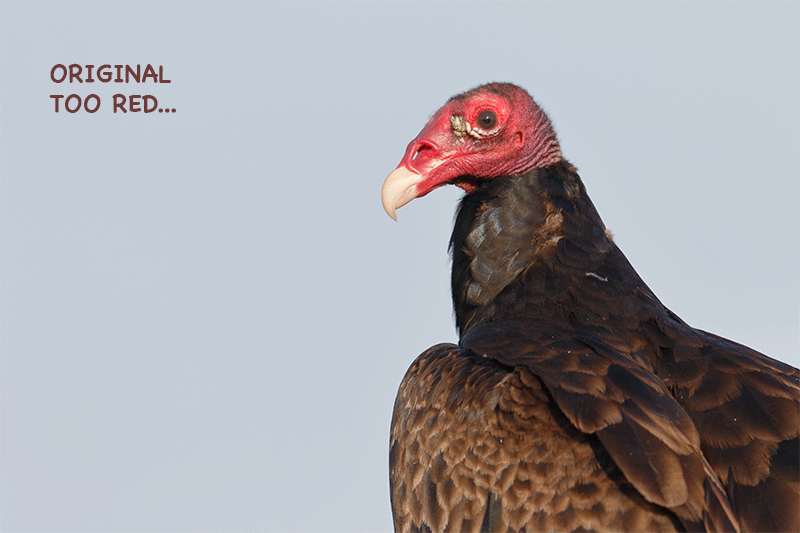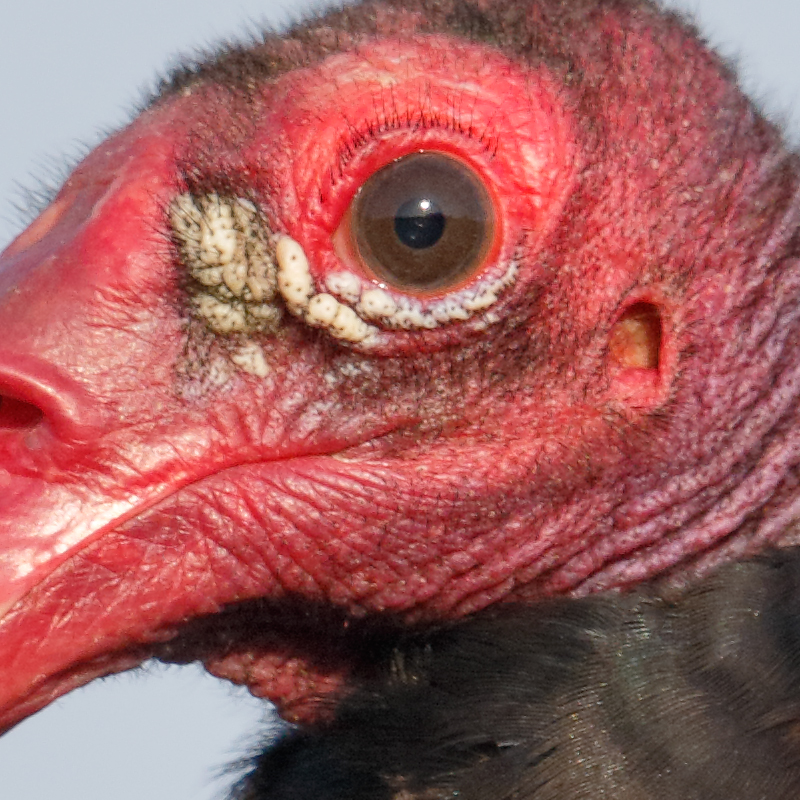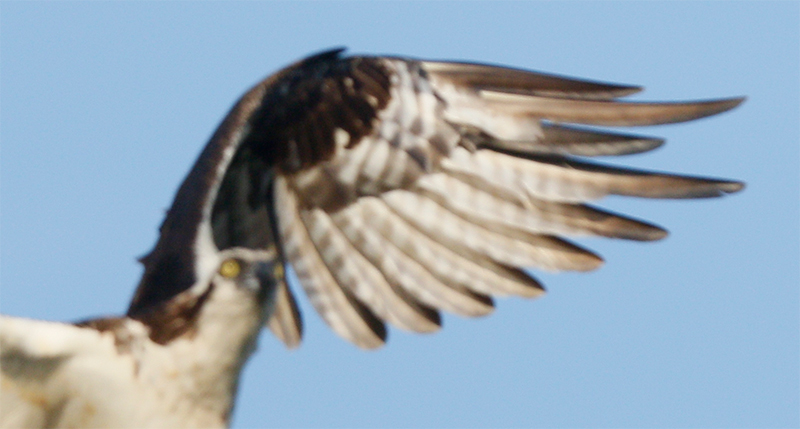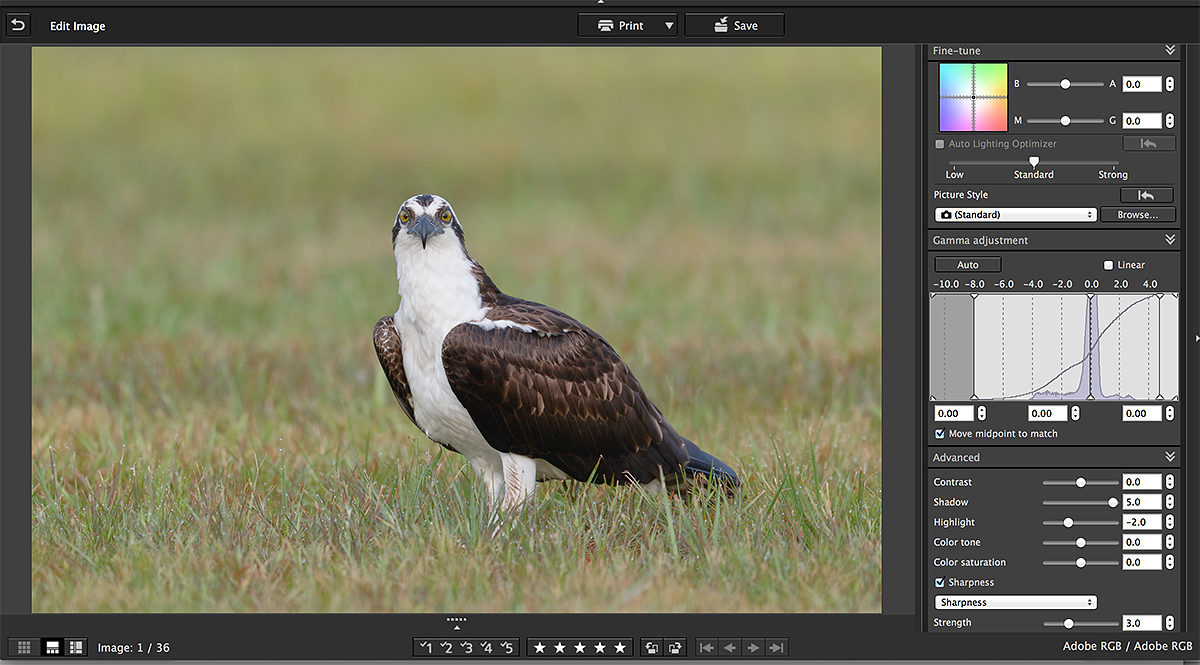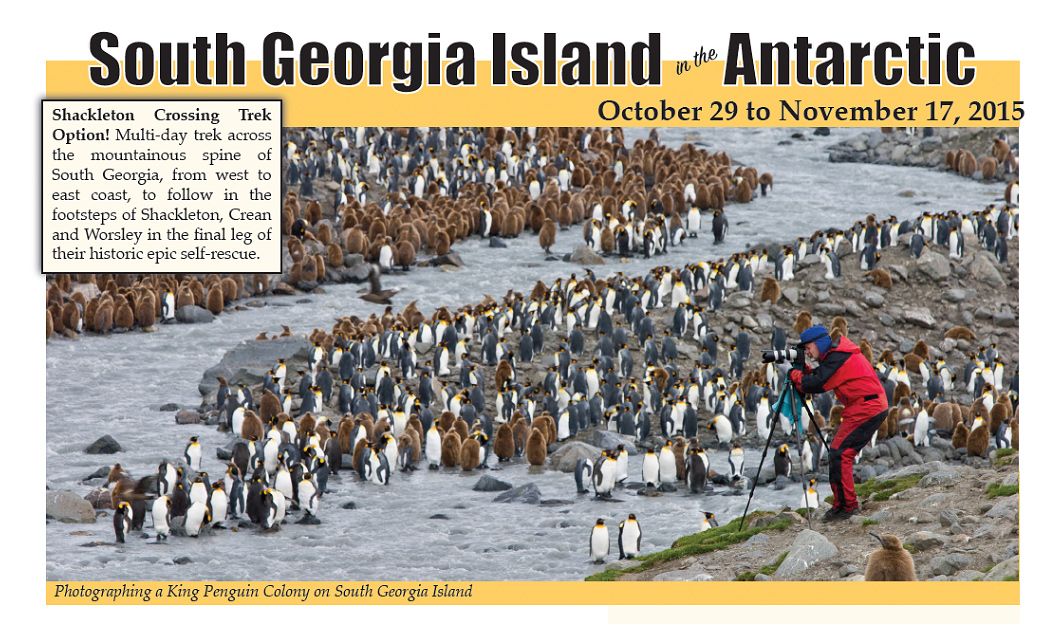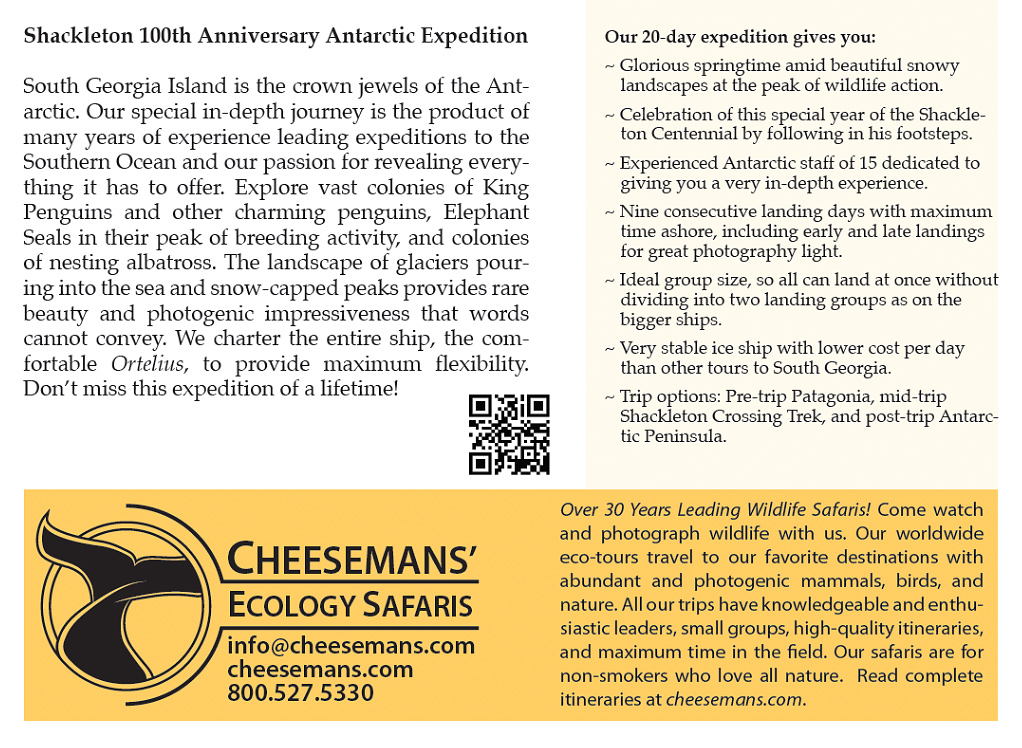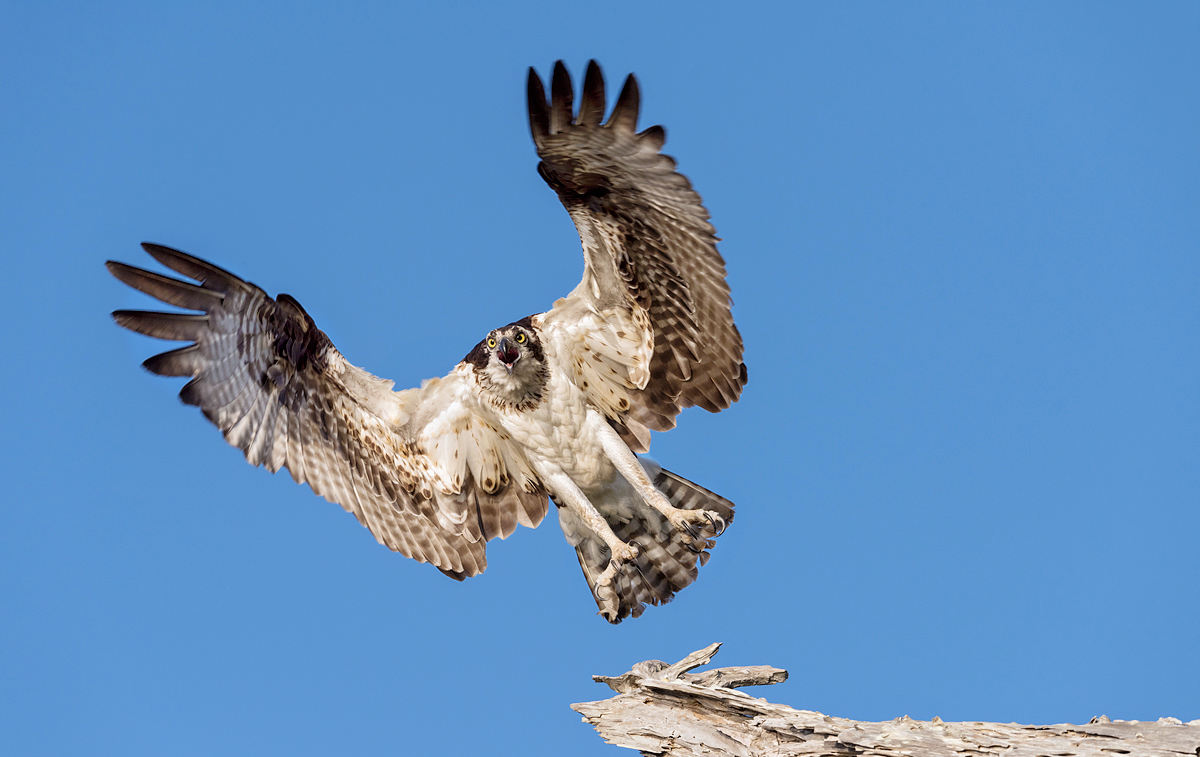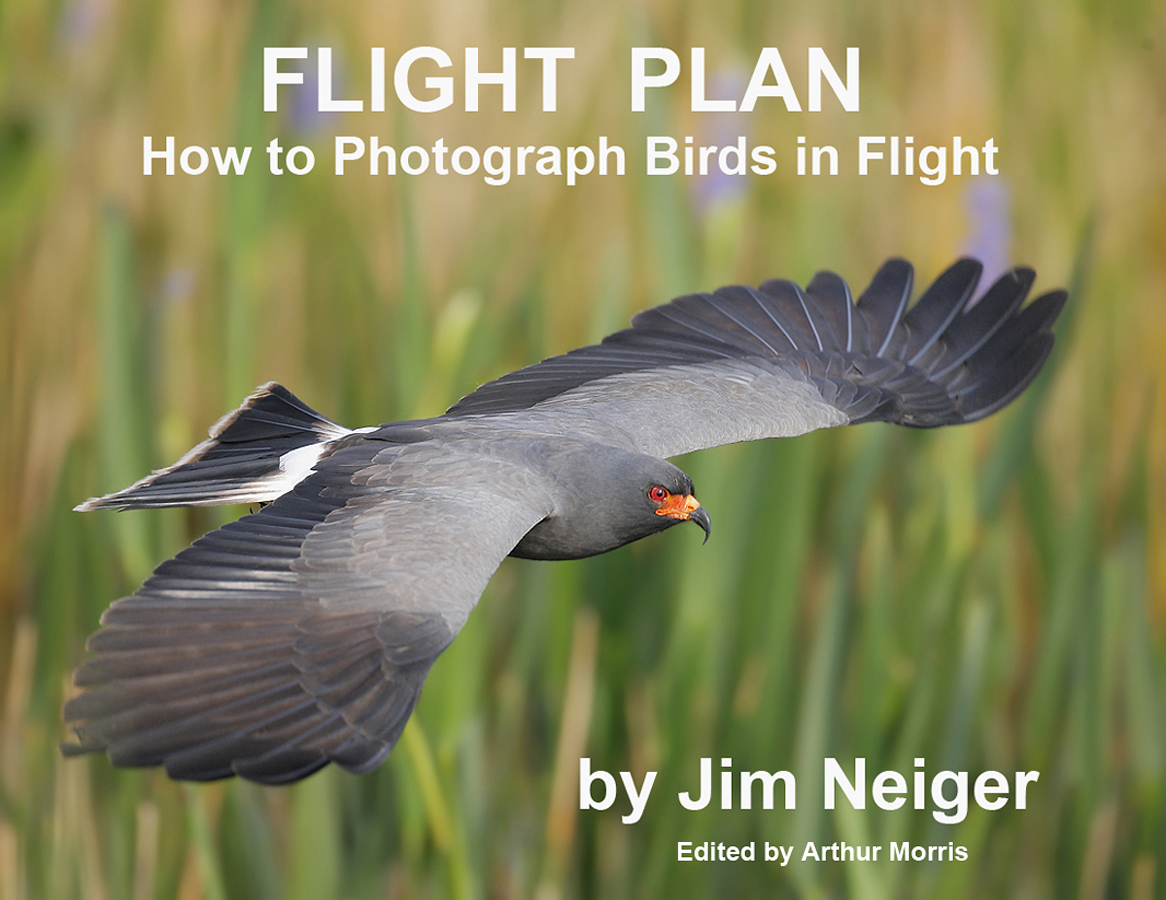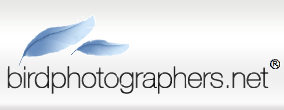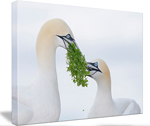April 21st, 2015 Stuff
Honest. I would have gotten up early and went out photographing on Tuesday but for the crappy weather forecast (that for a change happened to be quite accurate).
Tuesday morning involved more relaxing while creating this blog post and watching Golden State win a tough game against the New Orleans Pelicans. Then my core exercises.
This blog post, the 104th in a row, took about 2 1/2 hours to prepare. It was published at about 3:40am on Wednesday. I got up at oh-dark-hundred to make my 6:40am flight from ISP to MCO. If everything goes as expected Jim will be picking me up at about 9:45am on Wednesday morning.
St. Augustine IPT Late Registration Discount Info
Please see below and/or call the office at 863-692-0906 for St. Augustine IPT Late Registration Discount info.


Canon’s Huge Megapixel Bodies
Canon’s two new huge megapixel bodies are available for pre-order. If you want to get your hands on one, please pre-order by clicking on the logo-link above. They will surely be difficult to get; shoot me your B&H receipt via e-mail and I will be glad to do my best to expedite your order. Learn more about the two new bodies here.
Please Remember to use our Affiliate Links 🙂
To show your appreciation for my continuing efforts here, we ask, as always, that you use our the B&H and Amazon affiliate links on the right side of the blog for all of your purchases. B&H is recommended for you major photography gear purchases, Amazon for your household, entertainment, and general purpose stuff. Please check the availability of all photographic accessories in the BIRDS AS ART Online Store, especially the Mongoose M3.6 tripod heads, Gitzo tripods, Wimberley heads and plates, LensCoats and accessories, and the like. We sell only what I have used, have tested, and can depend on. We will not sell you junk. We know what you need to make creating great images easy and fun. And we are always glad to answer your gear questions via e-mail. I just learned that my account was suspended during my absence; it should be up and running by Monday at the latest.
I would of course appreciate your using our B&H affiliate links for all of your major gear, video, and electronic purchases. For the photographic stuff mentioned in the paragraph above we, meaning BAA, would of course greatly appreciate your business. Here is a huge thank you to the many who have been using our links on a regular basis and visiting the BAA Online store as well.
|
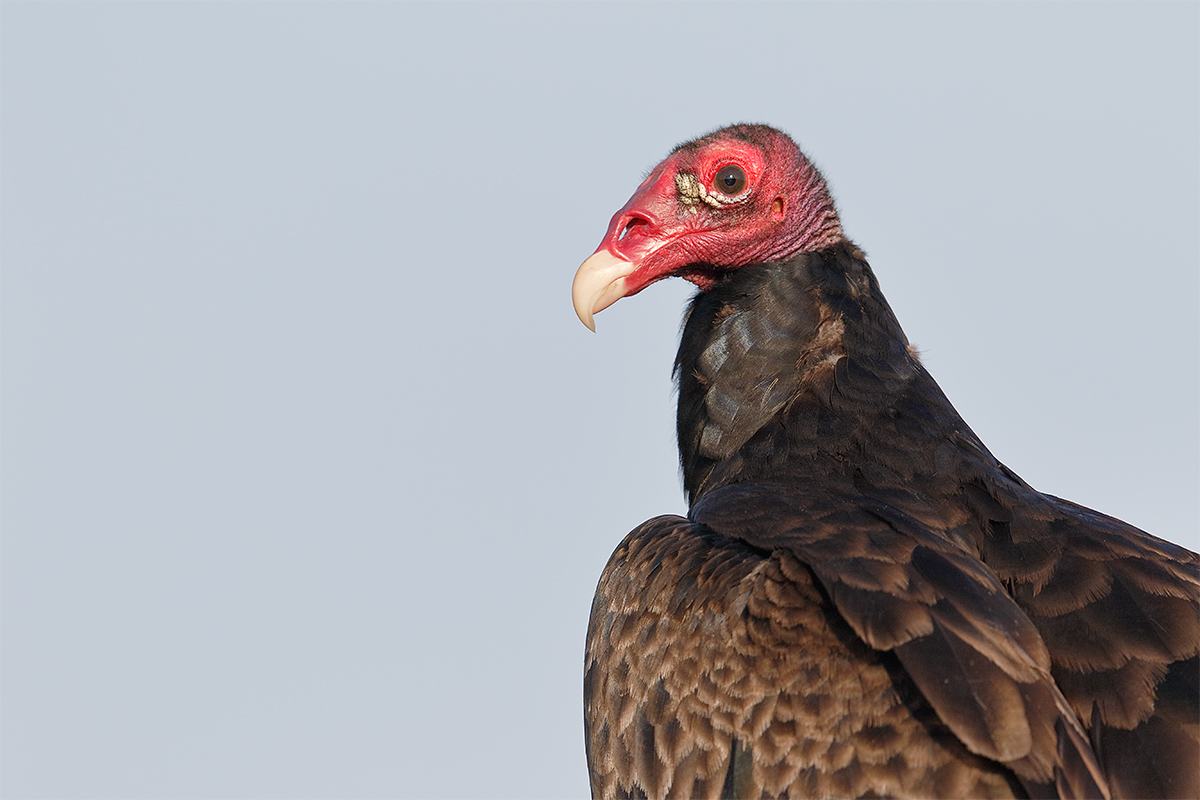
|
|
This image was created down by the lake at ILE on the morning of April 16, 2015 from my SUV with the BLUBB-supported Canon EF 600mm f/4L IS II USM lens, the Canon Extender EF 1.4X III, and the Canon EOS 7D Mark II. ISO 400. Evaluative metering +1/3 stop as framed: 1/1250 sec. at f/6.3 in Manual mode. AWB. At +2/3 in early morning light I was getting a few blinkies on the bill tip so I went 1/3 stop darker.
One AF point above and one to the right of the center AF point/AI Servo Expand/Rear Focus AF as framed was active at the moment of exposure (as is always best if possible when working off the BLUBB). The active AF point was on the bird’s neck just below and forward of the bird’s eye. This put the active AF point right on the same plane as the bird’s eye. Click here to see the latest version of the Rear Focus Tutorial. Click on the image to see a larger version.
|
Down By the Lake
When I was home, I was getting down to the lake pretty regularly each morning. I fly home on Wednesday morning and will get to sleep in my own bed for just one night as I head over to St. Pete on Thursday for the long sold out Fort DeSoto IPT. I hope to get down to the lake again on Thursday morning as last Thursday is was pretty good. And, I found a new, very pretty crane nest that I want to check out. I am hoping that it is a viable nest.
One to One (1:1) 100% Crop Tutorial by Michael Tapes with Arthur Morris
Michael Tapes of LensAlign has visited twice recently helping me out with micro-adjusting some of my gear. With his help I will be creating a written tutorial that will detail the use of LensAlign and a new version of FocusTune to be released early this summer. This tutorial will be for serious photographers who want to get the most out of their gear in terms of sharpness. I must admit to having been intrigued by FocusTune early on as it can really open your eyes about all things AF. And most importantly, It will enable you to set up all of your camera lens combinations so that you will on average be creating the absolute sharpest images possible
I have assembled nearly all the gear that I need to do the micro-adjusting to perfection; right now I am only lacking a cable release.
In any case, on his last visit I mentioned my confusion with creating 1:1 or 100% crops when I needed to show folks how sharp or how unsharp a given image is. He opened my eyes to the fact that I had been doing most everything wrong. Most notably, he explained that the percentage view had nothing at all to do with creating a 1:1 crop, a fact that I had been happily oblivious to before his last visit. In other words, if you view an image a 200% and then simply use the Crop Tool the resulting JPEG will be comprised of re-sampled (read “mangled”) pixels.
Here is how Michael taught me to do it.
1: Bring either your converted TIFF or your optimized image file into Photoshop. Using a previously un-cropped image will give you the truest representation of the sharpness of the file.
2-Activate the Rectangular Marquee Tool.
3-In the Style box select Fixed Size from the drop-down menu.
4-Type in the size in pixels that you want your JPEG to be. For today’s image I went with Width: 800 px and Height: 800 px. Note that if you use larger values (like 1200 X 1200) you will have a wider view. With smaller values (like 400 X 400) you will have a much tighter view. But no matter, you will be looking at a 1:1 representation.
5-Now click anywhere on the image and your 1:1 crop symbol will appear. Grab the crop symbol with the cursor and position it as desired.
6-To execute the crop go Image > Crop. (I use my personal keyboard shortcut, Command C.)
7-Optional: hit Command D to lose the marching ants.
8-Then go File > Save for Web (or hit Shift + Alternate + Command + S). It is mandatory that you save the JPEG at Quality 100%.
9-Hit OK and you are done.
For most accurate viewing it is best to display the final image at its pixel dimensions. In this case that would be 800 X 800 px.
Many thanks to Michael Tapes for his help with these concepts that were previously confusing to me. More on LensAlign, the new ruler, and the next version of FocusTune some time in June.
The Image Optimization
The primary challenge in optimizing this image involved deal with the RED color cast that was due to the quality of the early morning light. To restore detail to the Turkey Vulture’s red head I selected it with the Quick Selection Tool and then added 35 points of CYAN to the REDs in Selective Color. Next I selected all the BLACK feathers, again with the Quick Selection Tool and then went to Hue-Saturation, chose the RED channel, and reduced the RED saturation about 30 points. As a result of these two steps, the light still looked sweet but the color looked far more natural.
Next was clean-up of the face and the feathers with my favorite cast of friends, the Spot Healing Brush (J), the Clone Stamp Tool (S), a small Quick Mask or two, and the Patch Tool (my personalized keyboard shortcut P). I applied a 50% layer of my NIK 50-50 pre-set and refined that with a Regular Layer Mask. I varied the opacity of the brush to leave the full effect on the face and bill tip but reduced it substantially on the black feathers.
Digital Basics
Everything that I did to optimize today’s image is covered in detail in our Digital Basics File–written in my easy-to-follow, easy-to-understand style. Are you tired of making your images look worse in Photoshop? Digital Basics File is an instructional PDF that is sent via e-mail. It includes my complete digital workflow, dozens of great Photoshop tips, details on using all of my image clean-up tools, the use of Contrast Masks, several different ways of expanding and filling in canvas, all of my time-saving Keyboard Shortcuts, Quick Masking, Layer Masking, and NIK Color Efex Pro basics, Contrast Masks, Digital Eye Doctor techniques, using Gaussian Blurs, Tim Grey Dodge and Burn, a variety of ways to make selections, how to create time-saving actions, the Surface Blur (background noise reduction) settings, and tons more.
APTATS I & II
Learn the details of advanced Quick Masking techniques in APTATS I. Learn Advanced Layer Masking Techniques in APTATS II. Mention this blog post and apply a $5 discount to either with phone orders only. Buy both APTATS I and APTATS II and we will be glad to apply at $15 discount either with phone orders or here in the BAA Online Store. For phone orders, call Jim or Jennifer at 863-692-0906 weekdays.
|
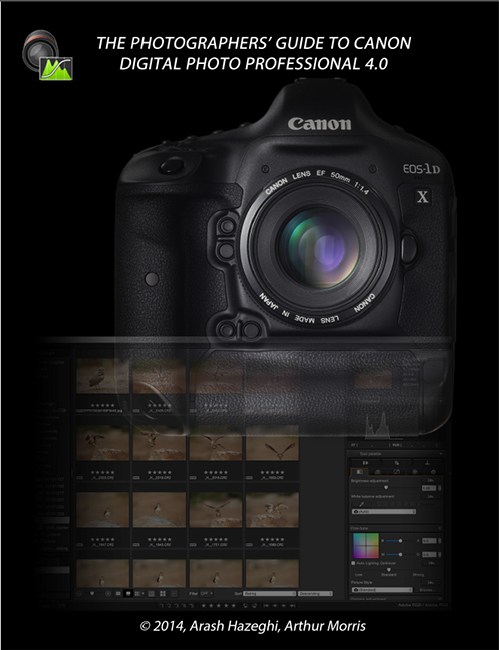
|
|
You can order your copy of “The Photographers’ Guide to Canon Digital Photo Professional 4.0” (aka the DPP 4 Raw Conversion eGuide) by Arash Hazeghi and Arthur Morris by clicking here.
|
The DPP 4 eGuide (PDF)
Learn how and why I and many other discerning photographers choose and use only DPP 4 to convert their Canon RAW files in the DPP 4 RAW Conversion Guide by Arash Hazeghi and yours truly. The latest version supports all of the newer Canon camera bodies and several older models including the EOS-7D and the EOS-1D Mark IV. A free update that will cover most of the newly added cameras will be sent as soon as I get it from Arash.
|
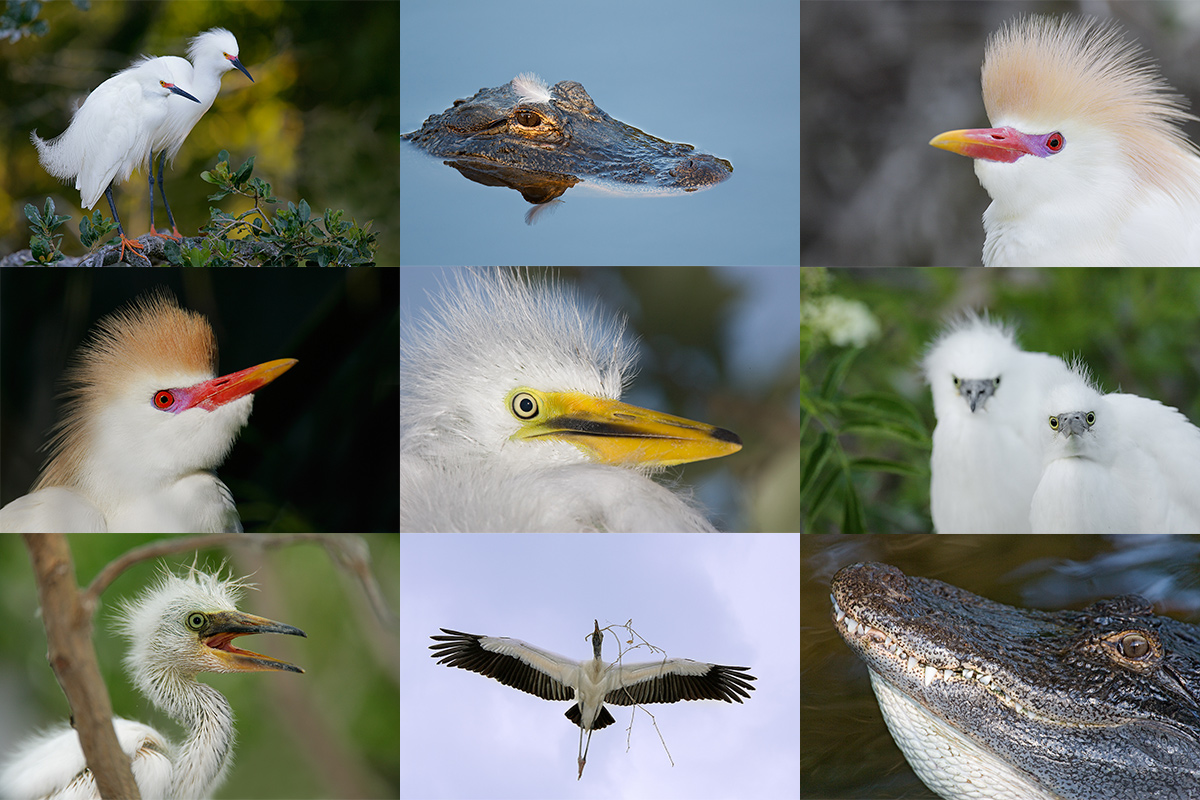
|
|
Clockwise from upper left to center: Snowy Egrets/breeding plumage pair, American Alligator with egret feather on head, Cattle Egret in breeding plumage (with fill flash), large Snowy Egret chicks, displaying gator, Wood Stork in flight carrying nesting material (fill flash), begging Snowy Egret chick, another Cattle Egret in breeding plumage (with fill flash), and Great Egret chick.
|
St. Augustine Alligator Farm Short-Notice Spoonbill and Wading Bird Chicks IPT: May 4-6, 2015. TWO FULL and TWO 1/2 DAYS: $1099. Limit 8/Openings 5.
Call on Monday to learn of the Late Registration Discount: 863-692-0906
St. Augustine in early May is a bird photographer’s paradise. With any luck we should have chicks of all sizes in the nests ranging from newly hatched Snowy Egrets and Tricolored Herons to nearly fledged Great Egrets. More than a few pairs of Roseate Spoonbills have nested at the Alligator Farm for the past several years. Photographing the spoonbill chicks in the nest is a huge challenge…. With any luck we will encounter a few Snowy and Cattle Egrets in stunning breeding plumage. We should have lots of flight photography ops especially late in the day. We will enjoy extra early entry on our three mornings. Folks who will need a photographer’s pass need to get us $89.95. This fee includes full season early entry and late stay and submission fees for up to 5 photos in their annual contest. This works out to cheaper than four separate entry tickets. We pick up the passes on our first afternoon.
|
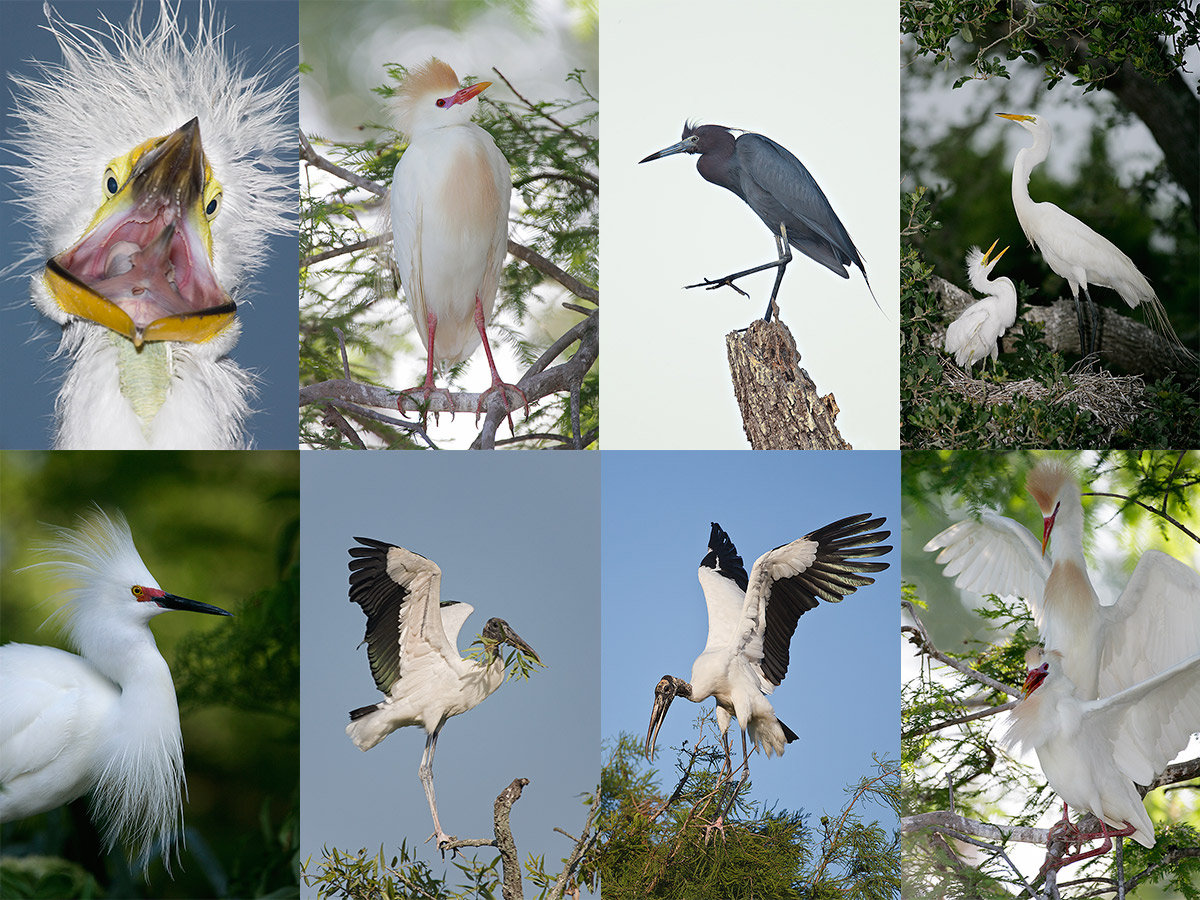
|
|
Clockwise from upper left: flash-as-main light Great Egret chick begging, breeding plumage Cattle Egret w/fill flash, Little Blue Heron, Great Egret chick in nest begging, Cattle Egrets copulating, Wood Stork with nesting material, another Wood Stork with nesting material, and breeding plumage Snowy Egret displaying.
|
What You Will Learn
On this IPT you will the learn the basics and fine points of digital exposure and how to get the right exposure every time after making a single test exposure. You will learn to understand and predict bird behavior and to see and understand the light. You will learn to design pleasing images by mastering your camera’s AF system and how and why to work in Manual mode (even if you’re scared of it). Most importantly, you will learn to spot the good situations, to choose the best perspective. Rookeries are crowded, cluttered, white-washed places. Most folks who visit have no clue as to the difference of an image with tons of distractions and one with a clean line of sight and the best possible distant background. Join me and I will teach you to see like a pro.
I will be bringing my flash to the Alligator Farm (gasp!) I have not used flash for at least a year. I will be teaching you how to use flash as fill and how to use flash as main light. In addition, I will be reviewing the flash flight techniques that I developed at St. Augustine more than a few years ago.
|
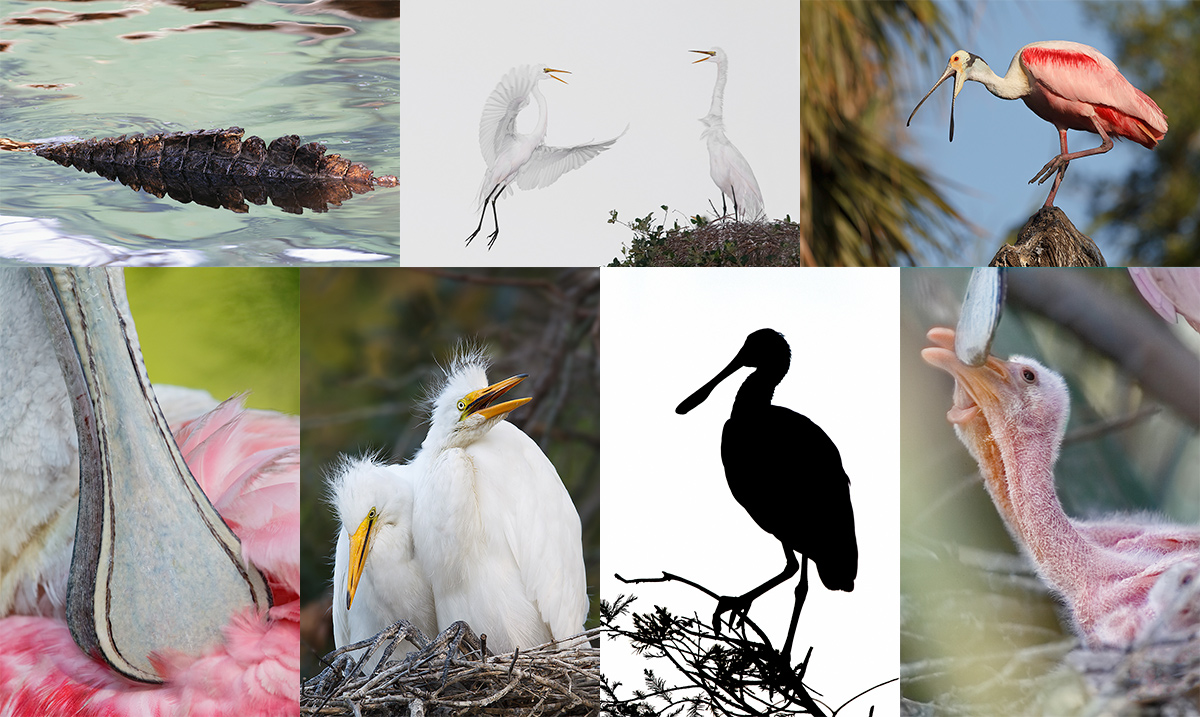
|
|
Clockwise from upper left: gator back, Great Egret returning to mate (with fill flash), Roseate Spoonbill with bill open, Roseate Spoonbill chick begging, Roseate Spoonbill 11am silhouette, large Great Egret chicks in nest, and bill of Roseate Spoonbill.
|
Whats the Rest of the Deal?
Afternoon session on Monday, May 4. Then two full days with a morning and afternoon session each day, May 5 & 6. Then our last morning on May 7. At lunch on Tuesday and Wednesday (included) we will review my images; folks learn a ton watching me edit–why keep this one and delete that one? If you opt to bring your laptop, we can take a look at five of your best images from the morning or another session. We will process a few of my images in Photoshop after converting them in DPP. That followed by Instructor Nap Time.
A $499 non-refundable deposit is required to hold your spot. Your balance–$600, payable only by check, is due immediately. Please include a separate check for $89.95 so that we can purchase your pass in advance. Please click here to read our cancellation policy before committing. Then please print, read, and sign the necessary paperwork linked to here and get it to us. You can register by calling Jim or Jen at the office at 863-692-0906 and arranging for your deposit of $499. Balances are payable only by check. I hope to see you there.
From Pat and Stokes Fishburne
The Alligator Farm is quite good right now. Good spoonbill nests and lots of spoonbills. Also, Snowy Egrets, Tricolored Herons, and a few Cattle Egrets along with more than a few Great Egret nests with chicks.
Facebook
Be sure to like and follow BAA on Facebook by clicking on the logo link upper right. Tanks a stack!
Support the BAA Blog. Support the BAA Bulletins: Shop B&H here!
We want and need to keep providing you with the latest free information, photography and Photoshop lessons, and all manner of related information. Show your appreciation by making your purchases immediately after clicking on any of our B&H or Amazon Affiliate links in this blog post. Remember, B&H ain’t just photography!
…..
Amazon.com
Those who prefer to support BAA by shopping with Amazon may use this link:
Amazon Canada
Many kind folks from north of the border, eh, have e-mailed stating that they would love to help us out by using one of our affiliate links but that living in Canada and doing so presents numerous problems. Now, they can help us out by using our Amazon Canada affiliate link by starting their searches by clicking here. Many thanks to those who have written.
Typos
In all blog posts and Bulletins, feel free to e-mail or to leave a comment regarding any typos or errors. Just be right :).
April 21st, 2015 Stuff
Monday was another relaxing day. Am I losing it??? This blog post, the 103rd in a row, took about 1 1/2 hours to prepare. It should be published at one minute after midnight on Tuesday. Please call the office at 863-692-0906 for St. Augustine IPT Late Registration Discount info.


Canon’s Huge Megapixel Bodies
Canon’s two new huge megapixel bodies are available for pre-order. If you want to get your hands on one, please pre-order by clicking on the logo-link above. They will surely be difficult to get; shoot me your B&H receipt via e-mail and I will be glad to do my best to expedite your order. Learn more about the two new bodies here.
Please Remember to use our Affiliate Links 🙂
To show your appreciation for my continuing efforts here, we ask, as always, that you use our the B&H and Amazon affiliate links on the right side of the blog for all of your purchases. B&H is recommended for you major photography gear purchases, Amazon for your household, entertainment, and general purpose stuff. Please check the availability of all photographic accessories in the BIRDS AS ART Online Store, especially the Mongoose M3.6 tripod heads, Gitzo tripods, Wimberley heads and plates, LensCoats and accessories, and the like. We sell only what I have used, have tested, and can depend on. We will not sell you junk. We know what you need to make creating great images easy and fun. And we are always glad to answer your gear questions via e-mail. I just learned that my account was suspended during my absence; it should be up and running by Monday at the latest.
I would of course appreciate your using our B&H affiliate links for all of your major gear, video, and electronic purchases. For the photographic stuff mentioned in the paragraph above we, meaning BAA, would of course greatly appreciate your business. Here is a huge thank you to the many who have been using our links on a regular basis and visiting the BAA Online store as well.
artie on Lightroom
Aside from what I understand to be superb key wording and search features, I cannot understand why anyone would use Lightroom. From the first day that I ever heard the word Lightroom, I have been hearing things like “I can’t find my images. Lightroom destroyed my Library.” And I still hear those comments to this day. I know that lots of folks use and love Lightroom (LR). And I am fine with that. If it ain’t broke, don’t fix it. Especially if you have unlimited time waiting for your images to “render” so that you can pick your keepers from a folder with 1437 photo files.
Note: in today’s climate, where it is nearly impossible for most folks to sell images, LR’s key-wording features are not nearly as important as they were ten years ago. Furthermore, though I am not familiar with them at present, Photo Mechanic haas some pretty snazzy cataloging, keywording, and search features.
And always I ask, “What can LR do that I cannot do in Photoshop?” I have never gotten a good answer to that one. All are invited to chime in.
denise on Lightroom
As I knew that denise Ippolito had used Lightroom for several years when she began photography, I asked her to share her thoughts on LR. Here is what she said: “I liked it because of the cataloguing. But for viewing your images it was and still is way too slow. Once you introduced me to BreezeBrowser (BrBr) and Downloader Pro (DLP) there was no reason to use Lightroom anymore. BrBr is much faster.” Denise works on PCs.
A Lightroom Conversation with BAA Blog Subscriber John Patton via e-Mail
AM: Hi John, re:
JP: Thanks for the fast response. That is much appreciated.
AM: YAW.
JP: The problems I’ve had with Lightroom are many. They include missing images, EXIF data changing seemingly by itself, and cumbersome file renaming; I live in Vero and photograph a lot of birds.
AM: Ah, we are practically neighbors.
JP: When I rename osprey for example, I need to highlight every one of the osprey files and rename them from the first file to the last. After a good day at Vierra Wetlands it can take more than an hour to go through all the files… And I get somewhat cryptic warnings when moving a file from Lightroom to Photoshop and back.
AM: That sounds like insanity to me unless you are doing something seriously wrong. Even then, it would be nice if the program were somewhat intuitive. Folks should not need a degree in nuclear physics in order to work with their images.
JP: The healing brush works much better in Photoshop than in Lightroom, but others disagree. Tech support from Adobe has been great but I shouldn’t need to call them as often as I do.
AM: Denise agrees with you on the LR healing brush. Agree on calling tech support. I called PM tech support once or twice to get started and they were great.
JP: Before I started using Lightroom I asked why I should and was told it was faster and easier to import, catalog and add keywords than any other program for a Mac. Prior to that I was happily using Bridge and Photoshop.
AM: Photo Mechanic is blazingly fast. If you select the first file in a folder, hit the space bar to see the image large, and hold down the right arrow key it is like watching a movie. BreezeBrowser is fast, but PM has no equal for speed. Of course even I do not edit at full speed :). If you decide to purchase, remember to contact Jim to learn the BAA discount price. We are not permitted to advertise that.
Your Take on LR?
If you own, use, or have used Lightroom we would love to hear your opinion. I would especially love to hear what (aside from the keywording etc.) LR can do that Photoshop cannot do. If you love LR, do let us know what you consider the strong points to be. If you hate it, please be specific as to why.
If you would like to cut the time you spend editing your image files (selecting your keepers) by 80% or more, try Photo Mechanic. You can download a free trial version here. If you love it–no doubt that you will, please remember to call or e-mail Jim or Jennifer and save a few bucks by purchasing your license from BIRDS AS ART. Thanks for that
|

|
|
You can purchase a copy of Photo Mechanic in the BIRDS AS ART Online Store here. Be sure to e-mail Jim or to call as below for discount info.
|
Photo Mechanic
Learn lots more about how I use PM here. Purchase Photo Mechanic from BIRDS AS ART and your license code will be sent to you via e-mail within 1-7 business days (usually within 1-3 business days). Your copy of Photo Mechanic will be delivered to you via electronic download from the manufacturer’s website.
Best News
Folks who subscribe to the blog can call Jim or Jennifer at 863-692-0906 weekdays before 2pm to receive a small PM discount. Or, if they wish to purchase Photo Mechanic in the BIRDS AS ART Online Store here, they can e-mail Jim for a discount code.
Integrating Photo Mechanic and Digital Photo Professional 4 (PM & DPP 4)
An e-Mail Conversation with Bill Hill
BH: One more thing if you have time. In your workflow, you “ingest” the files in Mechanic and then do you open the file in DPP4 for edit and transfer to Photoshop?
AM: Bill, please go back and read what I wrote here.
You gotta read what I wrote here. Actually, I will save you some time; here is the important stuff:
Photo Mechanic Editing (Picking Your Keepers) Tips
I set the default so that the images are arranged by Capture Time when I open a folder. Before you sit down to your first PM editing session be sure to go to Preferences > Preview and then–under “Automatically advance to the next photo when:”– uncheck the “tag is changed box.” That way when you tag a keeper it does not automatically advance to the next frame. You need to do that only once.
I view my images in Photo Mechanic by simply selecting the first image in the folder and then hitting the spacebar to enlarge the image. After that, I hit the right arrow key to advance to the next slide. I hit letter “T” to tag my keepers. You can hit “T” again if you change your mind; this untags the image. When I am done editing the folder I set Filter view by to Untagged. Then I hit Command A (select all) and Command delete to delete all the rejected images. Done deal.
Here’s the best part: the folder in DPP will update automatically when you delete the rejects in PM. Then I go to DPP—both programs are open all the time–and do my RAW conversions for selected files.
To summarize, I Ingest and pick my keepers using Photo Mechanic and then convert my RAW files in DPP (Shift + Command + P). Fast and smooth. Again, the folder structures and the contents of each folder will be identical without your having to lift a finger. No libraries. No importing. No exporting. In other words, a piece of cake. With the icing.
For more than a decade I have been saying “If you are on a PC and are not using BreezeBrowser and Downloader Pro to download and edit your images you are nuts.” To that I can now add, “If you are on a Mac and not using Photo Mechanic to Ingest and edit your image you are nuts. Note: PM works on both PC and Mac platforms.
|
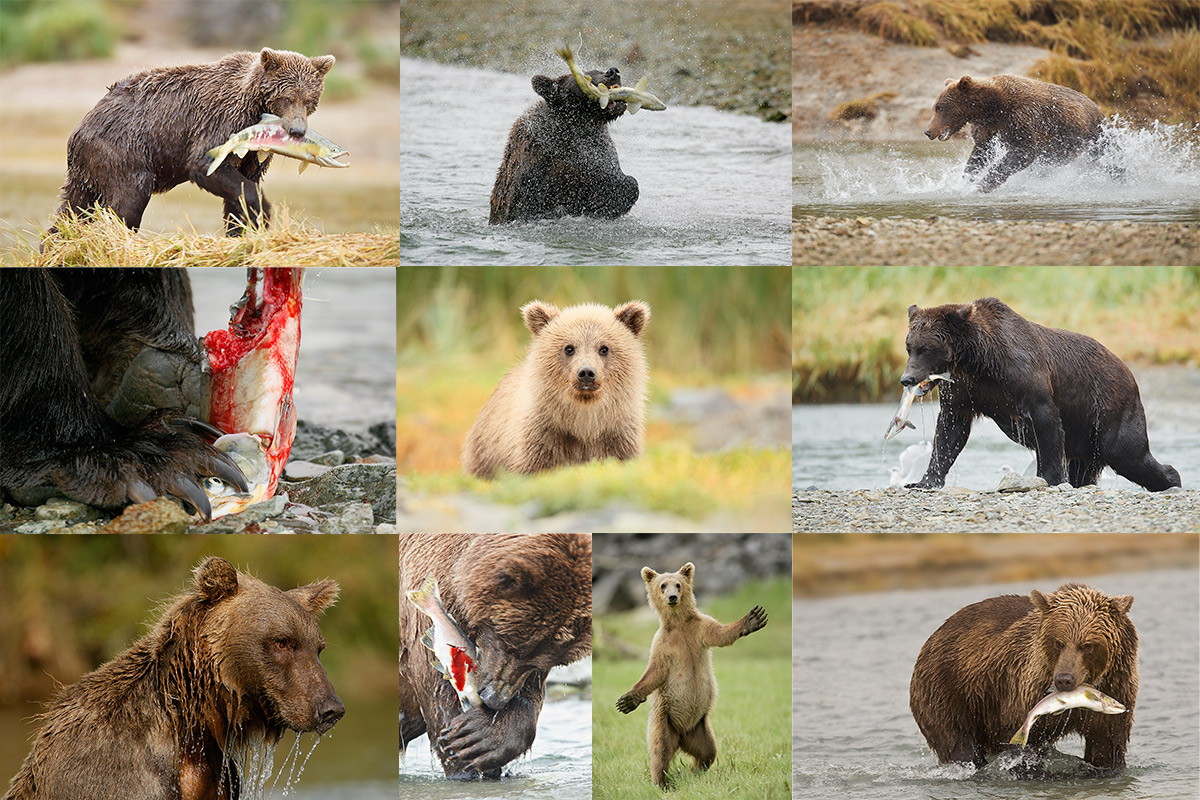
|
|
All of the images in the bear boat card above were created in Katmai National Park during the month of September.
|
Due to a recent cancellation there are once again three slots open.
Bear Boat/Bears Catching Salmon IPT: September 1-8, 2015 from Kodiak, AK/6 FULL & 2 1/2 DAYS: $6699. Happy campers only! Maximum 8/Openings: 3. Plus the leader: Arthur Morris.
Join me in Katmai National Park, AK for seven days of photographing Coastal Brown Bears (grizzlies) catching salmon, fattening up for the long winter. Other subjects will include Mew and Glaucous-winged Gulls in flight and dip-feeding on salmon roe. Did I mention that we live on a boat and that the food is great? Most of our photography will be done in a variety of famed locations: Geographic Harbor, Kinak Bay, and Kukak Bay. We once had 39 bears fishing the creek at Kukak….
It is mandatory that you be in Kodiak no later than the late afternoon of August 31, 2015 September to avoid missing the float planes to the boat on the morning of September 1. With air travel in AK being what it is, with the chance of fog or other bad weather–being on Kodiak on August 30 is an even better plan). I will be on Kodiak on August 30 to avoid any potential disaster. That said in my nearly a dozen bear boat trips I was delayed only once but since I was day early as noted above there was no harm, no foul.
We will take one or more float planes to the boat mid-morning on September 1. We will photograph bears fishing that afternoon and every day for the next six days (weather permitting of course). We should have bears catching salmon every day. In addition, we will get some nice stuff on Mew Gull and Glaucous-winged Gulls dining on roe and the remains of predated salmon. We may–depending on where the concentrations of bears are–get to photograph Harbor seals and some hauled out Steller’s Sea Lions (an endangered species). Halibut fishing (license required) is optional. On September 8, our last morning on the boat, those who would like to enjoy one last photo session will do so. The group returns to Kodiak via float plane midday. Most folks will fly to Anchorage and then continue on red-eye flights to their home cities.
The eight days will consist of six full days (Sept 2, 3, 4, 5, 6, & 7) of photography featuring lots of Coastal Brown Bears catching salmon as above plus a variety of other natural history subjects plus some nice scenic photography that I forgot to mention above. Plus the first afternoon and the last morning.
What’s included? 8 DAYS/7 NIGHTS on the boat as above. All meals on the boat. (The food is quite excellent.) National Park fees. One night’s double occupancy lodging on Kodiak; arrive: Sept 1/depart: Sept 2. The thank-you-in-advance dinner on Sept 1. In-the-field photo tips, instruction, and guidance. An insight into the mind of a top professional; I will constantly let you know what I am thinking, what I am doing, and why I am doing it. Small group image review, image sharing, and Photoshop instruction on the boat.
What’s not included: Your round trip airfare to and from Kodiak, AK (almost surely through Anchorage). All necessary lodging other than the cost of your double occupancy room on the night of August 31 should you opt to arrive early–we can arrange that in advance for you. We will let you know the cost of a single supplement for the one night if so desired. The cost of the round-trip float plane to the boat on September 2 and back to Kodiak on September 9. The cost of a round trip this year was $500. The suggested crew tip of $210.
Is this an expensive trip? Yes, of course. But with 6 full and two half days, a wealth of great subjects, and the fact that you will be walking with the bears just yards away (or less….) it will be one of the great natural history experiences of your life. Most folks who take part in a Bear Boat IPT wind up coming back for more.
A $2,000 per person non-refundable deposit by check only made out to “Arthur Morris” is required to hold your spot. Please click here to read our cancellation policy. Then please print, read, and sign the necessary paperwork here and send it to us.
Your deposit is due immediately. That will leave a balance of $4699. The next payment of $2699 will be due on February 15, 2015. The final payment of $2000 is due on May 1, 2015.
I hope that you can join us for this wondrously exciting trip.
Facebook
Be sure to like and follow BAA on Facebook by clicking on the logo link upper right. Tanks a stack!
Support the BAA Blog. Support the BAA Bulletins: Shop B&H here!
We want and need to keep providing you with the latest free information, photography and Photoshop lessons, and all manner of related information. Show your appreciation by making your purchases immediately after clicking on any of our B&H or Amazon Affiliate links in this blog post. Remember, B&H ain’t just photography!
…..
Amazon.com
Those who prefer to support BAA by shopping with Amazon may use this link:
Amazon Canada
Many kind folks from north of the border, eh, have e-mailed stating that they would love to help us out by using one of our affiliate links but that living in Canada and doing so presents numerous problems. Now, they can help us out by using our Amazon Canada affiliate link by starting their searches by clicking here. Many thanks to those who have written.
Typos
In all blog posts and Bulletins, feel free to e-mail or to leave a comment regarding any typos or errors. Just be right :).
April 20th, 2015 Stuff
Aside from writing this blog post Sunday was a very relaxing day of doing nothing but watching NBA and NHL playoff games…. This blog post, the 102nd in a row, took about 1 1/2 hours to prepare. It should be published at one minute after midnight on Monday. Coming tomorrow: my and your Lightroom Comments….
See below for St. Augustine IPT Late Registration Discount info.


Canon’s Huge Megapixel Bodies
Canon’s two new huge megapixel bodies are available for pre-order. If you want to get your hands on one, please pre-order by clicking on the logo-link above. They will surely be difficult to get; shoot me your B&H receipt via e-mail and I will be glad to do my best to expedite your order. Learn more about the two new bodies here.
Please Remember to use our Affiliate Links 🙂
To show your appreciation for my continuing efforts here, we ask, as always, that you use our the B&H and Amazon affiliate links on the right side of the blog for all of your purchases. B&H is recommended for you major photography gear purchases, Amazon for your household, entertainment, and general purpose stuff. Please check the availability of all photographic accessories in the BIRDS AS ART Online Store, especially the Mongoose M3.6 tripod heads, Gitzo tripods, Wimberley heads and plates, LensCoats and accessories, and the like. We sell only what I have used, have tested, and can depend on. We will not sell you junk. We know what you need to make creating great images easy and fun. And we are always glad to answer your gear questions via e-mail. I just learned that my account was suspended during my absence; it should be up and running by Monday at the latest.
I would of course appreciate your using our B&H affiliate links for all of your major gear, video, and electronic purchases. For the photographic stuff mentioned in the paragraph above we, meaning BAA, would of course greatly appreciate your business. Here is a huge thank you to the many who have been using our links on a regular basis and visiting the BAA Online store as well.
|
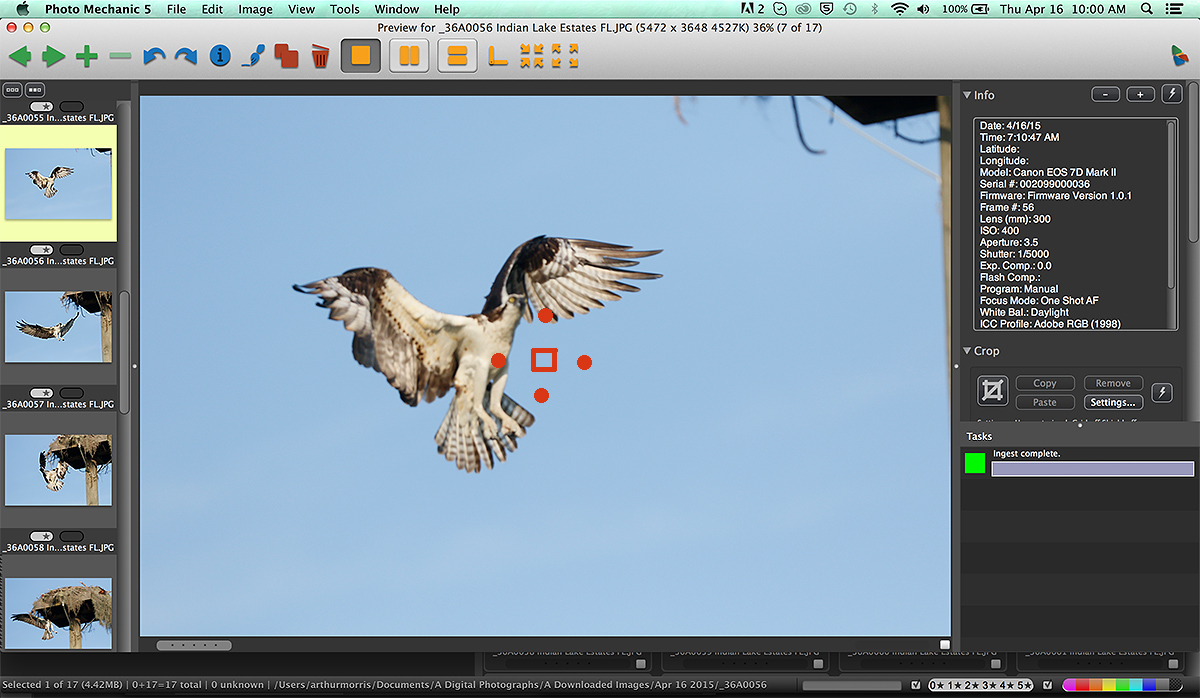
|
|
This image was created down by the lake near my home at Indian Lake Estates, FL with the hand held Canon EF 300mm f/2.8L IS II USM lens and the Canon EOS 7D Mark II. ISO 400. Evaluative metering +2/3 stop off the blue sky: 1/5000 sec. at f/3.5. in Manual mode.
Center AF point/Expand/Shutter Button AF as framed was active at the moment of exposure. Click on the image to see a larger version.
Badly out of focus Osprey
Enlarge the image & note that the EXIF clearly indicates Focus Mode: One-Shot AF; third from the bottom of the visible list.
|
“Lousy Camera or Lousy Photographer?
In the “Lousy Camera or Lousy Photographer?” blog post here, many folks noted that I was in One-Shot AF (Single Servo or AF-S in Nikon). For flight photography, you need to be in AI Servo AF (Continuous or AF-C with Nikon) so that the system can track a moving subject.
And the Answer Is:
Lousy Photographer
AF Primer
When working in in One-Shot AF (Single Servo or AF-S in Nikon) you have press the shutter button (or engage rear focus) to set and lock focus. Both the subject and your rig–the camera and lens–<em>must not move once focus is locked or else the resulting image will not be sharp.
AI Servo AF (Continuous or AF-C with Nikon) was designed to track moving subjects. Not only do these amazing systems track a moving subject but they actually determine the speed and direction of the subject and predict accurate focus at the moment the shutter is released.
Some AF systems offer an AF mode that is designed to switch between the two AF modes when either a still subject or a moving subject is detected. This mode is called AI Focus AF in Canon and AF-A in Nikon. These AF modes rarely works properly. Do not use or depend on them.
My Excuse
My excuse (I do understand that there are never any legitimate excuses in photography :)) is that I had been micro-adjusting that very camera body lens combination with Michael Tapes the day before I went down to the lake and created the badly o-o-f Osprey image. One of the first steps in doing an accurate micro-adjustment with LensAlign/Focus Tune is to set One-Shot AF. Whether I am using Rear Focus or Shutter Button AF I pretty much never use One-Shot AF so I never thought to check that setting….
|
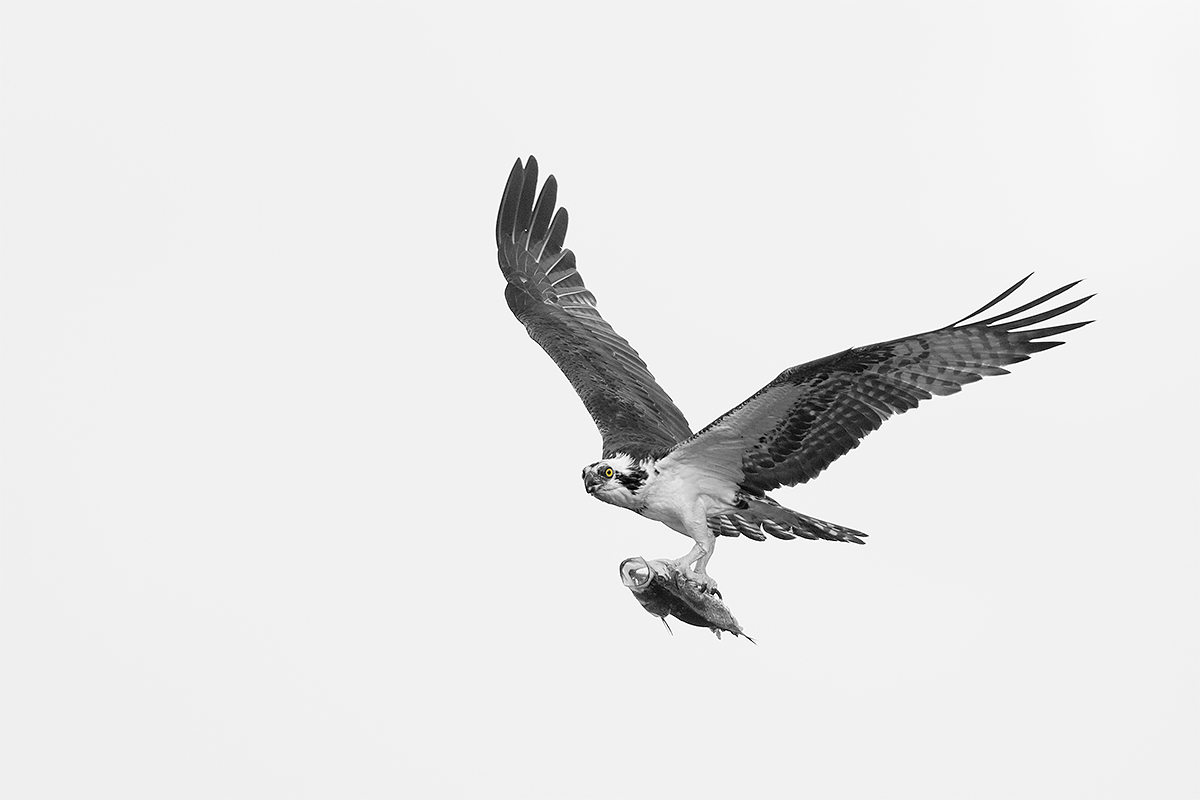
|
|
This image was created Lake Blue Cypress with the hand held Canon EF 300mm f/2.8L IS II USM lens and the Canon EOS 7D Mark II. ISO 400. Evaluative metering +2 2/3 stops off the white sky: 1/2000 sec. at f/2.8.
Center AF point/AI Servo Expand/Shutter Button AF as originally framed was active at the moment of exposure (as is always best for flight photography). The active sensor was on the left side of the bird’s face. Click on the image to see a larger version.
Image #1: Osprey black & white NIK Silver EFEX Pro Neutral
|
Osprey Wing Position Lesson
In the “NIK Silver Efex Pro 2 Osprey” blog post here, I asked, “Which wing position is far less than ideal, the near wing or the far wing? What would have been better?” Two folks left a comment, asked some good questions, and eventually understood that the image would have been a lot stronger if the near-wing had been raised higher with the wings fully up. This would have evened out the exposure, given us a better look at the underwing surface, and added more tension to the image. Good on Deirdre Sheerr-Gross and David Peake for sticking with it. As is often the case, you can learn a ton by reading and following the comments on each blog post.
BTW on the B&W
Of the two versions, I far preferred the Neutral treatment. The High Structure image was overdone for my taste. Several disagreed. How boring would life be if we all thought or liked the same things.
The Big Payoff
Checking Your Camera Settings Before You Start
I do make it a habit of checking my settings before I am in position to start making images. And we teach that on IPTs as well. Here is my mental check list: ISO setting, Shooting Mode, AF Area Selection Mode, selected AF point, Evaluative Metering, rear focus or shutter button AF, White Balance, and Highlight Tone Priority (those last 3 by hitting the Q button). When I do not know what to expect, I will set the ISO according to the light, ISO 400 if it is bright or sunny, or ISO 800 or higher if need be. I usually choose Aperture Priority (at or close to the wide open aperture) so that I am ready for anything simply by dialing in exposure compensation. Once I am in the ballpark I will usually switch to Manual mode. Most recently I have been setting center point Expand shutter button AF. I keep Highlight Tone Priority on. (Do not do that unless you convert your images in DPP 4 as doing so will give you a false sense of security as far as your WHITEs go. Only DPP can read the HTP info.) I set the White Balance to either AUTO or to CLOUDY. As I never use anything but Evaluative Metering the only way I might change that is accidentally but as we have seen here, it never hurts to check. At this point I know my starting points, and if you know where you are in terms of camera settings, you have a much better chance of getting to where you want to be.
Now I just have to remember to add “Make sure to be in AI Servo AF” to my mental checklist.
There is nothing worse than coming upon a great situation and not having a clue as to how your camera is set up so be sure to make it a habit of going through your mental camera check list before you head into the field.
|

|
|
Clockwise from upper left to center: Snowy Egrets/breeding plumage pair, American Alligator with egret feather on head, Cattle Egret in breeding plumage (with fill flash), large Snowy Egret chicks, displaying gator, Wood Stork in flight carrying nesting material (fill flash), begging Snowy Egret chick, another Cattle Egret in breeding plumage (with fill flash), and Great Egret chick.
|
Date Change: St. Augustine Alligator Farm Short-Notice Spoonbill and Wading Bird Chicks IPT: May 4-6, 2015.
St. Augustine Alligator Farm Short-Notice Spoonbill and Wading Bird Chicks IPT: May 4-6, 2015. TWO FULL and TWO 1/2 DAYS: $1099. Limit 8/Openings 5.
Call on Monday to learn of the Late Registration Discount: 863-692-0906
St. Augustine in early May is a bird photographer’s paradise. With any luck we should have chicks of all sizes in the nests ranging from newly hatched Snowy Egrets and Tricolored Herons to nearly fledged Great Egrets. More than a few pairs of Roseate Spoonbills have nested at the Alligator Farm for the past several years. Photographing the spoonbill chicks in the nest is a huge challenge…. With any luck we will encounter a few Snowy and Cattle Egrets in stunning breeding plumage. We should have lots of flight photography ops especially late in the day. We will enjoy extra early entry on our three mornings. Folks who will need a photographer’s pass need to get us $89.95. This fee includes full season early entry and late stay and submission fees for up to 5 photos in their annual contest. This works out to cheaper than four separate entry tickets. We pick up the passes on our first afternoon.
|

|
|
Clockwise from upper left: flash-as-main light Great Egret chick begging, breeding plumage Cattle Egret w/fill flash, Little Blue Heron, Great Egret chick in nest begging, Cattle Egrets copulating, Wood Stork with nesting material, another Wood Stork with nesting material, and breeding plumage Snowy Egret displaying.
|
What You Will Learn
On this IPT you will the learn the basics and fine points of digital exposure and how to get the right exposure every time after making a single test exposure. You will learn to understand and predict bird behavior and to see and understand the light. You will learn to design pleasing images by mastering your camera’s AF system and how and why to work in Manual mode (even if you’re scared of it). Most importantly, you will learn to spot the good situations, to choose the best perspective. Rookeries are crowded, cluttered, white-washed places. Most folks who visit have no clue as to the difference of an image with tons of distractions and one with a clean line of sight and the best possible distant background. Join me and I will teach you to see like a pro.
I will be bringing my flash to the Alligator Farm (gasp!) I have not used flash for at least a year. I will be teaching you how to use flash as fill and how to use flash as main light. In addition, I will be reviewing the flash flight techniques that I developed at St. Augustine more than a few years ago.
|

|
|
Clockwise from upper left: gator back, Great Egret returning to mate (with fill flash), Roseate Spoonbill with bill open, Roseate Spoonbill chick begging, Roseate Spoonbill 11am silhouette, large Great Egret chicks in nest, and bill of Roseate Spoonbill.
|
Whats the Rest of the Deal?
Afternoon session on Monday, May 4. Then two full days with a morning and afternoon session each day, May 5 & 6. Then our last morning on May 7. At lunch on Tuesday and Wednesday (included) we will review my images; folks learn a ton watching me edit–why keep this one and delete that one? If you opt to bring your laptop, we can take a look at five of your best images from the morning or another session. We will process a few of my images in Photoshop after converting them in DPP. That followed by Instructor Nap Time.
A $499 non-refundable deposit is required to hold your spot. Your balance–$600, payable only by check, is due immediately. Please include a separate check for $89.95 so that we can purchase your pass in advance. Please click here to read our cancellation policy before committing. Then please print, read, and sign the necessary paperwork linked to here and get it to us. You can register by calling Jim or Jen at the office at 863-692-0906 and arranging for your deposit of $499. Balances are payable only by check. I hope to see you there.
From Pat and Stokes Fishburne
The Alligator Farm is quite good right now. Good spoonbill nests and lots of spoonbills. Also, Snowy Egrets, Tricolored Herons, and a few Cattle Egrets along with more than a few Great Egret nests with chicks.
Facebook
Be sure to like and follow BAA on Facebook by clicking on the logo link upper right. Tanks a stack!
Support the BAA Blog. Support the BAA Bulletins: Shop B&H here!
We want and need to keep providing you with the latest free information, photography and Photoshop lessons, and all manner of related information. Show your appreciation by making your purchases immediately after clicking on any of our B&H or Amazon Affiliate links in this blog post. Remember, B&H ain’t just photography!
…..
Amazon.com
Those who prefer to support BAA by shopping with Amazon may use this link:
Amazon Canada
Many kind folks from north of the border, eh, have e-mailed stating that they would love to help us out by using one of our affiliate links but that living in Canada and doing so presents numerous problems. Now, they can help us out by using our Amazon Canada affiliate link by starting their searches by clicking here. Many thanks to those who have written.
Typos
In all blog posts and Bulletins, feel free to e-mail or to leave a comment regarding any typos or errors. Just be right :).
April 19th, 2015 Stuff
I sat with my Mom and my younger sister Arna on Saturday afternoon and shared a year’s worth of my travels with them in the form of the optimized photographs from various trip folders. In Photo Mechanic I simply hit 1: Sort by {Type} and displayed the finished images. Two things struck me. First, I realized once again what a truly blessed life I have led. Second, I saw dozens of wonderful images that I have yet to share with you here. I should have color coded those….
Younger daughter Alissa came by with her family for dinner–she did the cooking. As the mother of two autistic boys, I have been saying that Lissy should receive a Nobel Prize for Motherhood every week. Those feelings were reinforced in spades during their visit. She literally is a saint come to earth.
This blog post, the 101st in a row, took less than an hour to prepare. I was and am tired. It should be published at one minute after midnight on Sunday.
7D II or 1D X?
Please take a look back at yesterday’s blog post here and let us know if you think that the crane images were created with the 7D II or the 1D X. Many thanks. Feel free to say “I can’t tell.”


Canon’s Huge Megapixel Bodies
Canon’s two new huge megapixel bodies are available for pre-order. If you want to get your hands on one, please pre-order by clicking on the logo-link above. They will surely be difficult to get; shoot me your B&H receipt via e-mail and I will be glad to do my best to expedite your order. Learn more about the two new bodies here.
Please Remember to use our Affiliate Links 🙂
To show your appreciation for my continuing efforts here, we ask, as always, that you use our the B&H and Amazon affiliate links on the right side of the blog for all of your purchases. B&H is recommended for you major photography gear purchases, Amazon for your household, entertainment, and general purpose stuff. Please check the availability of all photographic accessories in the BIRDS AS ART Online Store, especially the Mongoose M3.6 tripod heads, Gitzo tripods, Wimberley heads and plates, LensCoats and accessories, and the like. We sell only what I have used, have tested, and can depend on. We will not sell you junk. We know what you need to make creating great images easy and fun. And we are always glad to answer your gear questions via e-mail. I just learned that my account was suspended during my absence; it should be up and running by Monday at the latest.
I would of course appreciate your using our B&H affiliate links for all of your major gear, video, and electronic purchases. For the photographic stuff mentioned in the paragraph above we, meaning BAA, would of course greatly appreciate your business. Here is a huge thank you to the many who have been using our links on a regular basis and visiting the BAA Online store as well.
|
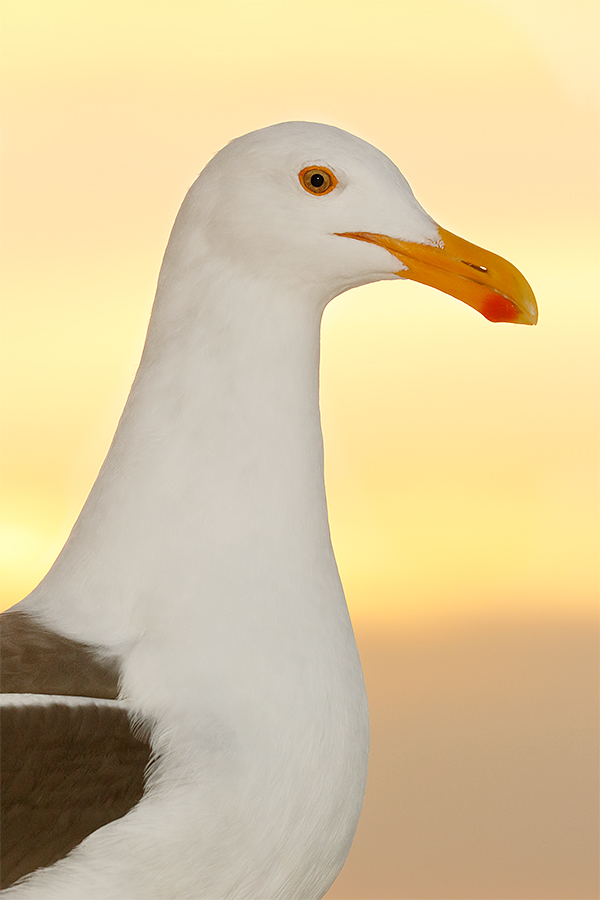
|
|
This image was created at Morro Bay with the hand held Canon EF 100-400mm f/4.5-5.6L IS II USM lens (at 330mm) and the amazing Canon EOS 7D Mark II. ISO 800. Evaluative metering +1 stop: 1/160 sec. at f/11 in Av mode. Pop up flash at 0. K9000 to enhance the sunrise colors.
AI Servo Zone/Rear Focus AF as framed was active at the moment of exposure (as is always best when hand holding). It did a nice job with focus by activating the center AF point and the one below it. Click here to see the latest version of the Rear Focus Tutorial. Click on the image to see a larger version.
Western Gull at dawn
|
7D II Pop Up Flash
I began experimenting with the 7D II’s pop up flash at Morro Bay. If is of course, most useful when you are working at extremely close range. When I was close enough for head shots, I set the flash at from between -1 and -2 stops where it acted like true fill flash. In this situation, with the brightly colored sky as back light, I set the flash at zero knowing that I needed to light the shaded side of the subject. Next time I will try +1 in this situation as I needed to brighten the WHITEs of the gull a bit in Photoshop.
|

|
|
Clockwise from upper left to center: Snowy Egrets/breeding plumage pair, American Alligator with egret feather on head, Cattle Egret in breeding plumage (with fill flash), large Snowy Egret chicks, displaying gator, Wood Stork in flight carrying nesting material (fill flash), begging Snowy Egret chick, another Cattle Egret in breeding plumage (with fill flash), and Great Egret chick.
|
Date Change: St. Augustine Alligator Farm Short-Notice Spoonbill and Wading Bird Chicks IPT: May 4-6, 2015.
St. Augustine Alligator Farm Short-Notice Spoonbill and Wading Bird Chicks IPT: May 4-6, 2015. TWO FULL and TWO 1/2 DAYS: $1099. Limit 8/Openings 5.
Call on Monday to learn of the Late Registration Discount: 863-692-0906
St. Augustine in early May is a bird photographer’s paradise. With any luck we should have chicks of all sizes in the nests ranging from newly hatched Snowy Egrets and Tricolored Herons to nearly fledged Great Egrets. More than a few pairs of Roseate Spoonbills have nested at the Alligator Farm for the past several years. Photographing the spoonbill chicks in the nest is a huge challenge…. With any luck we will encounter a few Snowy and Cattle Egrets in stunning breeding plumage. We should have lots of flight photography ops especially late in the day. We will enjoy extra early entry on our three mornings. Folks who will need a photographer’s pass need to get us $89.95. This fee includes full season early entry and late stay and submission fees for up to 5 photos in their annual contest. This works out to cheaper than four separate entry tickets. We pick up the passes on our first afternoon.
|

|
|
Clockwise from upper left: flash-as-main light Great Egret chick begging, breeding plumage Cattle Egret w/fill flash, Little Blue Heron, Great Egret chick in nest begging, Cattle Egrets copulating, Wood Stork with nesting material, another Wood Stork with nesting material, and breeding plumage Snowy Egret displaying.
|
What You Will Learn
On this IPT you will the learn the basics and fine points of digital exposure and how to get the right exposure every time after making a single test exposure. You will learn to understand and predict bird behavior and to see and understand the light. You will learn to design pleasing images by mastering your camera’s AF system and how and why to work in Manual mode (even if you’re scared of it). Most importantly, you will learn to spot the good situations, to choose the best perspective. Rookeries are crowded, cluttered, white-washed places. Most folks who visit have no clue as to the difference of an image with tons of distractions and one with a clean line of sight and the best possible distant background. Join me and I will teach you to see like a pro.
I will be bringing my flash to the Alligator Farm (gasp!) I have not used flash for at least a year. I will be teaching you how to use flash as fill and how to use flash as main light. In addition, I will be reviewing the flash flight techniques that I developed at St. Augustine more than a few years ago.
|

|
|
Clockwise from upper left: gator back, Great Egret returning to mate (with fill flash), Roseate Spoonbill with bill open, Roseate Spoonbill chick begging, Roseate Spoonbill 11am silhouette, large Great Egret chicks in nest, and bill of Roseate Spoonbill.
|
Whats the Rest of the Deal?
Afternoon session on Monday, May 4. Then two full days with a morning and afternoon session each day, May 5 & 6. Then our last morning on May 7. At lunch on Tuesday and Wednesday (included) we will review my images; folks learn a ton watching me edit–why keep this one and delete that one? If you opt to bring your laptop, we can take a look at five of your best images from the morning or another session. We will process a few of my images in Photoshop after converting them in DPP. That followed by Instructor Nap Time.
A $499 non-refundable deposit is required to hold your spot. Your balance–$600, payable only by check, is due immediately. Please include a separate check for $89.95 so that we can purchase your pass in advance. Please click here to read our cancellation policy before committing. Then please print, read, and sign the necessary paperwork linked to here and get it to us. You can register by calling Jim or Jen at the office at 863-692-0906 and arranging for your deposit of $499. Balances are payable only by check. I hope to see you there.
From Pat and Stokes Fishburne
The Alligator Farm is quite good right now. Good spoonbill nests and lots of spoonbills. Also, Snowy Egrets, Tricolored Herons, and a few Cattle Egrets along with more than a few Great Egret nests with chicks.
Facebook
Be sure to like and follow BAA on Facebook by clicking on the logo link upper right. Tanks a stack!
Support the BAA Blog. Support the BAA Bulletins: Shop B&H here!
We want and need to keep providing you with the latest free information, photography and Photoshop lessons, and all manner of related information. Show your appreciation by making your purchases immediately after clicking on any of our B&H or Amazon Affiliate links in this blog post. Remember, B&H ain’t just photography!
…..
Amazon.com
Those who prefer to support BAA by shopping with Amazon may use this link:
Amazon Canada
Many kind folks from north of the border, eh, have e-mailed stating that they would love to help us out by using one of our affiliate links but that living in Canada and doing so presents numerous problems. Now, they can help us out by using our Amazon Canada affiliate link by starting their searches by clicking here. Many thanks to those who have written.
Typos
In all blog posts and Bulletins, feel free to e-mail or to leave a comment regarding any typos or errors. Just be right :).
April 18th, 2015 Stuff
I did not start packing until about 7:30am on Friday knowing that Jim and I needed to leave the house at 9:30am to be on time for my acupuncture appointment. Piece of cake. After that he dropped me at Orlando airport for my 3:45 flight to Islip for my surprise visit to me 92-year old Mom. No worries: she never looks at the blog . No swim on Friday. I am hoping to get in my core exercises tonight at Mom’s home on Long Island. Tomorrow I will get to spend some time with my younger daughter Alissa and her family: husband Ajiniyaz and my two younger grandsons, Ilyas and Idris.
This blog post, the 100th in a row, took about 2 1/2 hours to prepare and was published at one minute after midnight on Saturday. Read carefully as there is lots to learn. The great bulk of the work was done at the airport and on the plane.


Canon’s Huge Megapixel Bodies
Canon’s two new huge megapixel bodies are available for pre-order. If you want to get your hands on one, please pre-order by clicking on the logo-link above. They will surely be difficult to get; shoot me your B&H receipt via e-mail and I will be glad to do my best to expedite your order. Learn more about the two new bodies here.
Please Remember to use our Affiliate Links 🙂
To show your appreciation for my continuing efforts here, we ask, as always, that you use our the B&H and Amazon affiliate links on the right side of the blog for all of your purchases. B&H is recommended for you major photography gear purchases, Amazon for your household, entertainment, and general purpose stuff. Please check the availability of all photographic accessories in the BIRDS AS ART Online Store, especially the Mongoose M3.6 tripod heads, Gitzo tripods, Wimberley heads and plates, LensCoats and accessories, and the like. We sell only what I have used, have tested, and can depend on. We will not sell you junk. We know what you need to make creating great images easy and fun. And we are always glad to answer your gear questions via e-mail. I just learned that my account was suspended during my absence; it should be up and running by Monday at the latest.
I would of course appreciate your using our B&H affiliate links for all of your major gear, video, and electronic purchases. For the photographic stuff mentioned in the paragraph above we, meaning BAA, would of course greatly appreciate your business. Here is a huge thank you to the many who have been using our links on a regular basis and visiting the BAA Online store as well.
|
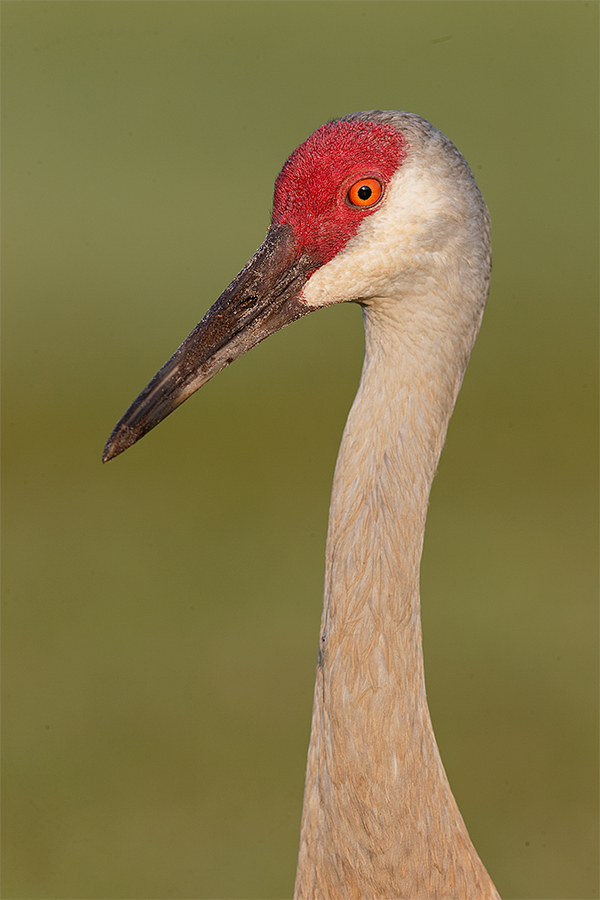
|
|
This image was created down by the lake at ILE on Thursday morning from my SUV with the BLUBB-supported Canon EF 600mm f/4L IS II USM lens and which camera body? ISO 400. Evaluative metering +1/3 stop as framed: 1/400 sec. at f/9 in Av mode was right on the money. AWB.
Center AF point/AI Servo Surround/Shutter Button AF as framed was active at the moment of exposure (as is always best if possible when working off the BLUBB). The selected AF point was just past the end of the bill where the red of the cap met the dirty white of the neck. Click on the image to see a larger version.
Image #1: a sharpened JPEG that represents the optimized TIFF of my favorite from this series.
|
On the Spot Again: Image Quality/Camera Body Quiz #3
Take a look at all three of today’s images. Above is the optimized TIFF of my favorite from the series. Next is a 600 pixel square, 1:1 crop of the crane’s eye from the embedded JPEG of the next image. Last is the a JPEG created from the full frame embedded JPEG that was extracted in Photo Mechanic and viewed in DPP (as was the image that supplied the tight crop of the eye).
Based on image quality, can you tell if today’s images were created with a 1D X or a 7D Mark II? If yes, what led you to your choice? Answers to all three of these quizzes soon. Promise.
The Image Optimization
After converting the image in DPP 4 the image optimization in Photoshop included just a bit of bill and cap cleanup. You can see what I did by taking a close look at the third image and comparing it with the optimized image. I did miss an important part of my workflow in part because I forgot that I was working stooped down to f/9. Wide open was f/4….) What did I forget to do?
|
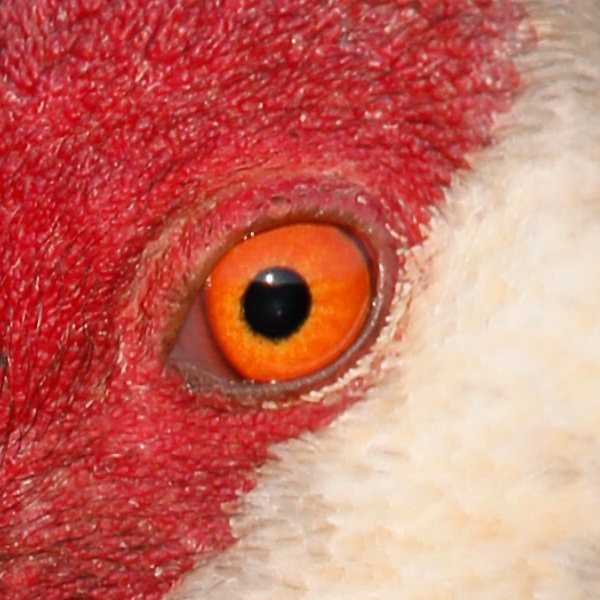
|
Image #2: this is an unsharpened, 600 pixel square, 1:1 crop of the crane’s eye from the embedded JPEG of the next image in the 3-frame sequence.
|
What’s wrong with this image?
In frame 2 of the sequence, the nictitating membrane was just beginning to slide over the eye, moving from our left to our right. Compare with the perfect eye in the optimized image that opened this blog post.
Why Always Three at a Time?
Observant folks who photograph with me on an IPT are usually quick to ask, “Why do you almost always create three images at a time even when photographing a static subject? There are many reasons:
#1: As we see here today, birds often and unexpectedly slide their nictitating membranes over their eyes. These membranes are like a semi-opaque third eyelid. At times, such as when feeding a chick or when receiving or a stick for the nest from their mate, they do this as a form of protection. But often it is a reflex action similar to our blinking. Whatever the cause, most times they will ruin an image.
#2: Even when we see them as being at rest, birds are almost always moving. This often results in one of the three images that you should be creating being slightly sharper than the other two.
#3: As we will see in future posts while learning about LensAlign, Micro-adjusting, and FocusTune, our AF systems are nowhere near as perfect as we assume that they are. Even with AF active at the moment of exposure AF may shift imperceptibly again resulting on one image being slightly sharper than than other images in a sequence. I call this the vagaries of AF. There are many possible causes the most notable of which is lack of strong contrast.
#4: Even when working on the sturdiest tripod with the most rigid tripod head imaginable and employing perfect sharpness techniques there will always be play in your support system that will affect focus. Consider what happens when working off a BLUBB or when hand holding….
Those are the major reasons that I almost always create three images in a given instant. Please do not think that I go about my work firing haphazardly at every bird I see. I look for good situations and when I find one and get set up the way I want, then and only then will I whack it: click, click, click, three at a time. Always. If the bird is still in the same spot, I will refocus and repeat. Always.
No matter how long a series of images is, one image will almost always stand out clearly as best. If you are creating one image at a time you will often be missing the boat. And if you are doing so to save time while editing, you are seriously deluding yourself. Picking your keepers in a great program lIke BreezeBrowser or Photo Mechanic is both fast and painless.
|
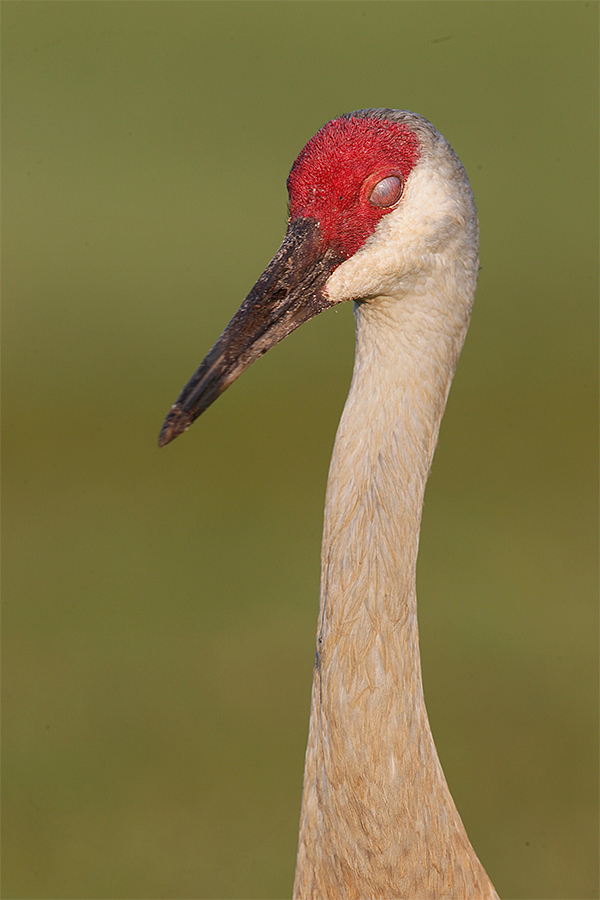
|
Image #3: this is a sharpened, 900 pixel tall crop of embedded JPEG from the third and last image in the sequence.
|
Image Ruined
This image, created in the same one one hundredth of a second as the two images above, is ruined by the fact that the crane’s nictitating membrane is covering its eye. Such images–especially extreme close-ups–can, on occasion, be interesting. In those cases I will optimize the image and add it to the BAA collection for educational purposes. In addition, it might one day fill an editor’s need and result in a sale.
|

|
|
All of the images in the bear boat card above were created in Katmai National Park during the month of September.
|
Due to a recent cancellation there are once again three slots open.
Bear Boat/Bears Catching Salmon IPT: September 1-8, 2015 from Kodiak, AK/6 FULL & 2 1/2 DAYS: $6699. Happy campers only! Maximum 8/Openings: 3. Plus the leader: Arthur Morris.
Join me in Katmai National Park, AK for seven days of photographing Coastal Brown Bears (grizzlies) catching salmon, fattening up for the long winter. Other subjects will include Mew and Glaucous-winged Gulls in flight and dip-feeding on salmon roe. Did I mention that we live on a boat and that the food is great? Most of our photography will be done in a variety of famed locations: Geographic Harbor, Kinak Bay, and Kukak Bay. We once had 39 bears fishing the creek at Kukak….
It is mandatory that you be in Kodiak no later than the late afternoon of August 31, 2015 September to avoid missing the float planes to the boat on the morning of September 1. With air travel in AK being what it is, with the chance of fog or other bad weather–being on Kodiak on August 30 is an even better plan). I will be on Kodiak on August 30 to avoid any potential disaster. That said in my nearly a dozen bear boat trips I was delayed only once but since I was day early as noted above there was no harm, no foul.
We will take one or more float planes to the boat mid-morning on September 1. We will photograph bears fishing that afternoon and every day for the next six days (weather permitting of course). We should have bears catching salmon every day. In addition, we will get some nice stuff on Mew Gull and Glaucous-winged Gulls dining on roe and the remains of predated salmon. We may–depending on where the concentrations of bears are–get to photograph Harbor seals and some hauled out Steller’s Sea Lions (an endangered species). Halibut fishing (license required) is optional. On September 8, our last morning on the boat, those who would like to enjoy one last photo session will do so. The group returns to Kodiak via float plane midday. Most folks will fly to Anchorage and then continue on red-eye flights to their home cities.
The eight days will consist of six full days (Sept 2, 3, 4, 5, 6, & 7) of photography featuring lots of Coastal Brown Bears catching salmon as above plus a variety of other natural history subjects plus some nice scenic photography that I forgot to mention above. Plus the first afternoon and the last morning.
What’s included? 8 DAYS/7 NIGHTS on the boat as above. All meals on the boat. (The food is quite excellent.) National Park fees. One night’s double occupancy lodging on Kodiak; arrive: Sept 1/depart: Sept 2. The thank-you-in-advance dinner on Sept 1. In-the-field photo tips, instruction, and guidance. An insight into the mind of a top professional; I will constantly let you know what I am thinking, what I am doing, and why I am doing it. Small group image review, image sharing, and Photoshop instruction on the boat.
What’s not included: Your round trip airfare to and from Kodiak, AK (almost surely through Anchorage). All necessary lodging other than the cost of your double occupancy room on the night of August 31 should you opt to arrive early–we can arrange that in advance for you. We will let you know the cost of a single supplement for the one night if so desired. The cost of the round-trip float plane to the boat on September 2 and back to Kodiak on September 9. The cost of a round trip this year was $500. The suggested crew tip of $210.
Is this an expensive trip? Yes, of course. But with 6 full and two half days, a wealth of great subjects, and the fact that you will be walking with the bears just yards away (or less….) it will be one of the great natural history experiences of your life. Most folks who take part in a Bear Boat IPT wind up coming back for more.
A $2,000 per person non-refundable deposit by check only made out to “Arthur Morris” is required to hold your spot. Please click here to read our cancellation policy. Then please print, read, and sign the necessary paperwork here and send it to us.
Your deposit is due immediately. That will leave a balance of $4699. The next payment of $2699 will be due on February 15, 2015. The final payment of $2000 is due on May 1, 2015.
I hope that you can join us for this wondrously exciting trip.
Facebook
Be sure to like and follow BAA on Facebook by clicking on the logo link upper right. Tanks a stack!
Support the BAA Blog. Support the BAA Bulletins: Shop B&H here!
We want and need to keep providing you with the latest free information, photography and Photoshop lessons, and all manner of related information. Show your appreciation by making your purchases immediately after clicking on any of our B&H or Amazon Affiliate links in this blog post. Remember, B&H ain’t just photography!
…..
Amazon.com
Those who prefer to support BAA by shopping with Amazon may use this link:
Amazon Canada
Many kind folks from north of the border, eh, have e-mailed stating that they would love to help us out by using one of our affiliate links but that living in Canada and doing so presents numerous problems. Now, they can help us out by using our Amazon Canada affiliate link by starting their searches by clicking here. Many thanks to those who have written.
Typos
In all blog posts and Bulletins, feel free to e-mail or to leave a comment regarding any typos or errors. Just be right :).
April 17th, 2015 Stuff
Thursday was a busy, busy day. Tomorrow I fly to Islip to pay my 92-year old Mom a surprise visit. I was so busy that I have not packed a single thing and I leave the house at 9:30am. Yikes. I’d better get to bed soon. I did have time for a swim and an ice bath today.
This blog post, the 99th in a row, took about 2 hours to prepare and was published at one minute after midnight on Friday.
Travis Hamonic
If you have 14 minutes and a box of tissues handy check out the E-60 video here on young New York Ranger Travis Hamonic’s efforts to help out kids who’ve lost their dads. Again, thanks to older daughter Jennifer for opening my eyes to this one.
Please Remember to use our Affiliate Links 🙂
To show your appreciation for my continuing efforts here, we ask, as always, that you use our the B&H and Amazon affiliate links on the right side of the blog for all of your purchases. B&H is recommended for you major photography gear purchases, Amazon for your household, entertainment, and general purpose stuff. Please check the availability of all photographic accessories in the BIRDS AS ART Online Store, especially the Mongoose M3.6 tripod heads, Gitzo tripods, Wimberley heads and plates, LensCoats and accessories, and the like. We sell only what I have used, have tested, and can depend on. We will not sell you junk. We know what you need to make creating great images easy and fun. And we are always glad to answer your gear questions via e-mail. I just learned that my account was suspended during my absence; it should be up and running by Monday at the latest.
I would of course appreciate your using our B&H affiliate links for all of your major gear, video, and electronic purchases. For the photographic stuff mentioned in the paragraph above we, meaning BAA, would of course greatly appreciate your business. Here is a huge thank you to the many who have been using our links on a regular basis and visiting the BAA Online store as well.
|

|
|
This image was created down by the lake near my home at Indian Lake Estates, FL with the hand held Canon EF 300mm f/2.8L IS II USM lens and the Canon EOS 7D Mark II. ISO 400. Evaluative metering +2/3 stop off the blue sky: 1/5000 sec. at f/3.5. in Manual mode.
Center AF point/Expand/Shutter Button AF as framed was active at the moment of exposure. Click on the image to see a larger version.
Badly out of focus Osprey
|
Lousy Camera or Lousy Photographer?
How the heck did Mr. Professional Photographer wind up with an image that is miles out of focus? Share your thoughts and your proof if any by leaving a comment.
Photo Mechanic Screen Capture
Above is a Photo Mechanic screen capture. When I switched fairly recently to a Mac, more specifically to a Apple 15.4″ MacBook Pro Notebook Computer with Retina Display (Mid 2014), my plan was to run BreezeBrowser on my Mac using Parallels. I had used and loved BreezeBrowser every day for more than 13 years but knew all along that there was no Mac version….
“How’d that go with Parallels?” you ask. Not well. Which left me pretty much high and dry until I tried Photo Mechanic. As expected, it took me a while to get things rolling with the new program but I was more than impressed with the quality of Camera Bits’ phone support. In a word, it was amazing.
I now use and depend on Photo Mechanic every day. The Photo Mechanic Ingest feature allows me to download my images just as quickly and easily as I did with Downloader Pro. And picking my keepers is a snap as well. Without Photo Mechanic it would be impossible to work on a Mac. Which I have come to love more than life itself.
AF Point note: Photo Mechanic does not offer a Show Focus Points feature; I added the AF points in the screen capture above in Photoshop to represent Center AF point/Expand.
Editing (Picking Your Keepers) Tips
I set the default so that the images are arranged by Capture Time when I open a folder.
To view your images in Photo Mechanic simply select the first image in the folder and then hit the spacebar. After that, hit the right arrow key to advance to the next slide. I hit letter T to tag my keepers. You can hit T again if you change your mind. I go to Preferences > Preview and then–under Automatically advance to the next photo when:– I uncheck the tag is changed box. That way when I tag a keeper it does not automatically advance to the next frame.
When I am done editing the folder I set Filter view by to Untagged. Then I hit Command A (select all) and Command delete to delete all the rejected images. Done deal. I will be sharing more of my digital workflow here with you in the not-to-distant future.
Photo Mechanic Magnified Viewing and Tips
While viewing your image you can zoom in to 100% by hitting “Z.” An even better trick when you want to enlarge from a specific spot (like the bird’s eye) rather than from the center is to place the cursor on the specific area that you want to view at 100% and then hit Command + Left click. To get back to the full screen view simply hit “Z.” (Not Escape!)
|

|
|
You can purchase a copy of Photo Mechanic in the BIRDS AS ART Online Store here. See important details below.
|
Photo Mechanic: $150
I use Photo Mechanic every day for ingesting (downloading) my images, picking my keepers, and sorting and arranging image files. It is fast and easy to use with great phone support: +1 503.547.2888 Mon-Fri, 9:00am-5:00pm [PST/PDT]. Purchase Photo Mechanic from BIRDS AS ART and your license code will be sent to you via e-mail within 1-7 business days (usually within 1-3 business days). Your copy of Photo Mechanic will be delivered to you via electronic download from the manufacturer’s website.
Photo Mechanic is a standalone image browser and workflow accelerator that lets you view your digital photos with convenience and speed. Photo Mechanic’s super fast browsing and its ability to quickly Ingest, Edit, and Export your photos, takes the hard work out of your workflow. Its powerful batch processing, full support of IPTC and Exif metadata, and innovative use of image variables and code replacements, make Photo Mechanic an indispensable tool for digital photographers.
Photo Mechanic works on both PCs and Macs. Folks using a PC need to read the fine print to decide between Photo Mechanic and BreezeBrowser.
Best News
Folks who subscribe to the blog can call Jim or Jennifer at 863-692-0906 weekdays before 2pm to receive a small thank you discount. Or, if they wish to purchase Photo Mechanic in the BIRDS AS ART Online Store here, they can e-mail Jim for a discount code.
|
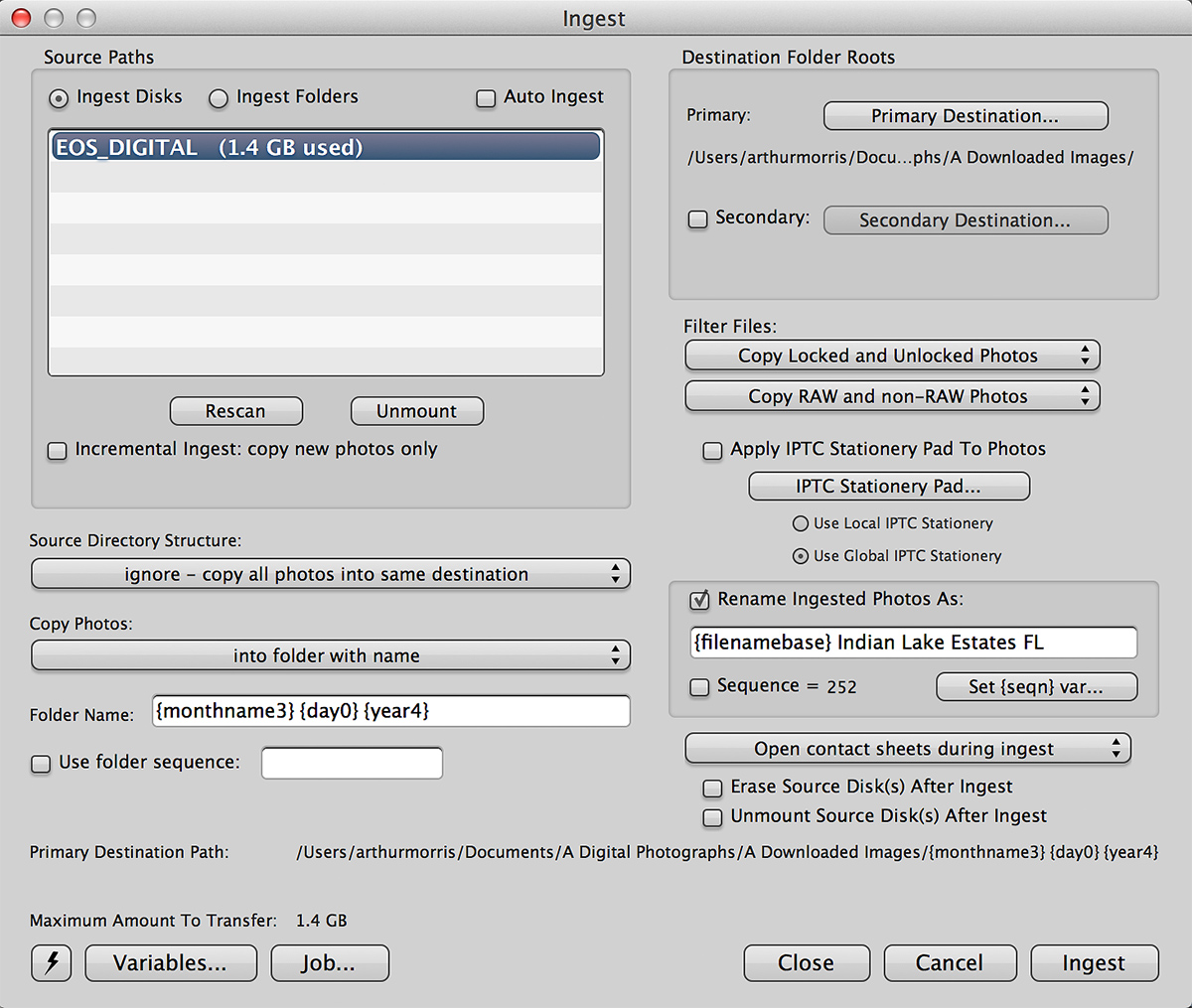
|
|
PM’s auto Ingest rocks!
|
Photo Mechanic’s Auto Ingest
Stick the card in your Delkin Dual Slot Card Reader, set up your Ingest screen exactly as above, and your images will be placed in a dated folder with the location that you type in appearing after the image’s file name/number. Just as I do most every day.
Questions
Please leave a comment if you are already using Photo Mechanic or if you have any questions. I will do my best to help.
|

|
|
All of the images in the bear boat card above were created in Katmai National Park during the month of September.
|
Due to a recent cancellation there are once again three slots open.
Bear Boat/Bears Catching Salmon IPT: September 1-8, 2015 from Kodiak, AK/6 FULL & 2 1/2 DAYS: $6699. Happy campers only! Maximum 8/Openings: 3. Plus the leader: Arthur Morris.
Join me in Katmai National Park, AK for seven days of photographing Coastal Brown Bears (grizzlies) catching salmon, fattening up for the long winter. Other subjects will include Mew and Glaucous-winged Gulls in flight and dip-feeding on salmon roe. Did I mention that we live on a boat and that the food is great? Most of our photography will be done in a variety of famed locations: Geographic Harbor, Kinak Bay, and Kukak Bay. We once had 39 bears fishing the creek at Kukak….
It is mandatory that you be in Kodiak no later than the late afternoon of August 31, 2015 September to avoid missing the float planes to the boat on the morning of September 1. With air travel in AK being what it is, with the chance of fog or other bad weather–being on Kodiak on August 30 is an even better plan). I will be on Kodiak on August 30 to avoid any potential disaster. That said in my nearly a dozen bear boat trips I was delayed only once but since I was day early as noted above there was no harm, no foul.
We will take one or more float planes to the boat mid-morning on September 1. We will photograph bears fishing that afternoon and every day for the next six days (weather permitting of course). We should have bears catching salmon every day. In addition, we will get some nice stuff on Mew Gull and Glaucous-winged Gulls dining on roe and the remains of predated salmon. We may–depending on where the concentrations of bears are–get to photograph Harbor seals and some hauled out Steller’s Sea Lions (an endangered species). Halibut fishing (license required) is optional. On September 8, our last morning on the boat, those who would like to enjoy one last photo session will do so. The group returns to Kodiak via float plane midday. Most folks will fly to Anchorage and then continue on red-eye flights to their home cities.
The eight days will consist of six full days (Sept 2, 3, 4, 5, 6, & 7) of photography featuring lots of Coastal Brown Bears catching salmon as above plus a variety of other natural history subjects plus some nice scenic photography that I forgot to mention above. Plus the first afternoon and the last morning.
What’s included? 8 DAYS/7 NIGHTS on the boat as above. All meals on the boat. (The food is quite excellent.) National Park fees. One night’s double occupancy lodging on Kodiak; arrive: Sept 1/depart: Sept 2. The thank-you-in-advance dinner on Sept 1. In-the-field photo tips, instruction, and guidance. An insight into the mind of a top professional; I will constantly let you know what I am thinking, what I am doing, and why I am doing it. Small group image review, image sharing, and Photoshop instruction on the boat.
What’s not included: Your round trip airfare to and from Kodiak, AK (almost surely through Anchorage). All necessary lodging other than the cost of your double occupancy room on the night of August 31 should you opt to arrive early–we can arrange that in advance for you. We will let you know the cost of a single supplement for the one night if so desired. The cost of the round-trip float plane to the boat on September 2 and back to Kodiak on September 9. The cost of a round trip this year was $500. The suggested crew tip of $210.
Is this an expensive trip? Yes, of course. But with 6 full and two half days, a wealth of great subjects, and the fact that you will be walking with the bears just yards away (or less….) it will be one of the great natural history experiences of your life. Most folks who take part in a Bear Boat IPT wind up coming back for more.
A $2,000 per person non-refundable deposit by check only made out to “Arthur Morris” is required to hold your spot. Please click here to read our cancellation policy. Then please print, read, and sign the necessary paperwork here and send it to us.
Your deposit is due immediately. That will leave a balance of $4699. The next payment of $2699 will be due on February 15, 2015. The final payment of $2000 is due on May 1, 2015.
I hope that you can join us for this wondrously exciting trip.
Facebook
Be sure to like and follow BAA on Facebook by clicking on the logo link upper right. Tanks a stack!
Support the BAA Blog. Support the BAA Bulletins: Shop B&H here!
We want and need to keep providing you with the latest free information, photography and Photoshop lessons, and all manner of related information. Show your appreciation by making your purchases immediately after clicking on any of our B&H or Amazon Affiliate links in this blog post. Remember, B&H ain’t just photography!
…..
Amazon.com
Those who prefer to support BAA by shopping with Amazon may use this link:
Amazon Canada
Many kind folks from north of the border, eh, have e-mailed stating that they would love to help us out by using one of our affiliate links but that living in Canada and doing so presents numerous problems. Now, they can help us out by using our Amazon Canada affiliate link by starting their searches by clicking here. Many thanks to those who have written.
Typos
In all blog posts and Bulletins, feel free to e-mail or to leave a comment regarding any typos or errors. Just be right :).
April 16th, 2015 Stuff
Slept well again. Acupuncture, swim, core exercises, and ice bath. And it is looking like early to bed.
This blog post, the 98th in a row, took about 1 1/2 hours to prepare and was published at one minute after midnight on Thursday.
Passover is Over
B&H is now accepting and shipping orders.
Please Remember to use our Affiliate Links 🙂
To show your appreciation for my continuing efforts here, we ask, as always, that you use our the B&H and Amazon affiliate links on the right side of the blog for all of your purchases. B&H is recommended for you major photography gear purchases, Amazon for your household, entertainment, and general purpose stuff. Please check the availability of all photographic accessories in the BIRDS AS ART Online Store, especially the Mongoose M3.6 tripod heads, Gitzo tripods, Wimberley heads and plates, LensCoats and accessories, and the like. We sell only what I have used, have tested, and can depend on. We will not sell you junk. We know what you need to make creating great images easy and fun. And we are always glad to answer your gear questions via e-mail. I just learned that my account was suspended during my absence; it should be up and running by Monday at the latest.
I would of course appreciate your using our B&H affiliate links for all of your major gear, video, and electronic purchases. For the photographic stuff mentioned in the paragraph above we, meaning BAA, would of course greatly appreciate your business. Here is a huge thank you to the many who have been using our links on a regular basis and visiting the BAA Online store as well.
Civility and Freedom of Speech on the BIRDS AS ART BLOG
As most would surmise, I am pretty proud of the work that I do here on the blog. I enjoy teaching and I enjoy sharing. Though some think not, I am fine if you do not like an image. In fact, there have been a few that I posted recently that I did not think much of. If you don’t like an image, just say so. There is however, no reason to go out of your way to be nasty or to try to be insulting. Those who opt for the latter are in truth only insulting themselves.
It is imperative that folks who opt to leave a comment be civil. Folks who visit and comment regularly would be given a bit of slack, but I cannot even recall a situation where that was necessary. Nasty comments almost always come from folks who are commenting for the first time. It’s good to know that some folks have such miserable lives that they feel the need to take time out of their busy days to be nasty, or as Denise Ippolito calls it, “snarky.”
Folks who comment for the first time have their comments sent to a Moderation page where they might be approved, replied to, trashed, or spammed. The vast majority are approved or replied to. If you are spammed, you will likely be unable to post a comment. Not too long ago a first time poster wrote something to the effect that I should stick to photography, that nobody wanted to read about my grandkids or my health. I thought, it’s my blog. I will write about what I want to write about. I had no qualms about spamming him instantly. If you choose to visit my home, please play nice.
Freedom of speech on the blog? There is none.
A Negative but Civil Comment
A first time poster left this comment at BAA Bulletin #473 here:
In my opinion the photo is not worth optimizing. Sea lions are cute animals, this image, although a great pose, makes them look slimy and not endearing to the viewer. The optimized image, although better, still is not good enough to represent what I think of as an elegant animal.
Though I disagreed in part as I feel that sometimes by trying you can either learn something or surprise yourself by working on a very poor image, I was fine with the fact that the poster did not like the optimized image. Heck, I did not think much of it either.
|
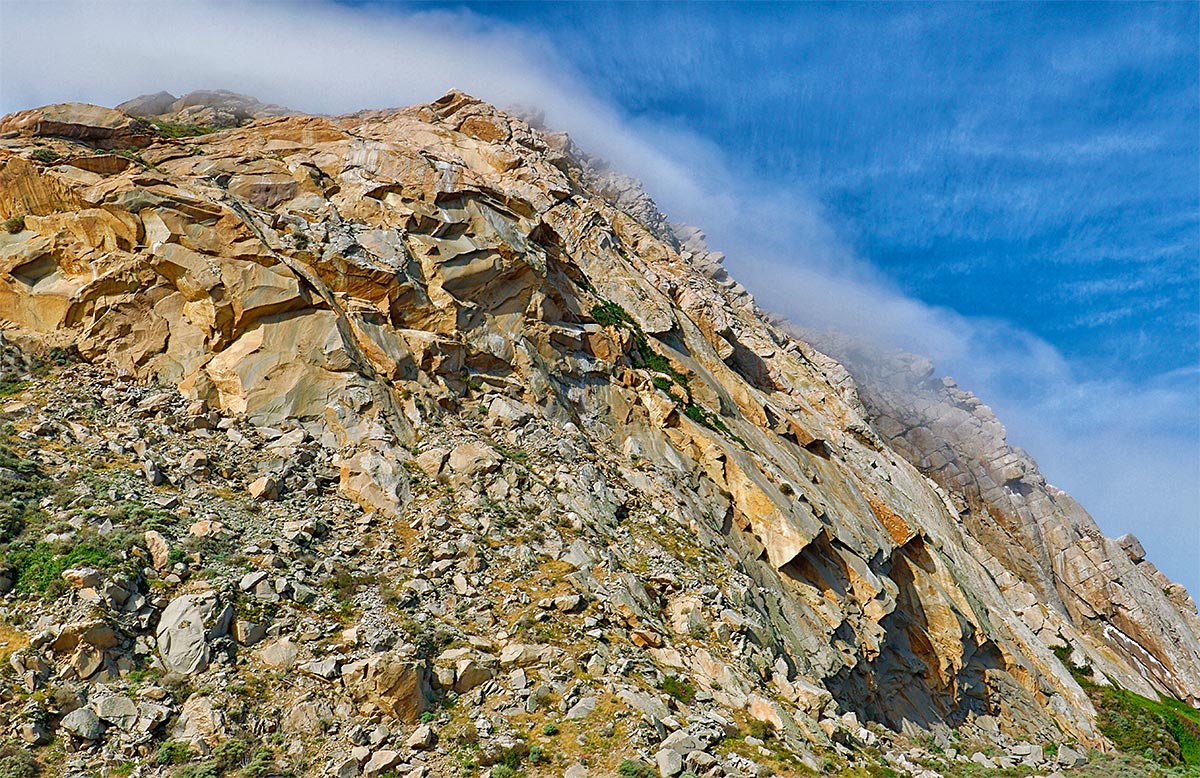
|
|
This in-camera HDR image was created at Morro Bay with the hand held Canon EF 16-35mm f/4L IS USM lens (at 16mm) and the amazing Canon EOS 7D Mark II. ISO 400. Evaluative metering +2/3 stop yielded a base exposure of: 1/100 sec. at f/22 in Av mode. AWB. With the 77mm Singh-Ray warming circular polarizer set to dark.
Center AF point/AI Servo Expand/Rear Focus AF one-third of the way up the rock on the right side and re-compose. Click here to see the latest version of the Rear Focus Tutorial. Click on the image to see a larger version.
Image: Morro Rock with fog.
|
A Not-too-good Image of Morro Rock
In the blog post here, which featured the in-camera HDR image of Morro Rock, someone who had never commented before left this comment:
“I’d stick to birds if I were you. That is just not a very good shot and just a terrible way to go about it. You clearly know how to use Photoshop so why on earth would you use crappy in-camera HDR. Also even the 7D Mark II APS-C sensor has enough dynamic range to get that shot in one exposure.”
I spammed him for being unnecessarily nasty. Was I being too sensitive?
A comment like this would have worked well for me:
That is just not a very good shot. It would have been better if you had created an HDR from three separate images.
|
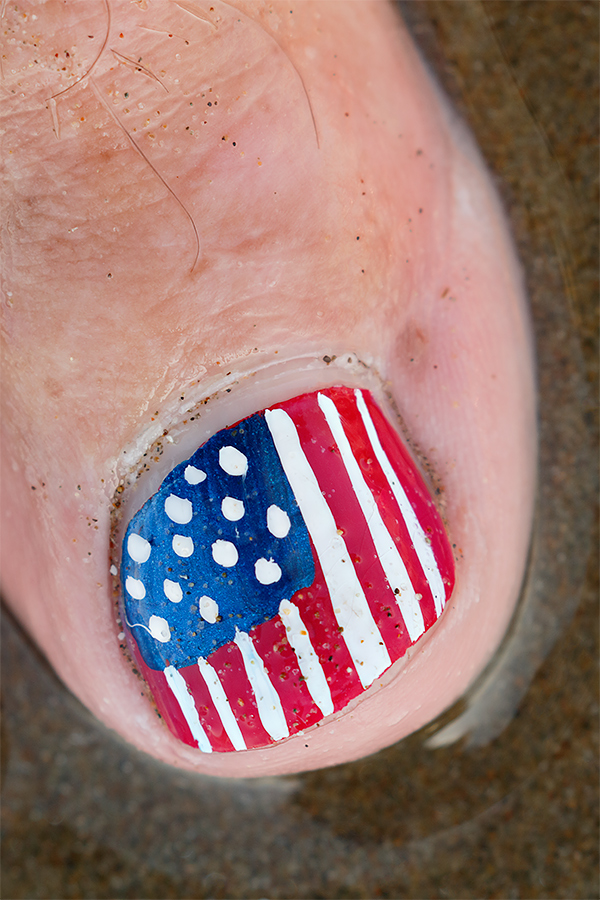
|
Pretty Bad Morro Rock Image…
This image was created at Morro Bay (while standing) with the hand held Canon EF 100-400mm f/4.5-5.6L IS II USM lens, the Canon Extender EF 1.4X III (at 560mm), and the amazing Canon EOS 7D Mark II. ISO 400: Evaluative metering at zero: 1/100 sec. at f/11 in Av mode. Auto WB. (Should have been Shade or at least Cloudy).
Center AF point (by necessity)/AI Servo Expand/Shutter Button AF as framed was active at the moment of exposure (as is always best when hand holding). The center AF point fell on a spot at the upper right center right near the edge of the painted nail. Click on the image to see a larger version.
Image #2: Painted toenail in shade.
|
Flag-painted Toenail Lessons
In the blog post https://www.birdsasart-blog.com/baa/2015/04/05/canon-100-400ii1-4xiii7dii-part-ii-patriotic-toe-photography-related-exposure-and-white-balance-lessons/, which featured images of the flag-painted toes US Air Force retired med-evac technician Chris Billman, another first time poster wrote:
“Really? This is now the Toes as Art blog? Ugh.”
To me it is clear that the poster went out of his way to be nasty. In addition, there was a great sun out/sun in exposure lesson there in addition to the two images. I spammed him too. His comment was OK up till the “Ugh.” Was I being too sensitive?
Several questions from that same blog post:
A: How is your exposure math?
Q: Same toe. Same lens. Same day. Same beach. How many stops difference in the two exposures, the one in the sun and the one in the shade?
A: The exposure for the sunlit image was 1/640 sec. at f/11. The exposure for the shaded image was 1/100 sec. at f/11. Since the aperture was the same all that you needed to do was to determine how many stops between 1/100 sec. and 1/640 sec. The sequence would look like this: 1/100 sec., 1/200 sec (one full stop), 1/400 sec (2 full stops), and 1/800 sec (three full stops). Since we never quite made it to to 1/800 sec (almost), the correct answer is that the difference in stops between 1/100 sec at f/11 and 1/640 sec at f/11 is 2 2/3 stops. Many folks answered this one correctly.
The unspoken lesson here is that the same toe in the shade needs a heck of a lot more light to be properly exposed in the shade than when in the sun, 2 2/3 stops more to be exact.
B: Easy Question
Q: If the recorded focal length (560mm) is the same for both images above, why is the toe considerably larger in the shaded version?
A: I moved the lens closer to the subject. Let of folks got that one right.
C: Another Easy Question
Q: Why was it vitally important that AF be active at the moment of exposure for both images?
A: It would be pretty much impossible to avoid moving while pointing the lens down to photograph your or someone else’s toe; just your breathing alone would be more than enough to throw off accurate focus. Solve problems like this by using AI Servo AF (C for Continuous with Nikon) and having it active at the moment of exposure. It is common knowledge that we must use AI Servo AF to track moving subjects like flying birds; what folks need to realize is that then they are hand holding they are almost always moving, at least a bit.
Your Thoughts?
Feel free to chime in on any of the topics covered here today. Or not. Just be nice 🙂
Facebook
Be sure to like and follow BAA on Facebook by clicking on the logo link upper right. Tanks a stack!
Support the BAA Blog. Support the BAA Bulletins: Shop B&H here!
We want and need to keep providing you with the latest free information, photography and Photoshop lessons, and all manner of related information. Show your appreciation by making your purchases immediately after clicking on any of our B&H or Amazon Affiliate links in this blog post. Remember, B&H ain’t just photography!
…..
Amazon.com
Those who prefer to support BAA by shopping with Amazon may use this link:
Amazon Canada
Many kind folks from north of the border, eh, have e-mailed stating that they would love to help us out by using one of our affiliate links but that living in Canada and doing so presents numerous problems. Now, they can help us out by using our Amazon Canada affiliate link by starting their searches by clicking here. Many thanks to those who have written.
Typos
In all blog posts and Bulletins, feel free to e-mail or to leave a comment regarding any typos or errors. Just be right :).
April 15th, 2015 Stuff
Slept 9 hours with one pit stop; you gotta love those ice baths. Today I had a great swim and an ice bath. Learn more about my day below. This educational blog post, the 97th in a row, took about 2 hours to prepare and was published at one minute after midnight on Wednesday.
|
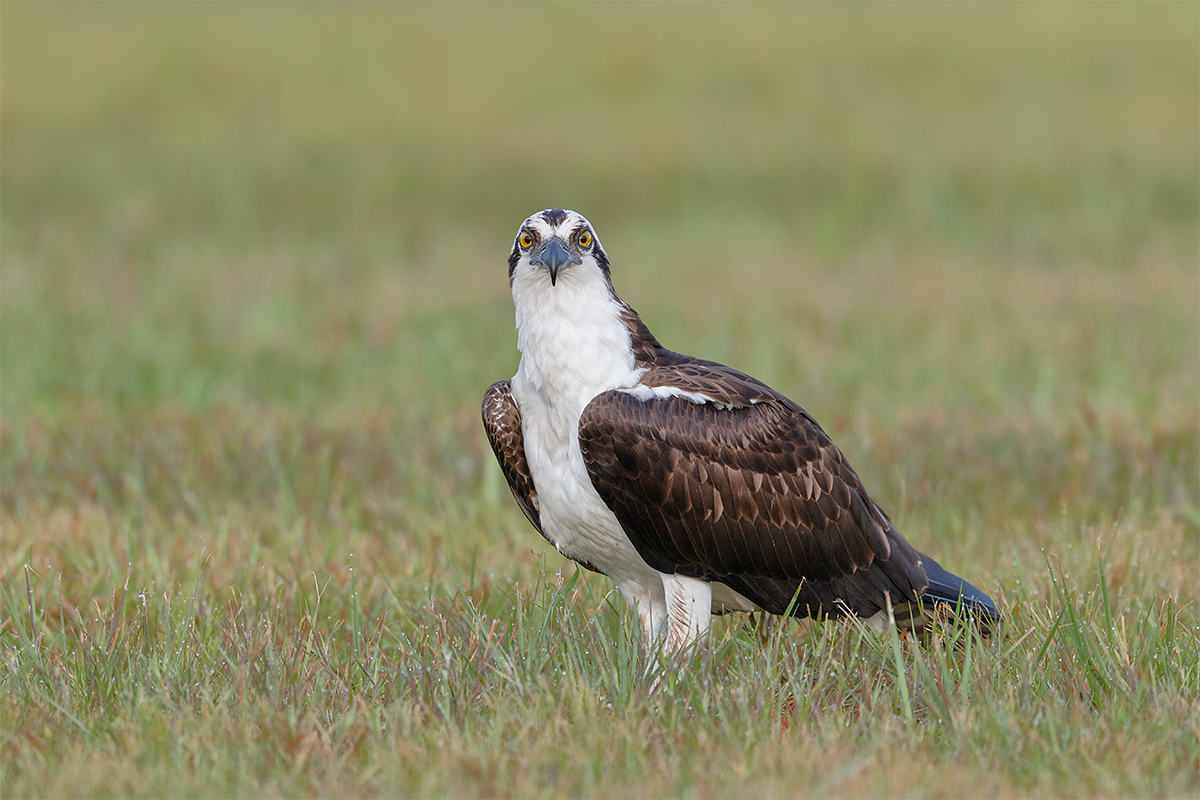
|
|
This image was created down by the lake at ILE on Monday morning from my SUV with the BLUBB-supported Canon EF 600mm f/4L IS II USM lens, the Canon Extender EF 1.4X III, and which camera body? ISO 400. Evaluative metering +2/3 stop as framed 1/640 sec. at f/5.6 in Manual mode. AWB.
Center AF point/AI Servo Expand/Rear Focus AF as framed was active at the moment of exposure (as is always best if possible when working off the BLUBB). The active AF point was just inside the bend of the far wing, right on the same plane as the bird’s staring eyes. Click here to see the latest version of the Rear Focus Tutorial. Click on the image to see a larger version.
|
GrassPREY/On the Spot #2: 1D X or 7D II?
There is something quite beautiful about an Osprey in the grass…. Can you tell if this image was made with the 1D X or the 7D II? Checking out the 100% crop of the head below might help you decide. Do let us know why you made your choice.
I have not forgotten about letting y’all know which camera made which image in this blog post: “Now You Are On the Spot: Image Quality/Which Camera Quiz: the first of many…” Thanks to John Giatropoulos and Steve Soderling for humoring me by playing along. It may take a while but all will be revealed here in a bit. But you will need to be patient 🙂
|
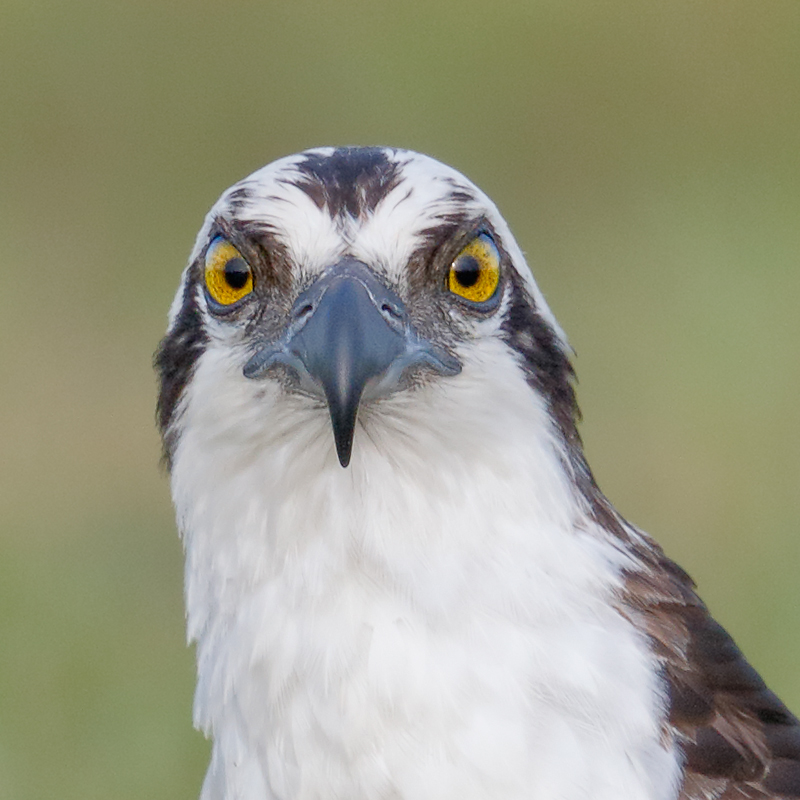
|
|
This is a 1:1 or 100% crop (I think…) of the optimized image above.
|
100% Crop Lesson Learned. I Think…
Michael Tapes came over to do some early morning photography down by the lake and teach me a bit about a lot, mainly about some exciting LensAlign news coming in June. We micro-adjusted my 300 II with one of my two 7D Mark II bodies with the LensAlign II and his amazing FocusTune Software. You can learn more about LensAlign Mark II/including Fusion here. The best micro-adjustment turned out to be +3.
I mentioned and explained how I came up with the “200% crop” that I referred to in the blog post here. Actually, I was spurred to do so after reading Steve Soderling’s comment which read in part: Actually, I can hardly believe that image 1 is really a 200% crop. I didn’t think it was possible to get a 200% image (which means to me that there are 4 screen pixels for every camera pixel) that looks this sharp!!
As Michael explained to me, the percentage view has zero to do with the crop. He showed me that if I simply crop the head of the optimized Osprey image as an 800 pixel square that I will be showing a 1:1 or 100% view crop. That is what I did above. He further explained to me that going bigger would indeed “mess with the pixels” as Steve noted.
So it turns out that I was wrong in that post and have been wrong in many others as far as the “100 and 200% crops” are concerned. Apologies. But I have learned the lesson now and a good lesson it is. Many thanks to both Michael and to Steve for opening my eyes.
DPP RAW Conversion Lessons
Of special note in the DPP 4 screen capture above is that the Shadow slider is set to +5. This really helped with the dark tones on the bird without introducing any noise at all. I exposed well to the right with some WHITE RGB values in the 240s; that is why I moved the brightness slider to -0.17 and the Highlight slider to -1. Sharpness at 3 is standard for every image. I wish that it could be set as the default as it prevents the destruction of fine feather detail that comes with the default settings for Unsharp Mask.
|

|
|
You can order your copy of “The Photographers’ Guide to Canon Digital Photo Professional 4.0” (aka the DPP 4 Raw Conversion eGuide) by Arash Hazeghi and Arthur Morris by clicking here.
|
The DPP 4 eGuide (PDF)
Learn how and why I and many other discerning photographers choose and use only DPP 4 to convert their Canon RAW files in the DPP 4 RAW Conversion Guide by Arash Hazeghi and yours truly. The latest version supports all of the newer Canon camera bodies and several older models including the EOS-7D and the EOS-1D Mark IV. A free update that will cover most of the newly added cameras will be sent in a week or two. See upcoming blog posts for exact details.
|

|
|
Clockwise from upper left to center: Snowy Egrets/breeding plumage pair, American Alligator with egret feather on head, Cattle Egret in breeding plumage (with fill flash), large Snowy Egret chicks, displaying gator, Wood Stork in flight carrying nesting material (fill flash), begging Snowy Egret chick, another Cattle Egret in breeding plumage (with fill flash), and Great Egret chick.
|
Date Change: St. Augustine Alligator Farm Short-Notice Spoonbill and Wading Bird Chicks IPT: May 4-6, 2015.
St. Augustine Alligator Farm Short-Notice Spoonbill and Wading Bird Chicks IPT: May 4-6, 2015. TWO FULL and TWO 1/2 DAYS: $1099. Limit 8/Openings 5.
St. Augustine in early May is a bird photographer’s paradise. With any luck we should have chicks of all sizes in the nests ranging from newly hatched Snowy Egrets and Tricolored Herons to nearly fledged Great Egrets. More than a few pairs of Roseate Spoonbills have nested at the Alligator Farm for the past several years. Photographing the spoonbill chicks in the nest is a huge challenge…. With any luck we will encounter a few Snowy and Cattle Egrets in stunning breeding plumage. We should have lots of flight photography ops especially late in the day. We will enjoy extra early entry on our three mornigs. Folks who will need a photographer’s pass ($89.95 includes full season early entry and late stay and submission fees for up to 5 photos in their annual contest; this works out to cheaper than four separate entry tickets). We will have those ready for pick-up on the first afternoon.
|

|
|
Clockwise from upper left: flash-as-main light Great Egret chick begging, breeding plumage Cattle Egret w/fill flash, Little Blue Heron, Great Egret chick in nest begging, Cattle Egrets copulating, Wood Stork with nesting material, another Wood Stork with nesting material, and breeding plumage Snowy Egret displaying.
|
What You Will Learn
On this IPT you will the learn the basics and fine points of digital exposure and how to get the right exposure every time after making a single test exposure. You will learn to understand and predict bird behavior and to see and understand the light. You will learn to design pleasing images by mastering your camera’s AF system and how and why to work in Manual mode (even if you’re scared of it). Most importantly, you will learn to spot the good situations, to choose the best perspective. Rookeries are crowded, cluttered, white-washed places. Most folks who visit have no clue as to the difference of an image with tons of distractions and one with a clean line of sight and the best possible distant background. Join me and I will teach you to see like a pro.
I will be bringing my flash to the Alligator Farm (gasp!) I have not used flash for at least a year. I will be teaching you how to use flash as fill and how to use flash as main light. In addition, I will be reviewing the flash flight techniques that I developed at St. Augustine more than a few years ago.
|

|
|
Clockwise from upper left: gator back, Great Egret returning to mate (with fill flash), Roseate Spoonbill with bill open, Roseate Spoonbill chick begging, Roseate Spoonbill 11am silhouette, large Great Egret chicks in nest, and bill of Roseate Spoonbill.
|
Whats the Rest of the Deal?
Afternoon session on Monday, May 4. Then two full days with a morning and afternoon session each day, May 5 & 6. Then our last morning on May 7. At lunch on Tuesday and Wednesday (included) we will review my images; folks learn a ton watching me edit–why keep this one and delete that one? If you opt to bring your laptop, we can take a look at five of your best images from the morning or another session. We will process a few of my images in Photoshop after converting them in DPP. That followed by Instructor Nap Time.
A $499 non-refundable deposit is required to hold your spot. Your balance–$600, payable only by check, is due immediately. Please include a separate check for $89.95 so that we can purchase your pass in advance. Please click here to read our cancellation policy before committing. Then please print, read, and sign the necessary paperwork linked to here and get it to us. You can register by calling Jim or Jen at the office at 863-692-0906 and arranging for your deposit of $499. Balances are payable only by check. I hope to see you there.
From Pat and Stokes Fishburne
The Alligator Farm is quite good right now. Good spoonbill nests and lots of spoonbills. Also, Snowy Egrets, Tricolored Herons, and a few Cattle Egrets along with more than a few Great Egret nests with chicks.
Facebook
Be sure to like and follow BAA on Facebook by clicking on the logo link upper right. Tanks a stack!
Support the BAA Blog. Support the BAA Bulletins: Shop B&H here!
We want and need to keep providing you with the latest free information, photography and Photoshop lessons, and all manner of related information. Show your appreciation by making your purchases immediately after clicking on any of our B&H or Amazon Affiliate links in this blog post. Remember, B&H ain’t just photography!
…..
Amazon.com
Those who prefer to support BAA by shopping with Amazon may use this link:
Amazon Canada
Many kind folks from north of the border, eh, have e-mailed stating that they would love to help us out by using one of our affiliate links but that living in Canada and doing so presents numerous problems. Now, they can help us out by using our Amazon Canada affiliate link by starting their searches by clicking here. Many thanks to those who have written.
Typos
In all blog posts and Bulletins, feel free to e-mail or to leave a comment regarding any typos or errors. Just be right :).
April 14th, 2015 Stuff
I went down to the lake this morning and almost headed back to get some work done. But then it got pretty good. I even had an Osprey posing in the grass. Then a nice swim, an acupuncture treatment, and an ice bath.
This educational blog post, the 96th in a row, took 2 hours to prepare and was published at one minute after midnight on Tuesday.
St. Augustine Short Notice IPT
With just three folks signed up, this trip represents a great opportunity to learn a ton in a great setting. See here for complete details.
From Pat and Stokes Fishburne
The Alligator Farm is quite good right now. Good spoonbill nests and lots of spoonbills. Also, Snowy Egrets, Tricolored Herons, and a few Cattle Egrets along with more than a few Great Egret nests with chicks.
|
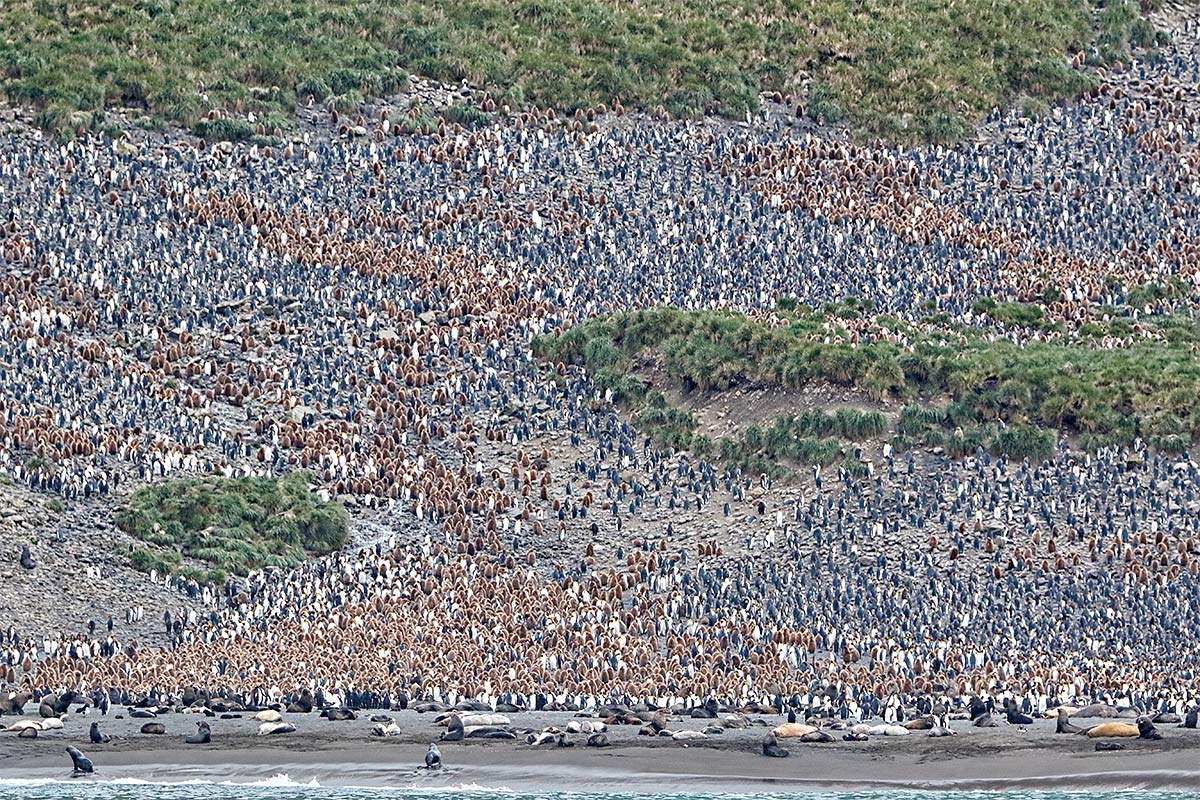
|
|
This image was created at Right Whale Bay, South Georgia with the tripod-mounted Canon EF 300mm f/2.8L IS II USM lens, the Canon Extender EF 1.4X III, and the Canon EOS 7D Mark II. ISO 1000. Evaluative metering +1/3 stop: 1/250 sec. at f/4.5 in Tv mode.
Center AF point (manual selection)/AI Servo/Rear Focus AF 1/3 of the way into the frame and re-compose. Click here to see the latest version of the Rear Focus Tutorial. Click on the image to see a larger version.
Image 1: King Penguin rookery, Right Whale Bay, South Georgia
|
The Situation
Delayed by a Force 10 gale on the way from the Falklands to South Georgia, we arrived very late at Right Whale Bay, well after dinner in fact. Having taken our time at dinner Michael Viljoen and I were late getting to the zodiacs. When I saw how cloudy, dark, and gloomy it was and noted that the Ortelius was anchored right in front of the main portion of the King Penguin rookery, I said, “Let’s stay on the ship and see what we can do.” We grabbed a few lenses and our tripods, each equipped with a Mongoose M3.6, and went to work. We began trying to create relatively sharp images like the one above at fairly high ISOs. As it was getting darker by the minute, I suggested that we tried some creative stuff. So we did.
|
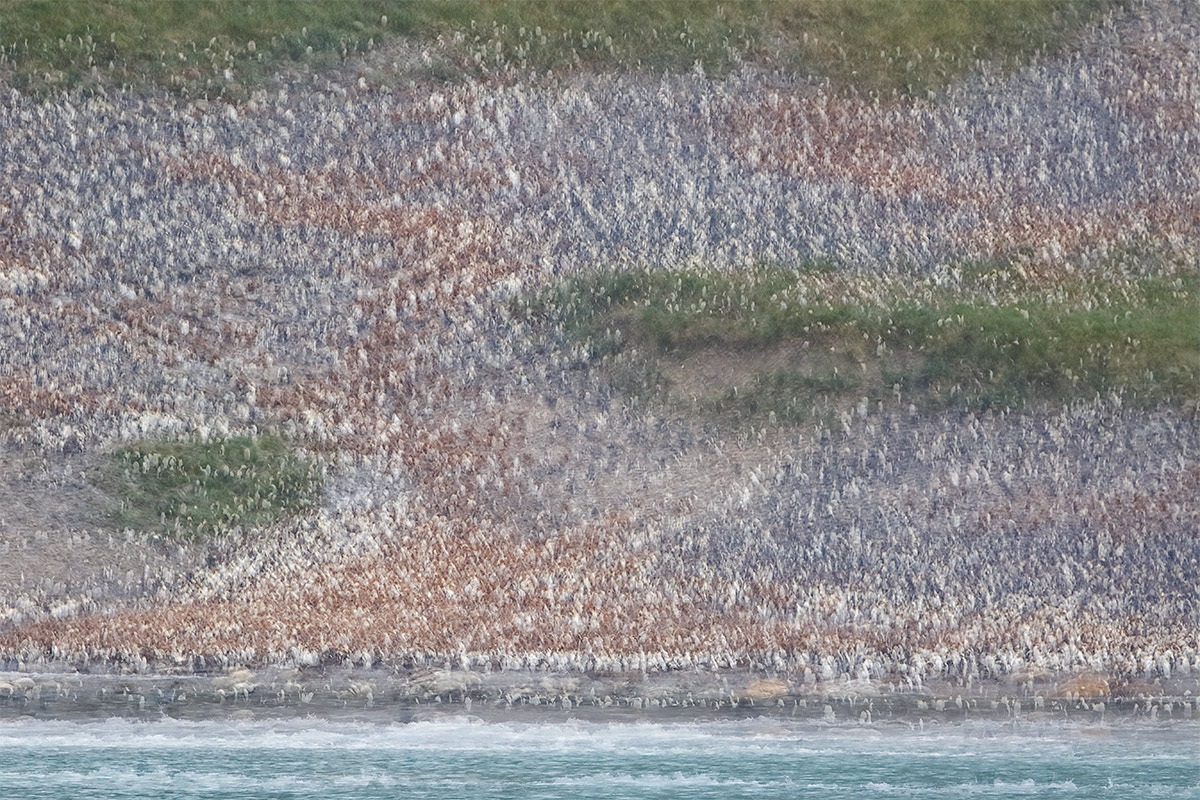
|
|
This 5-frame in-camera Multiple Exposure was created at Right Whale Bay, South Georgia with the tripod-mounted Canon EF 300mm f/2.8L IS II USM lens, the Canon Extender EF 1.4X III, and the Canon EOS 7D Mark II. ISO 1000. Evaluative metering +1/3 stop: 1/250 sec. at f/4.5 in Tv mode.
Center AF point (manual selection)/AI Servo/Rear Focus AF 1/3 of the way into the frame for each frame and re-compose while shifting the camera slightly for each exposure. Click here to see the latest version of the Rear Focus Tutorial. Click on the image to see a larger version.
Image 2: King Penguin rookery in-camera Multiple Exposure, Right Whale Bay, South Georgia
|
Multiple Exposure
First up I set up for five-frame Multiple Exposures as detailed in the 7D II (and the 5D III) camera body User’s Guides. I initially over-processed this image with too much contrast and too much Detail Extractor so I created a softer version by putting the optimized image on top of the converted TIFF and reducing the opacity to about 40%. It looked a lot nicer than my first attempt.
|
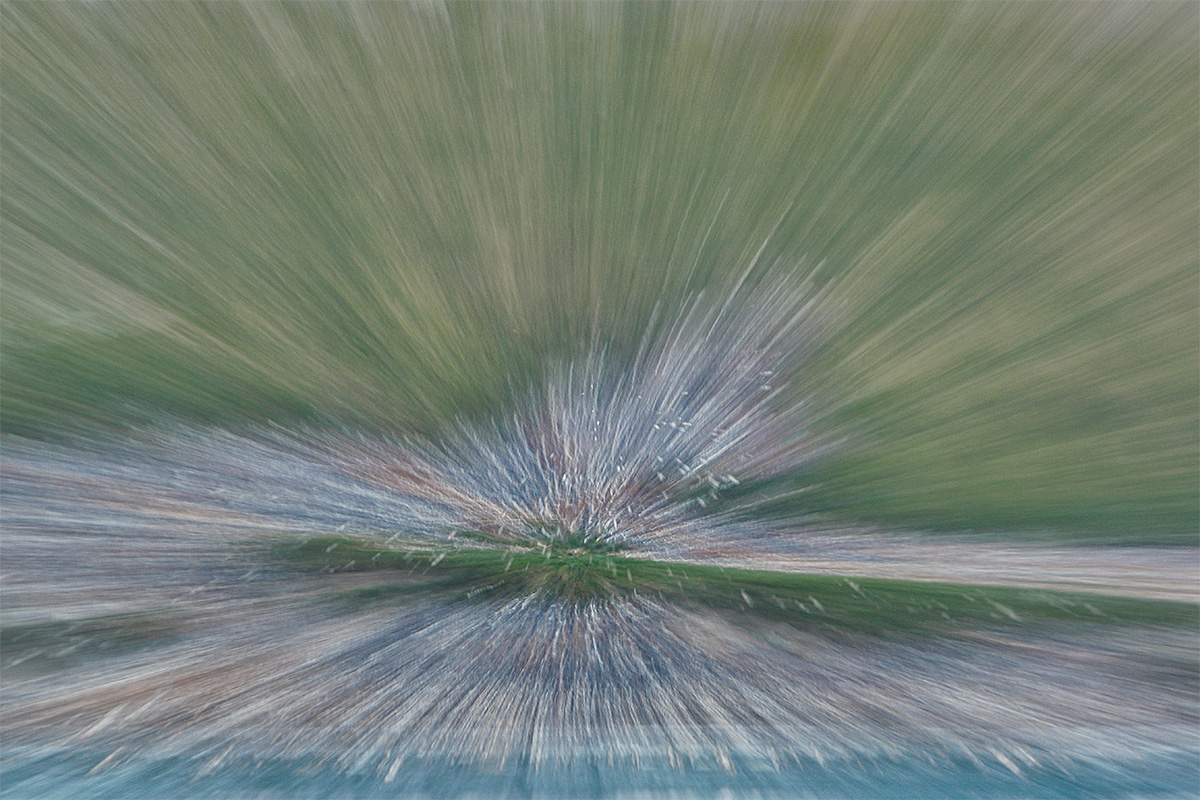
|
|
This image was created at Right Whale Bay, South Georgia tripod-mounted Canon EF 70-200mm f/2.8L IS II USM lens, the Canon Extender EF 1.4X III, and the Canon EOS 7D Mark II. ISO 100. Evaluative metering at zero yielded a base exposure of 1 sec. at f/11 +/- 2 stops.
Center AF point (manual selection)/AI Servo/Rear Focus AF
Center AF point (manual selection)/AI Servo/Rear Focus AF as framed and release. Zoomed out and then in very slowly during the three exposures. Click here to see the latest version of the Rear Focus Tutorial. Click on the image to see a larger version.
Image #3: King Penguin Rookery in-camera Art Vivid HDR zoom blur, Right Whale Bay, South Georgia
|
Really Messing Around
As the ship swung on anchor, we had to move from the 2nd starboard deck to the first deck on the stern. I created some standard zoom blurs and then, borrowing a technique that I had developed at the flower fields in Holland, I made some Art Vivid zoom blurs with mega-slow shutter speeds….
Soon after we made our way down to the stern, the zodiacs began returning. It had been a short landing in very poor conditions. Both Michael and I agreed that the decision to stay on the boat was a good one. As things worked out, we had many landings with tame, wall to wall King Penguins in decent conditions.
Your Call?
Feel free to pick one or to improvise:
a-I liked all of them.
b-Image # __ was my favorite because.
c-I don’t like any of them because ….
d–They are all terrible. You should have stayed in bed.
e-….
South Georgia 2015
Like penguins? Be sure to shoot me an e-mail to learn how to become part of the BAA group.
Remember!
Each of us gets only one ride on the merry-go-round of life….
|
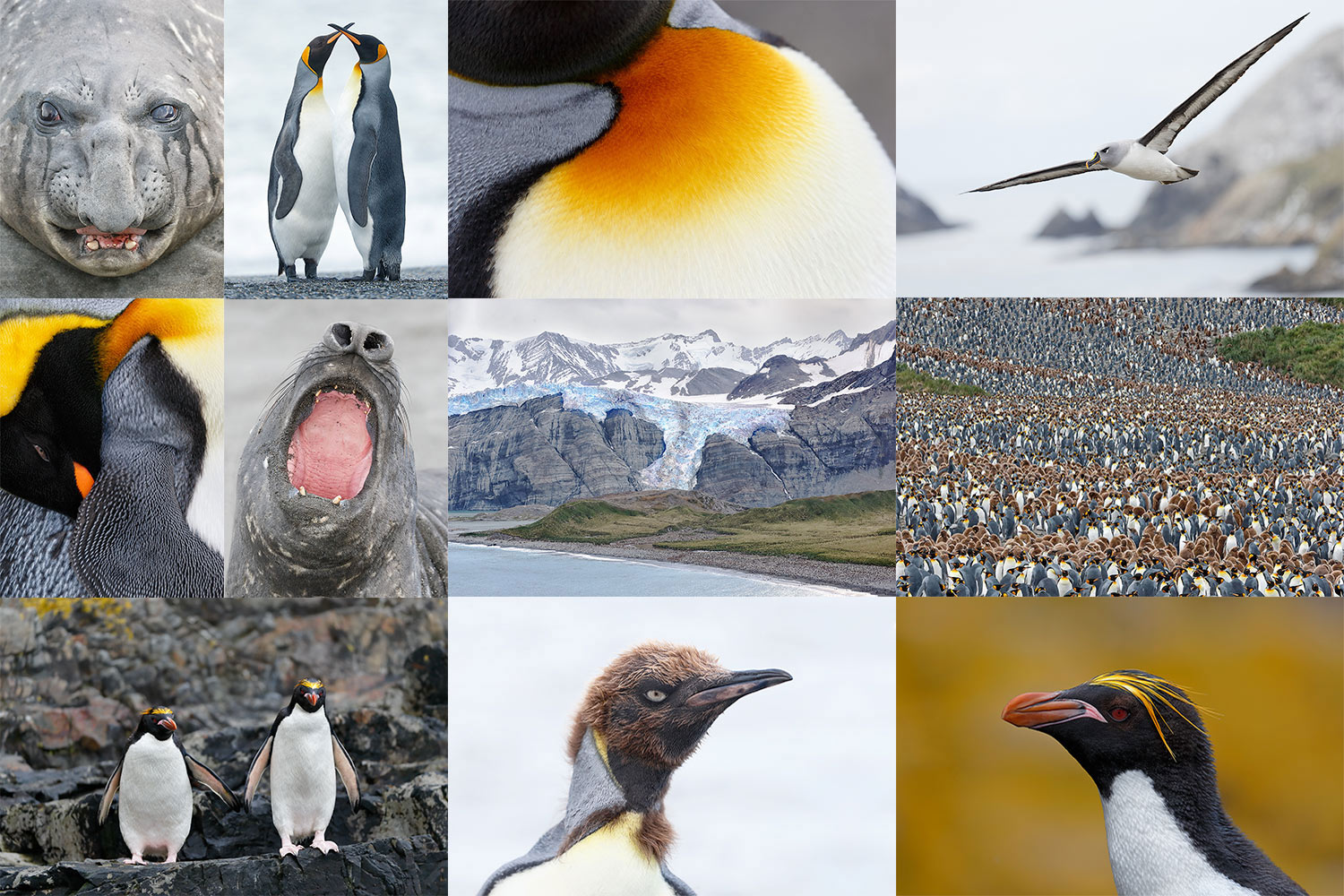
|
|
All of the images on the card were made on South Georgia. This remote wilderness island offers both spectacular scenery and hordes of tame wildlife and birds. From top left clockwise to the center: Southern Elephant Seal, courting King Penguin pair, King Penguin abstract, Grey-headed Albatross, King Penguin rookery on Salisbury Plain, Macaroni Penguin head portrait, King Penguin molting Okum Boy, Macaroni Penguin pair, King Penguin preening, Southern Elephant Seal yawning, the view of Gold Harbour from a Light-mantled Sooty Albatross nest.
Click on the image to see an extra large version.
|
The Southern Ocean
South Georgia Expedition Voyage
I’ve been blessed. I’ve now made four trips to the Southern Ocean, three expeditions that visited the Falklands, South Georgia, and the Antarctic Peninsula, and one to the Falklands and South Georgia. Each was a truly amazing experience. South Georgia has been the star of the show each time: rugged snow covered peaks, tame and abundant wildlife including Southern Elephant Seal and Southern Fur Seal, and penguins: more King Penguins than you could ever have dreamed of. Gentoos. And my favorite, the golden-yellow spaghetti-topped Macaronis. With four trips to South Georgi under my belt, I have a pretty good idea about how to make great images at each of the iconic landings. In addition, we should have some pretty good flight photography sessions from the stern of the ship. I would love the chance to share my knowledge with you.
Questions?
I’d be glad to answer all of your Southern Ocean/Falklands/South Georgia/Antarctica questions. Please leave a comment if you’d like to learn more. If you’d like to join my group this October, shoot me an e-mail to learn how. Click here for additional details.
Facebook
Be sure to like and follow BAA on Facebook by clicking on the logo link upper right. Tanks a stack!
Support the BAA Blog. Support the BAA Bulletins: Shop B&H here!
We want and need to keep providing you with the latest free information, photography and Photoshop lessons, and all manner of related information. Show your appreciation by making your purchases immediately after clicking on any of our B&H or Amazon Affiliate links in this blog post. Remember, B&H ain’t just photography!
…..
Amazon.com
Those who prefer to support BAA by shopping with Amazon may use this link:
Amazon Canada
Many kind folks from north of the border, eh, have e-mailed stating that they would love to help us out by using one of our affiliate links but that living in Canada and doing so presents numerous problems. Now, they can help us out by using our Amazon Canada affiliate link by starting their searches by clicking here. Many thanks to those who have written.
Typos
In all blog posts and Bulletins, feel free to e-mail or to leave a comment regarding any typos or errors. Just be right :).
April 13th, 2015 Stuff
I went down to the lake this morning and photographed from my SUV for a while. Not bad, not great. Then a nice swim and my core exercises. Then another afternoon of Masters golf on TV; congrats to the young champ, Jordan Spieth on a great performance.
This educational blog post, the 95th in a row, took 2 hours to prepare and was published at one minute after midnight on Monday.
St. Augustine Short Notice IPT
With just three folks signed up, this trip represents a great opportunity to learn a ton in a great setting. See here for complete details.
South Georgia
Like penguins? Please click here to learn about joining the BIRDS AS ART group on the great Cheesemans’ South Georgia Expedition next October.
New Used Gear Listing
Canon EF 24-70 f2.8L II USM Lens
Dave Bourgaize is offering a used Canon EF 24-70 f2.8L II USM lens in excellent condition for $1499.00. The sale includes front lens cover and rear lens cap, EW-88C lens hood, original Canon bag, and insured shipping via UPS Ground to US addresses. Your item will not ship until your check clears unless other arrangements are made. Please contact Dave by e-mail or by phone at (310) 748-9547 (pacific time zone).
I own and use the 24-70II. It is much sharper edge to edge than the lighter, more versatile Canon EF 24-105mm f/4L IS USM lens. I consider the 24-70II a must for serious landscape photographers. As it sells new for $1899 Dave’s price is lower than any I have seen for this lens in excellent condition. It should sell immediately.
Used Photography Gear
You can see all the current listings here.
|

|
|
This image was created Lake Blue Cypress with the hand held Canon EF 300mm f/2.8L IS II USM lens and the Canon EOS 7D Mark II. ISO 400. Evaluative metering +2 2/3 stops off the white sky: 1/2000 sec. at f/2.8.
Center AF point/AI Servo Expand/Shutter Button AF as originally framed was active at the moment of exposure (as is always best for flight photography). The active sensor was on the left side of the bird’s face. Click on the image to see a larger version.
Image #1: Osprey black & white NIK Silver EFEX Pro Neutral
|
Why Wide Open for Flight?
Most of the time when doing flight photography I will work wide open or close to it. Here, I went wide open to the max at f/2.8. To my eye, the depth-of-field is more than sufficient to cover the whole bird from wingtip to wingtip.
Here are the reasons in no particular order that I work wide open or close to it when doing flight photography:
1: The wider the aperture at a given ISO the faster the shutter speed. Fast shutter speeds are ideal for flight photography. My good friend Ned Harris, a skilled and oft-published hawks in flight photographer, once said to me, “If I could work at 1/8000 sec. all the time for flight photography I would do just that.”
2: Working at the widest aperture will always let you used the lowest ISO for a given shutter speed (always assuming that you are exposing to the right–as I did here in an extreme low-light situation–in order to come up with a good exposure).
3-In most flight photography situations the birds are far enough away to ensure sufficient depth-of-field to cover the entire bird. Remember that as camera to subject distance increases, depth-of-field increases. For me, the myth of stopping down either one full stop or always working at f/8 is pretty much bad advice. A secondary factor here that bolsters my argument is that though you would typically want more depth-of-field when working close to a lens’s minimum focusing distance, depth of field at close range is minimized…. In other words, stopping down in these situations will not help you much anyway….
Here is an example. With a 7D II and the 300 II the total depth-of-field at 60 feet at f/2.8 is 1.29 feet. Stopping down one full stop brings that to 1.82 feet. Stopping down two full stops costs brings you to 2.58 feet. In today’s example you would need to increase from ISO 400 to ISO 1600 to maintain the same shutter speed…. Values approximate from Depth of Field Master.com.
Why Go Black and White with this Image?
With this particular image, I was not able to get the dark tones just right no matter how hard I tried to balance the color. The BLACKs were too RED…. So B&W was a fairly obvious choice. But what is an Osprey without those staring yellow eyes?
The Staring Yellow Eye
This color of this Osprey’s staring yellow eye was restored by applying Silver EFEX Pro on a separate layer, adding a Regular Layer Mask, and then painting the eye color back in: BDX with B = Brush, D = Default, and X = Switch Background and Foreground Colors. BDX is a mnemonic device that I created that helped me understand layer masking. To restore with a Regular Layer Mask hit BDX. After a while you will come to understand that you are painting with black on a white mask to reveal the stuff below. To restore with an Inverse (Black, or Hide-All Mask), hit BD…. Do check out “Layer Masking for Dummies” in my Digital Basics File.
All of the above plus the Eye Doctor, Selective Color, and Contrast Mask work that I did during the optimization is covered in detail in my Digital Basics File. Advanced Quick Masking and Layer Masking techniques are detailed in APTATS I and APTATS II respectively. Buy both here and save $15!
|
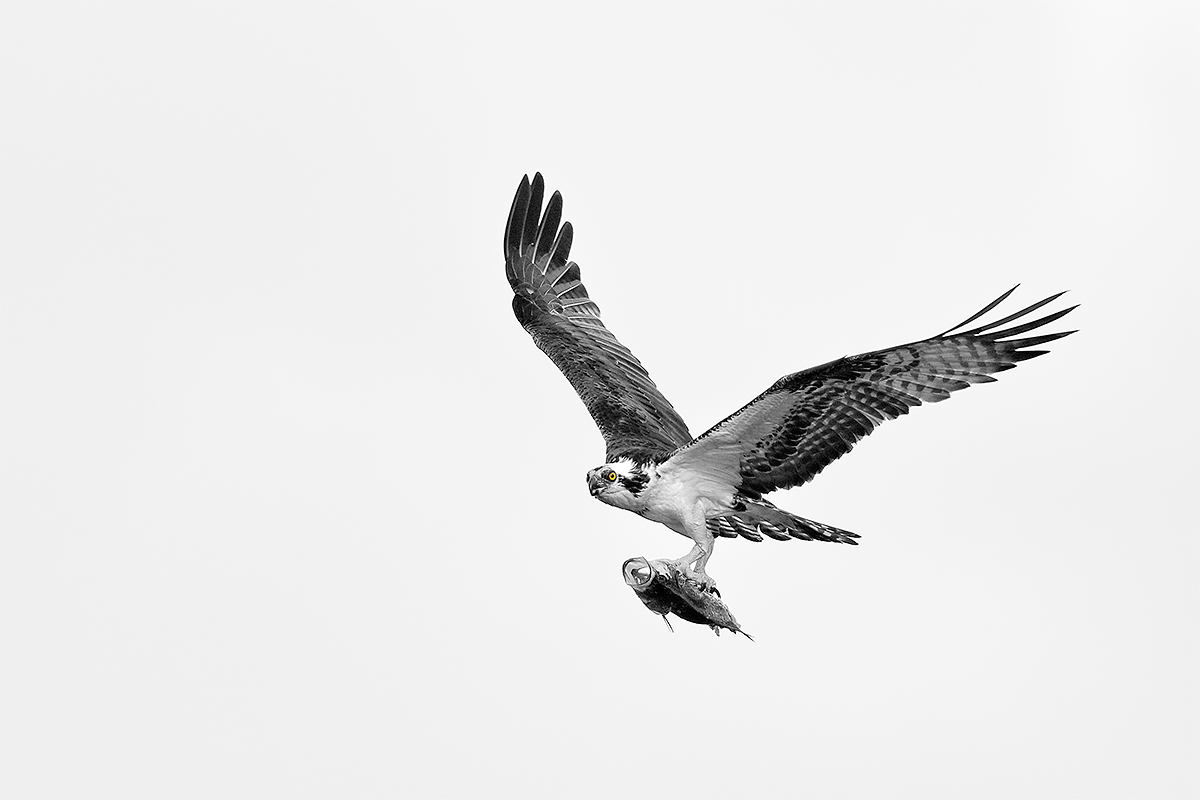
|
Image #2: Osprey black & white NIK Silver EFEX Pro High Structure
|
NIK Silver EFEX Pro
NIK Silver EFEX Pro 2 offers a choice of 38 pre-sets. I often use Neutral (for Image #1), High Structure (for Image #2), and Wet Rocks. Which version do you prefer with today’s image?
Wing Position Question
Which wing position is far less than ideal, the near wing or the far wing? What would have been better?
Osprey Meal Note
Osprey’s normally eat the head of the fish first. This is the first one ever that I saw that ate the tail first. I’d encourage all Ospreys to do the same as the resulting images are far more appealing.
I believe that the fish here is a Largemouth Bass. Corrections or confirmations welcome.
|
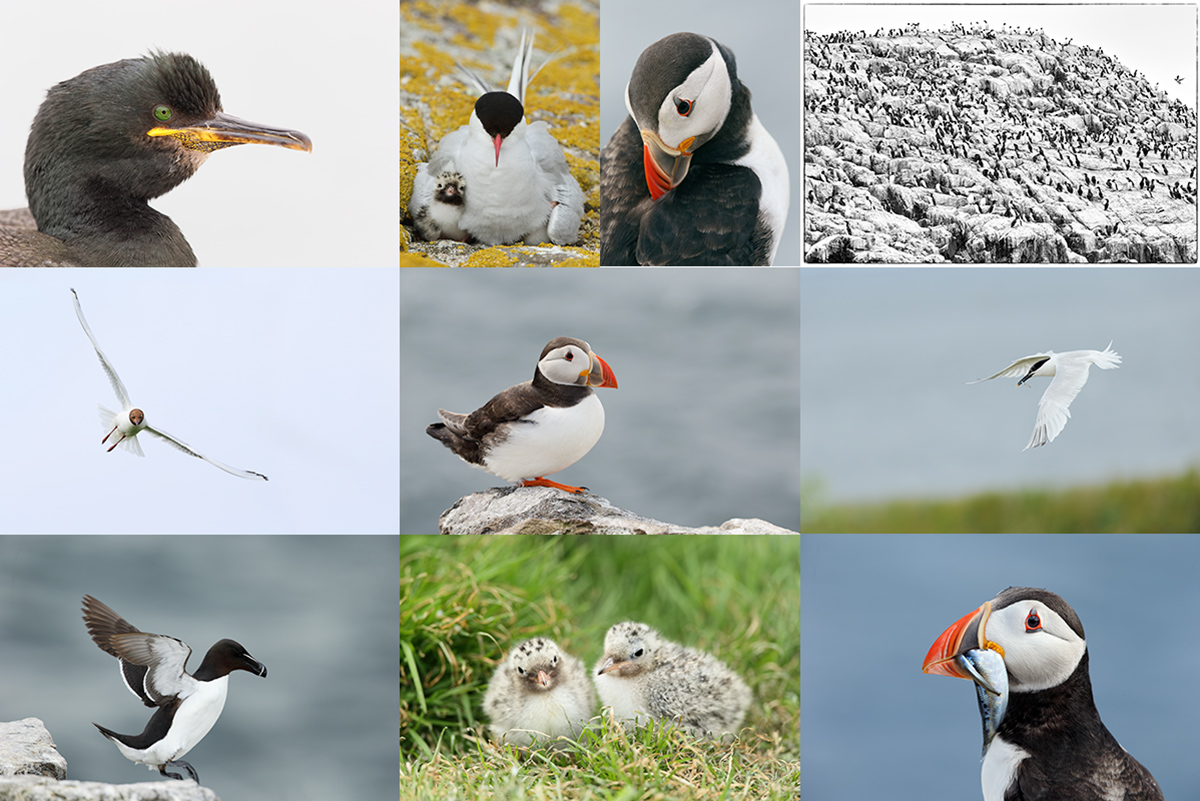
|
|
Images and card design copyright 2014: Arthur Morris/BIRDS AS ART. Click on the card to enjoy a spectacular larger version.
|
Just One Slot Left!
The 2015 UK Puffins and Gannets IPT
June 29 through July 5, 2015: $5499: Limit 10 photographers/One opening due to a recent cancellation. Two great leaders: Denise Ippolito and Arthur Morris.
Here are the plans: take a red eye from the east coast of the US on 28 June arriving in Edinburgh, Scotland on the morning of Monday 29 June (or simply meet us then either at the Edinburgh Airport (EDI) or later in the day at our cottages if you are driving your own vehicle either from the UK or from somewhere in Europe. Stay 7 nights in two gorgeous modern country cottages.
There are 5 days of planned puffin/seabird trips—weather permitting, and 1 full day of gannet photography with 2 sessions on the boat.
|
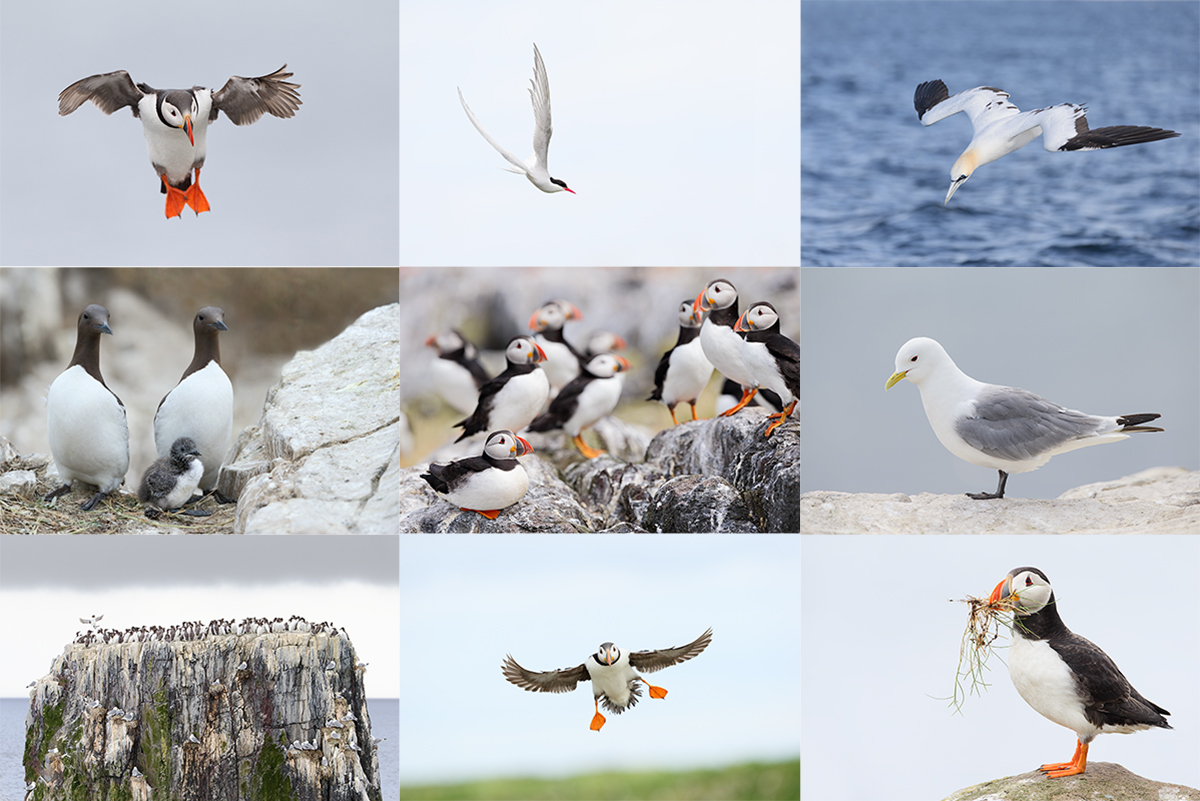
|
|
Images and card design copyright 2014: Arthur Morris/BIRDS AS ART. Click on the card to enjoy a spectacular larger version.
|
The Details
We will be staying in upscale country-side cottages that are beyond lovely with large living areas and lots of open space for image sharing and Photoshop lessons. The shared rooms are decent-sized, each with two roomy single beds and a private bathroom. See the single supplement info below.
All breakfasts, lunches and dinners are included. All 5 puffins boat lunches will need to be prepared in advance, taken with, and consumed at your leisure. I usually eat mine on the short boat trip from one island to the other. Also included is a restaurant lunch on the gannet boat day and a farewell fine dining thank you dinner. The cost of your National Heritage Trust is also included; that covers the twice a day landing fees.
Plan to fly home on the early morning of Monday 6 July or to continue your stay or travels.
|
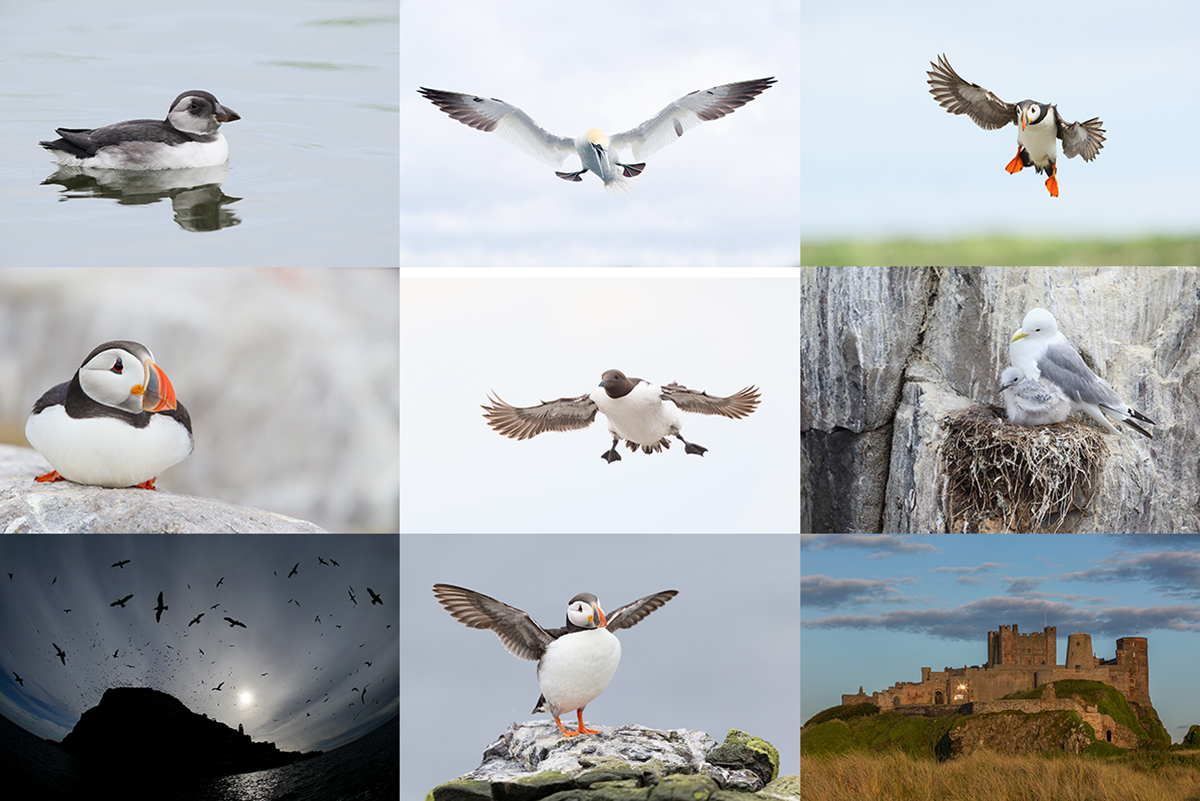
|
|
Images and card design copyright 2014: Arthur Morris/BIRDS AS ART. Click on the card to enjoy a spectacular larger version. Scroll down to join us in the UK in 2015.
|
Single Supplement Info
The single supplement is $1475. As we will be renting a third cottage the $1475 is due with your deposit and is also non-refundable.
If you are good to go please send your $2,000 deposit check now to save a spot. The balance will be due on March 29, 2015. Please make your check out to “Arthur Morris” and send it to Arthur Morris/BIRDS AS ART, PO Box 7245, Indian Lake Estates, FL, 33855. If you cancel and the trip fills, we will be glad to apply a credit applicable to a future IPT for the full amount less a $100 processing fee. If we do not receive your check for the balance on or before the due date we will try to fill your spot from the waiting list. Whether or not your spot is filled, you will lose your deposit. If not, you can secure your spot by paying your balance.
We do hope that you can join us.
Facebook
Be sure to like and follow BAA on Facebook by clicking on the logo link upper right. Tanks a stack!
Support the BAA Blog. Support the BAA Bulletins: Shop B&H here!
We want and need to keep providing you with the latest free information, photography and Photoshop lessons, and all manner of related information. Show your appreciation by making your purchases immediately after clicking on any of our B&H or Amazon Affiliate links in this blog post. Remember, B&H ain’t just photography!
…..
Amazon.com
Those who prefer to support BAA by shopping with Amazon may use this link:
Amazon Canada
Many kind folks from north of the border, eh, have e-mailed stating that they would love to help us out by using one of our affiliate links but that living in Canada and doing so presents numerous problems. Now, they can help us out by using our Amazon Canada affiliate link by starting their searches by clicking here. Many thanks to those who have written.
Typos
In all blog posts and Bulletins, feel free to e-mail or to leave a comment regarding any typos or errors. Just be right :).
April 12th, 2015 Stuff
I went out to Lake Blue Cypress with Clemens van der Werf and his lovely wife Adri. With a west wind and mostly sunny skies it was a tough morning but we worked hard and did find a few good situations. Then it was back to my house for a great lunch of low carb eggplant & haddock parmigiana (made with Romano cheese). That along with a big salad with coconut oil dressing. We ate well and everyone enjoyed it tremendously. Especially the chef. 🙂
Then it was a nap and Masters golf on TV, an afternoon and evening of r & r. This educational blog post, the 94th in a row, took 1 1/2 hours to prepare and was published at one minute after midnight on Sunday.
St. Augustine Short Notice IPT
With just three folks signed up, this trip represents a great opportunity to learn a ton in a great setting. See here for complete details.
South Georgia
Like penguins? Please click here to learn about joining the BIRDS AS ART group on the great Cheesemans’ South Georgia Expedition next October.
New Used Gear Listing
Canon EF 24-70 f2.8L II USM Lens
Dave Bourgaize is offering a used Canon EF 24-70 f2.8L II USM lens in excellent condition for $1499.00. The sale includes front lens cover and rear lens cap, EW-88C lens hood, original Canon bag, and insured shipping via UPS Ground to US addresses. Your item will not ship until your check clears unless other arrangements are made. Please contact Dave by e-mail or by phone at (310) 748-9547 (pacific time zone).
I own and use the 24-70II. It is much sharper edge to edge than the lighter, more versatile Canon EF 24-105mm f/4L IS USM lens. I consider the 24-70II a must for serious landscape photographers. As it sells new for $1899 Dave’s price is lower than any I have seen for this lens in excellent condition. It should sell immediately.
Used Photography Gear
You can see all the current listings here.
|
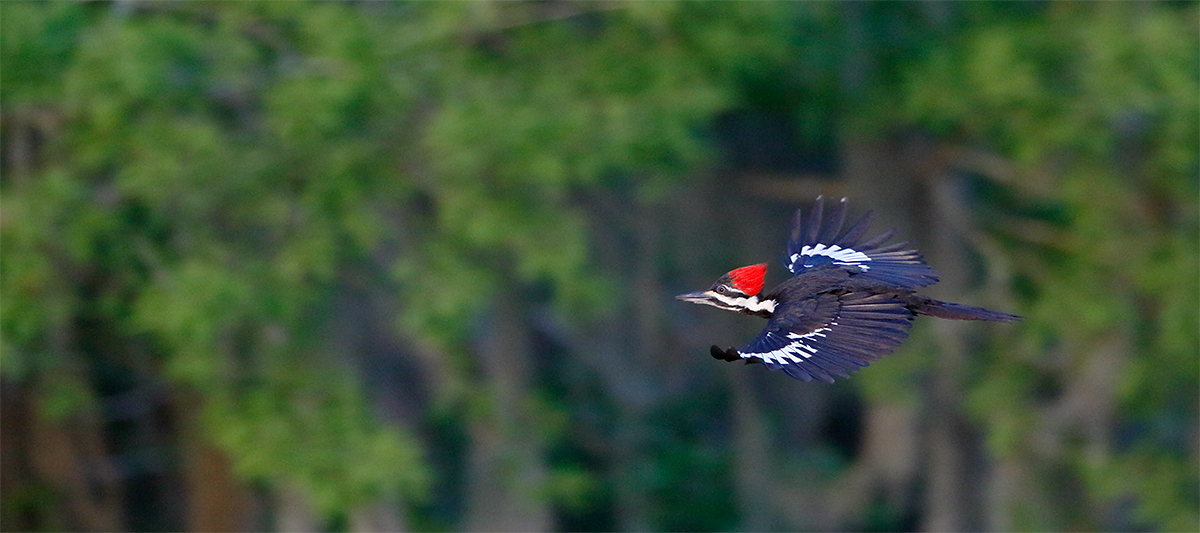
|
|
This image was created at Lake Blue Cypress with the hand held Canon EF 200-400mm f/4L IS USM lens with Internal 1.4x Extender (at 400mm) and the Canon EOS 7D Mark II. ISO 1250. Evaluative metering -1 stop off the green BKGR: 1/800 sec. at f/4 Manual mode. AWB.
Center AF point/AI Servo Expand/Shutter Button AF as framed originally (see below) was active at the moment of exposure (as is always best when hand holding). The active AF point was nowhere near the subject. Click on the image to see a larger version.
Pileated Woodpecker flight pano
|
Honest Opinions Sought…
Considering that the active AF point was active but was nowhere near the bird this image is actually pretty sharp. At ISO 1250 image quality is suspect at best. Not to mention a relatively large crop. And the fact that the bird is angling slightly away…. All that said I sort of like it.
What do you think?
If you do not like the image, just say so, but please remember there is no need to be nasty. More coming soon on civility on the blog. 🙂
|
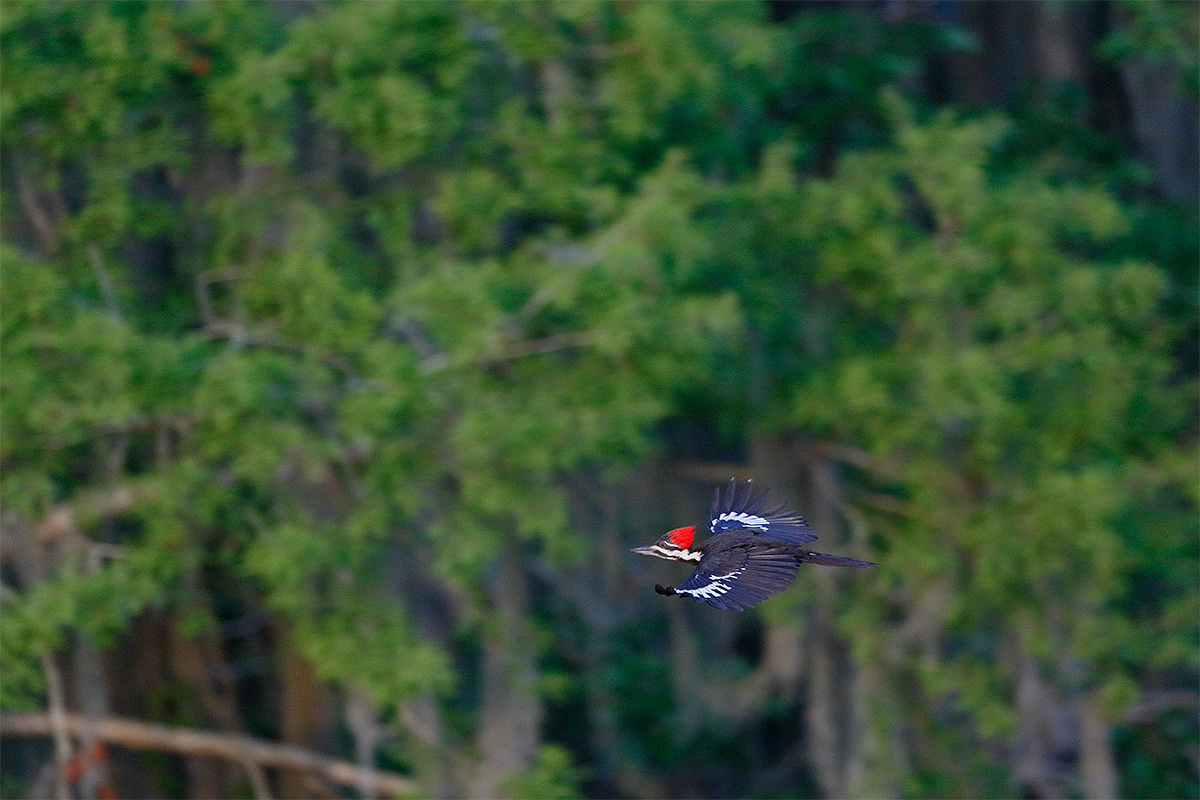
|
|
This is the original frame. Note that the center AF point was both active at the moment of exposure and was nowhere near the subject at the moment of exposure.
|
The Image Optimization
As the dark tones were a mess, I used lots of both luminance and chrominance noise reduction during the RAW conversion in DPP and followed that up with a good dose of Filter > Blur > Surface Blur that I painted away at 50% on the bird using a Regular Layer Mask. Then a bit of Eye Doctor Work, a Contrast Mask to selectively sharpen the whole bird (after selecting it with the Quick Selection Tool), and the pano crop.
All as detailed in the DPP 4 Raw Conversion Guide, Digital Basics, APTATS I, and APTATS II.
|

|
|
Images and card design copyright 2014: Arthur Morris/BIRDS AS ART. Click on the card to enjoy a spectacular larger version.
|
Just One Slot Left!
The 2015 UK Puffins and Gannets IPT
June 29 through July 5, 2015: $5499: Limit 10 photographers/One opening due to a recent cancellation. Two great leaders: Denise Ippolito and Arthur Morris.
Here are the plans: take a red eye from the east coast of the US on 28 June arriving in Edinburgh, Scotland on the morning of Monday 29 June (or simply meet us then either at the Edinburgh Airport (EDI) or later in the day at our cottages if you are driving your own vehicle either from the UK or from somewhere in Europe. Stay 7 nights in two gorgeous modern country cottages.
There are 5 days of planned puffin/seabird trips—weather permitting, and 1 full day of gannet photography with 2 sessions on the boat.
|

|
|
Images and card design copyright 2014: Arthur Morris/BIRDS AS ART. Click on the card to enjoy a spectacular larger version.
|
The Details
We will be staying in upscale country-side cottages that are beyond lovely with large living areas and lots of open space for image sharing and Photoshop lessons. The shared rooms are decent-sized, each with two roomy single beds and a private bathroom. See the single supplement info below.
All breakfasts, lunches and dinners are included. All 5 puffins boat lunches will need to be prepared in advance, taken with, and consumed at your leisure. I usually eat mine on the short boat trip from one island to the other. Also included is a restaurant lunch on the gannet boat day and a farewell fine dining thank you dinner. The cost of your National Heritage Trust is also included; that covers the twice a day landing fees.
Plan to fly home on the early morning of Monday 6 July or to continue your stay or travels.
|

|
|
Images and card design copyright 2014: Arthur Morris/BIRDS AS ART. Click on the card to enjoy a spectacular larger version. Scroll down to join us in the UK in 2015.
|
Single Supplement Info
The single supplement is $1475. As we will be renting a third cottage the $1475 is due with your deposit and is also non-refundable.
If you are good to go please send your $2,000 deposit check now to save a spot. The balance will be due on March 29, 2015. Please make your check out to “Arthur Morris” and send it to Arthur Morris/BIRDS AS ART, PO Box 7245, Indian Lake Estates, FL, 33855. If you cancel and the trip fills, we will be glad to apply a credit applicable to a future IPT for the full amount less a $100 processing fee. If we do not receive your check for the balance on or before the due date we will try to fill your spot from the waiting list. Whether or not your spot is filled, you will lose your deposit. If not, you can secure your spot by paying your balance.
We do hope that you can join us.
Facebook
Be sure to like and follow BAA on Facebook by clicking on the logo link upper right. Tanks a stack!
Support the BAA Blog. Support the BAA Bulletins: Shop B&H here!
We want and need to keep providing you with the latest free information, photography and Photoshop lessons, and all manner of related information. Show your appreciation by making your purchases immediately after clicking on any of our B&H or Amazon Affiliate links in this blog post. Remember, B&H ain’t just photography!
…..
Amazon.com
Those who prefer to support BAA by shopping with Amazon may use this link:
Amazon Canada
Many kind folks from north of the border, eh, have e-mailed stating that they would love to help us out by using one of our affiliate links but that living in Canada and doing so presents numerous problems. Now, they can help us out by using our Amazon Canada affiliate link by starting their searches by clicking here. Many thanks to those who have written.
Typos
In all blog posts and Bulletins, feel free to e-mail or to leave a comment regarding any typos or errors. Just be right :).
April 11th, 2015 Stuff
I had a very relaxing day: acupuncture and core exercises, Masters golf on the tube, and early to bed. I will be joining top student and friend Clemens van der Werf at Lake Blue Cypress tomorrow morning for more Osprey flight photography. If you’d like to get out with Jim Neiger for Ospreys this month please, see yesterday’s blog post here and scroll down.
This educational blog post, the 93rd in a row, took 1 1/2 hours to prepare and was published at one minute after midnight on Saturday.
St. Augustine Short Notice IPT
With just three folks signed up, this trip represents a great opportunity to learn a ton in a great setting. See here for complete details.
South Georgia
Like penguins? Please click here to learn about joining the BIRDS AS ART group on the great Cheesemans’ South Georgia Expedition next October.
|
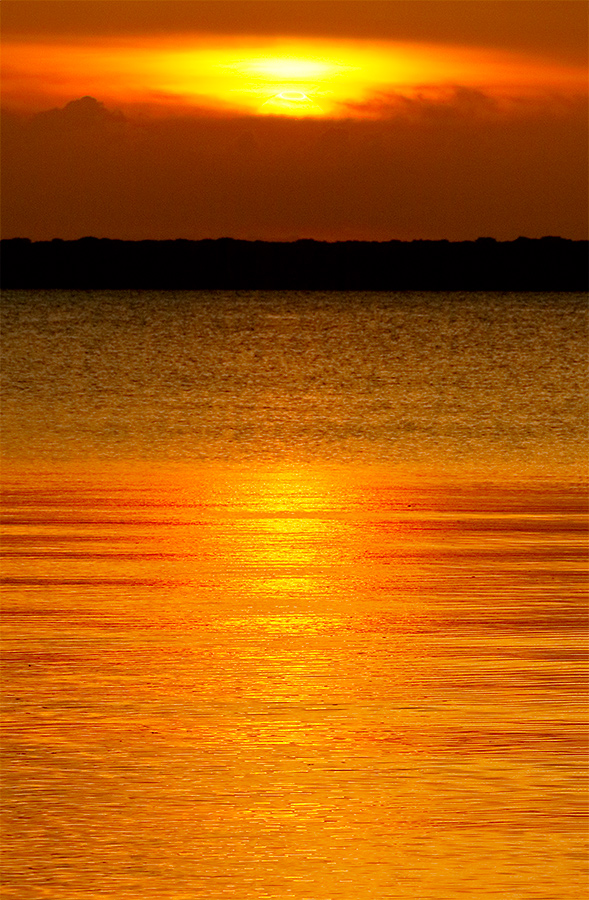
|
|
This image was created at Lake Blue Cypress with the hand held Canon EF 200-400mm f/4L IS USM lens with Internal 1.4x Extender (at 200mm) and the Canon EOS 7D Mark II. ISO 800. Evaluative metering -1 stop: 1/1000 sec. at f/16 in Av mode. Color temperature K8000.
Three AF points below the center AF point/AI Servo Expand/Shutter Button AF as framed was active at the moment of exposure (as is always best when hand holding). Click on the image to see a larger version.
Image #1: Vertical sunset including distant shoreline and faint sun
|
Sunset Strategies With the 200-400 with Internal TC
The sunset was looking potentially like a wide angle monster but the single dense cloud on the horizon provided some nice but concentrated color. I put away the 16-35 and grabbed the 2-4 that I had been using for Osprey flight photograph all day long. For the opening image I went wide and vertical and sharp. For the next image I went much tighter and pan blur. I tried a few others but these were my two faves.
Image Question
For the image above, why would a lower ISO been a much better choice?
|
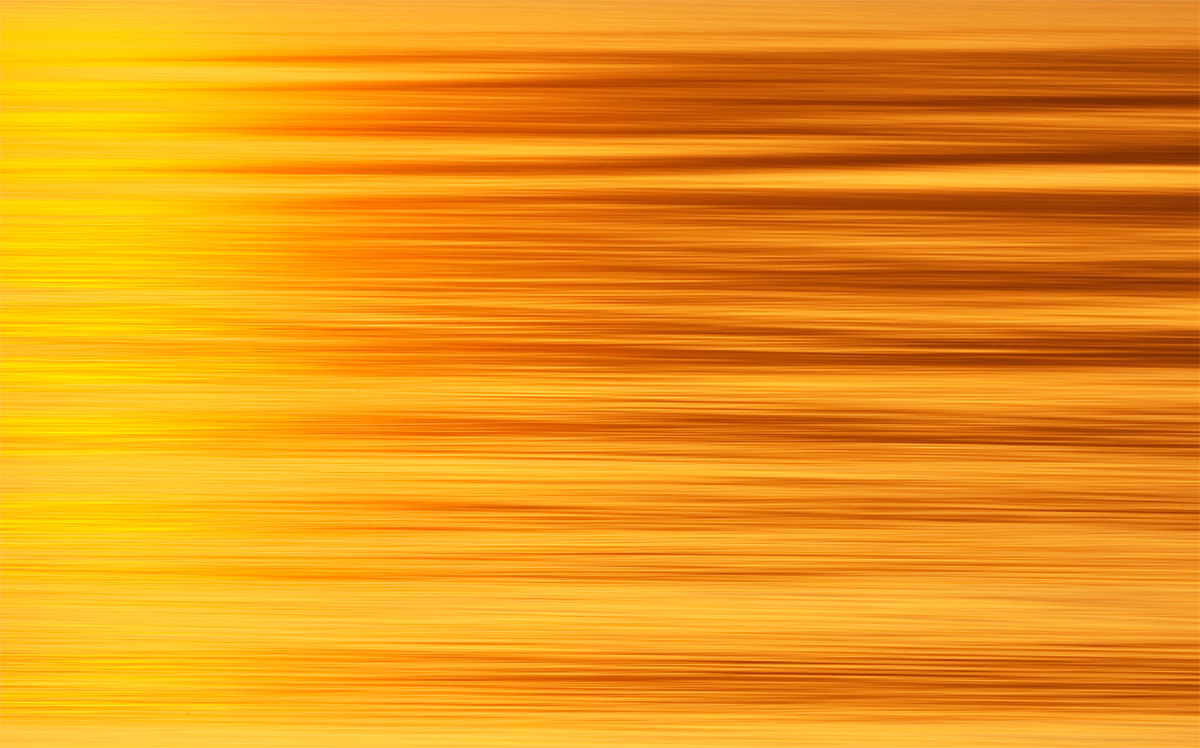
|
|
This image was created at Lake Blue Cypress with the hand held Canon EF 200-400mm f/4L IS USM lens with Internal 1.4x Extender (at 338mm) and the Canon EOS 7D Mark II. ISO 200. Evaluative metering +1/3 stop: 1/15 sec. at f/32 in Tv mode. Color temperature K8000.
Two AF points below the center AF point/AI Servo Expand/Shutter Button AF as framed was active at the moment of exposure. I panned left to right during the exposure trying my best to keep the camera level. Click on the image to see a larger version.
Image #2: Horizontal sunset pan blur
|
Your Favorite?
Which of today’s two images is your favorite? Be sure to let us know why you made your choice.
|

|
|
All of the images in the bear boat card above were created in Katmai National Park during the month of September.
|
Just One Slot Left!
Bear Boat/Bears Catching Salmon IPT: September 1-8, 2015 from Kodiak, AK/6 FULL & 2 1/2 DAYS: $6699. Happy campers only! Maximum 8/Openings: 1. Plus the leader: Arthur Morris.
Join me in Katmai National Park, AK for seven days of photographing Coastal Brown Bears (grizzlies) catching salmon, fattening up for the long winter. Other subjects will include Mew and Glaucous-winged Gulls in flight and dip-feeding on salmon roe. Did I mention that we live on a boat and that the food is great? Most of our photography will be done in a variety of famed locations: Geographic Harbor, Kinak Bay, and Kukak Bay. We once had 39 bears fishing the creek at Kukak….
It is mandatory that you be in Kodiak no later than the late afternoon of August 31, 2015 September to avoid missing the float planes to the boat on the morning of September 1. With air travel in AK being what it is, with the chance of fog or other bad weather–being on Kodiak on August 30 is an even better plan). I will be on Kodiak on August 30 to avoid any potential disaster. That said in my nearly a dozen bear boat trips I was delayed only once but since I was day early as noted above there was no harm, no foul.
We will take one or more float planes to the boat mid-morning on September 1. We will photograph bears fishing that afternoon and every day for the next six days (weather permitting of course). We should have bears catching salmon every day. In addition, we will get some nice stuff on Mew Gull and Glaucous-winged Gulls dining on roe and the remains of predated salmon. We may–depending on where the concentrations of bears are–get to photograph Harbor seals and some hauled out Steller’s Sea Lions (an endangered species). Halibut fishing (license required) is optional. On September 8, our last morning on the boat, those who would like to enjoy one last photo session will do so. The group returns to Kodiak via float plane midday. Most folks will fly to Anchorage and then continue on red-eye flights to their home cities.
The eight days will consist of six full days (Sept 2, 3, 4, 5, 6, & 7) of photography featuring lots of Coastal Brown Bears catching salmon as above plus a variety of other natural history subjects plus some nice scenic photography that I forgot to mention above. Plus the first afternoon and the last morning.
What’s included? 8 DAYS/7 NIGHTS on the boat as above. All meals on the boat. (The food is quite excellent.) National Park fees. One night’s double occupancy lodging on Kodiak; arrive: Sept 1/depart: Sept 2. The thank-you-in-advance dinner on Sept 1. In-the-field photo tips, instruction, and guidance. An insight into the mind of a top professional; I will constantly let you know what I am thinking, what I am doing, and why I am doing it. Small group image review, image sharing, and Photoshop instruction on the boat.
What’s not included: Your round trip airfare to and from Kodiak, AK (almost surely through Anchorage). All necessary lodging other than the cost of your double occupancy room on the night of August 31 should you opt to arrive early–we can arrange that in advance for you. We will let you know the cost of a single supplement for the one night if so desired. The cost of the round-trip float plane to the boat on September 2 and back to Kodiak on September 9. The cost of a round trip this year was $500. The suggested crew tip of $210.
Is this an expensive trip? Yes, of course. But with 6 full and two half days, a wealth of great subjects, and the fact that you will be walking with the bears just yards away (or less….) it will be one of the great natural history experiences of your life. Most folks who take part in a Bear Boat IPT wind up coming back for more.
A $2,000 per person non-refundable deposit by check only made out to “Arthur Morris” is required to hold your spot. Please click here to read our cancellation policy. Then please print, read, and sign the necessary paperwork here and send it to us.
Your deposit is due immediately. That will leave a balance of $4699. The next payment of $2699 will be due on February 15, 2015. The final payment of $2000 is due on May 1, 2015.
I hope that you can join us for this wondrously exciting trip.
Facebook
Be sure to like and follow BAA on Facebook by clicking on the logo link upper right. Tanks a stack!
Support the BAA Blog. Support the BAA Bulletins: Shop B&H here!
We want and need to keep providing you with the latest free information, photography and Photoshop lessons, and all manner of related information. Show your appreciation by making your purchases immediately after clicking on any of our B&H or Amazon Affiliate links in this blog post. Remember, B&H ain’t just photography!
…..
Amazon.com
Those who prefer to support BAA by shopping with Amazon may use this link:
Amazon Canada
Many kind folks from north of the border, eh, have e-mailed stating that they would love to help us out by using one of our affiliate links but that living in Canada and doing so presents numerous problems. Now, they can help us out by using our Amazon Canada affiliate link by starting their searches by clicking here. Many thanks to those who have written.
Typos
In all blog posts and Bulletins, feel free to e-mail or to leave a comment regarding any typos or errors. Just be right :).
April 10th, 2015 Stuff
Two photo sessions on Lake Blue Cypress. No swim, no core exercises, no ice bath. Jim Litzenberg, who joined us on the afternoon outing, is driving us home as I type, online in my Sequoia. After a great morning–see below, the afternoon was rather ordinary with a pretty stiff east breeze making flight photography extremely difficult. We did see two tiny baby Red-shouldered Hawks getting fed by momma but the light was too harsh and the contrast between sun and shadow too great to make anything close to a good image. We did finish the day off with a spectacular golden sunset.
This blog post, the 92nd in a row, took 1 1/2 hours to prepare and was published at one minute after midnight on Friday.
St. Augustine Short Notice IPT
With just three folks signed up, this trip represents a great opportunity to learn a ton in a great setting. See here for complete details.
South Georgia
Like penguins? Please click here to learn about joining the BIRDS AS ART group on the great Cheesemans’ South Georgia Expedition next October.
|
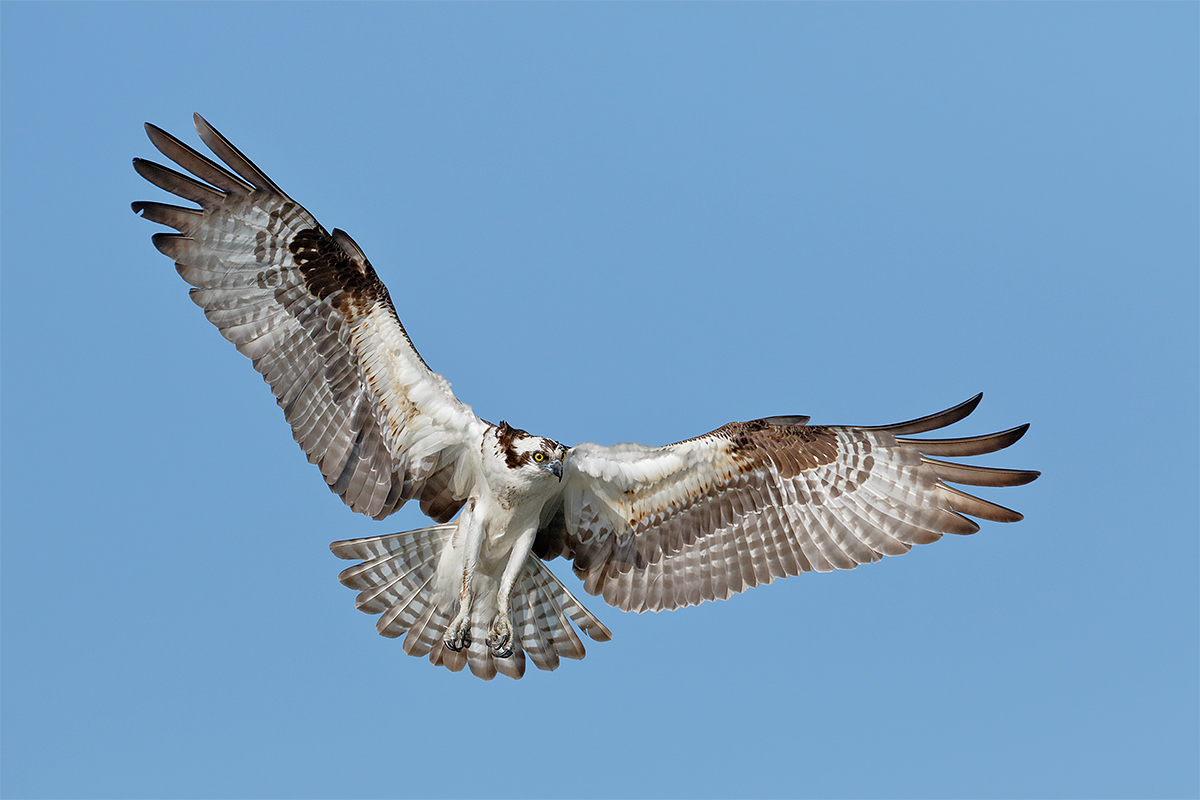
|
|
This image was created at Lake Blue Cypress with the hand held Canon EF 200-400mm f/4L IS USM lens with Internal 1.4x Extender (at 381mm) and the Canon EOS 7D Mark II. ISO 800. Evaluative metering +2/3 stop off the blue sky: 1/5000 sec. at f/5.6. AWB.
Center AF point/AI Servo Expand/Shutter Button AF as originally framed was active at the moment of exposure (as is always best when hand holding). The chosen AF point was squarely on the bird’s face. Click on the image to see a larger version. This is a small crop from the left and below.
Osprey landing. Image copyright 2015: Arthur Morris/BIRDS AS ART
|
The Story
Greg Gulbransen, who is vacationing with his family in Florida, hired Jim Neiger for a day of Osprey photography at Lake Blue Cypress and invited me to tag along. So I did. If you missed the amazing blog post about Greg click here.
It was a beautiful morning but the wind was too north and not enough east. Even though it was not much more than a gentle breeze, the birds were landing and facing away from the light. Do you like butt shots? After an hour or so the wind switched to east/northeast and in addition, we were blessed by some nice big clouds that softened the light.
My Osprey Image
The two things that I like best about my Osprey image (above) are the fully flared wings and the almost perfectly lit underwings. You can just make out the shadow of the bird’s head on the base of the bird’s left wing, but it is quite faint. A very light cloud had taken the edge off the harsh light. Just before that, it had been totally clouded over and I had been working at ISO 800 at 1/1250 sec. at f/5.6. When I saw that the light was coming up I thought of switching to ISO 400 but decided that that would have taken too long so I just went six clicks darker with the Index Finger Wheel and came out smelling like a rose.
My Goal
Every time that I head into the field with a lens I have the same goal: to make one good image. If I succeed at that, then it is OK to get greedy. On the rare occasions that I do not make even one good image, I am never disappointed. Why not? Disappointment is a choice, one that I choose not to make. (See the Work of Byron Katie here; who would you be without your story?.) Greg Gulbransen has the same goal, to make one good one on each outing.
What’s your goal when you head out for a photo session?
After our morning session we headed back to my house at Indian Lake Estates for lunch. After some good chow Greg and I each chose and optimized our favorite image. Mine opens this blog post. Greg’s is immediately above.
Greg’s Image
Greg had been hand holding his Nikkor 600 with the full frame D810 but found that he was clipping too many wings so he went to the 400 f/2.8. I loved this image from the moment I saw it on the back of the camera. It is full frame on the width with just a small crop from the bottom. I love the image design, the open bill, and the slightly motion-blurred wing tips.
Actually, we each wound up with quite a few good ones.
|
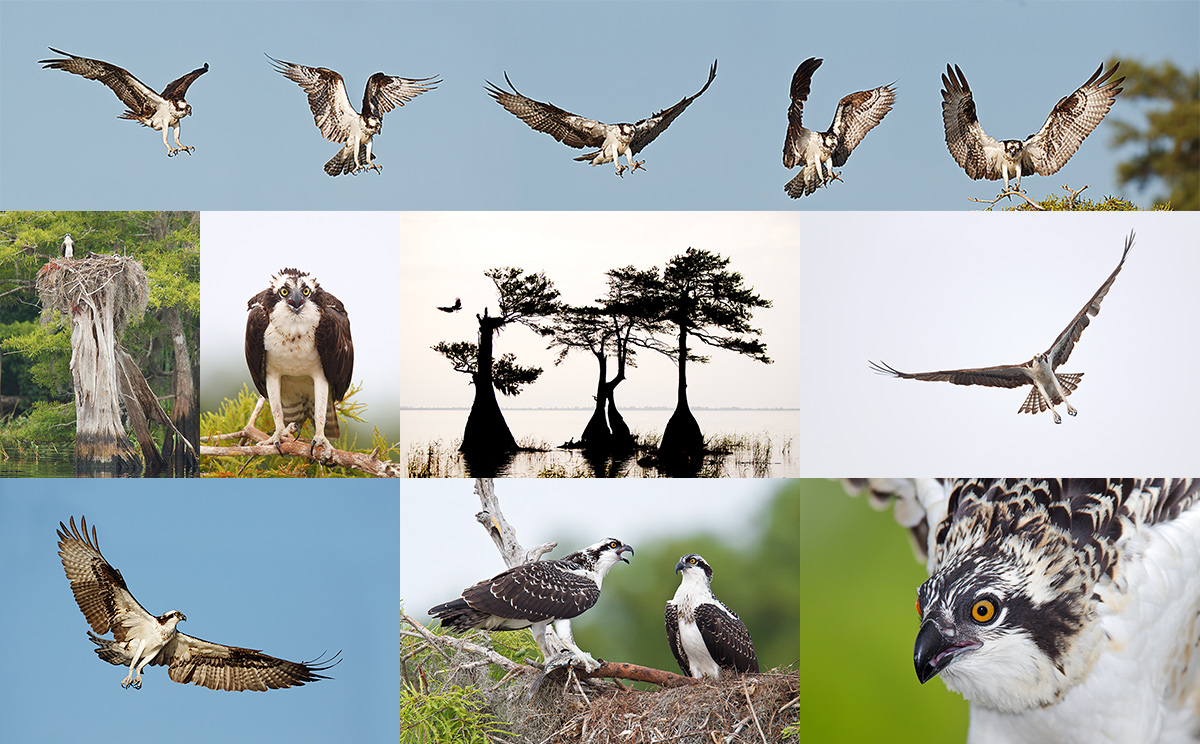
|
|
These are artie’s images from Lake Blue Cypress trips with Jim Neiger.
|
It is not too late!
Jim Neiger’s Osprey Heaven Workshops 2015
Lake Blue Cypress (Vero Beach), Florida
Flight School Photography returns to Lake Blue Cypress for the sixth year and will be featuring three, five day workshops in spring, 2015. The workshops will be conducted by expert bird photographer Jim Neiger, who knows the lake and surrounding area like no-one else. Jim has spent the past several years perfecting his unique techniques for photographing birds in flight using large telephoto lenses, hand held. The focus of these workshops will be learning Jim’s hand held, long lens techniques for photographing birds in flight and in other action. The workshops will be held in some of the most beautiful, wild, and unspoiled wilderness areas of central Florida.
Each workshop will include a four hour classroom session, welcome dinner, four morning photography sessions, and three afternoon photography sessions. Each photography session will be of three to four hours in duration. Five of the photography sessions will be conducted via a specially configured pontoon boat that has been customized for photography from the water (weather permitting). The remaining photography sessions will be land based sessions in the field. The workshops will be limited to five participants so that everyone may photograph in comfort and receive personalized instruction.
The photography sessions by boat will be held on the unspoiled and unparalleled Lake Blue Cypress. This spectacularly beautiful lake is virtually free of civilization and man made elements. The lake is surrounded by ancient cypress swamp and marshy wetlands. Here, the gorgeous cypress trees grow from the lake bottom, surrounded on all sides by water. Osprey nest by the hundreds in these trees, and participants will be able to photograph them as they fly to and fro, dive for fish, gather nesting materials, and feed their young chicks. Some of the nests are actually at or below eye level when standing in the boat. The only distractions in this pristine, wilderness environment are the constant cries of the Osprey as they frolic in the air and defend their nests from other birds.
Lake Blue Cypress is also a landscape photographers dream. The horizons contain nothing of man’s influence and only the beauty of the real Florida wilderness. Perches and backgrounds are spectacular beyond belief. April and May are the best months to be at Lake Blue Cypress. Many of the birds are actively nesting and rearing their young during this time. Wildflowers cover the stumps and trees like blankets of radiant color. The skies glow with spectacular, multi-hued sunrises and sunsets. Hundreds of different species of birds are possible including the typical Florida waders and water fowl. Large Alligators are commonly seen sunning themselves on top of the fallen trees and stumps amidst the colorful wildflowers. The biggest problem for a photographer here is deciding which subject to photograph. Even the weather cooperates at this time of year. It is the dry season and clear, sunny days are the most common weather condition.
The photography sessions on land will be held in remote areas of southern Osceola County. Here, participants are likely to have opportunities to photograph birds that are endangered and rarely seen. Possible species include: Whooping Crane, Swallow-tailed Kite, Great Horned Owl, Barred Owl, and Red-Shouldered Hawk among others. Sandhill Cranes, a common bird in Central Florida, are tame enough to approach as closely as you like. Participants will also learn how to safely use bird song recordings to attract birds. Jim has developed his own, innovative techniques for using recordings to attract birds, in such a way, that amazing photographic opportunities are common when they would be almost impossible otherwise. This includes special techniques that encourage birds to fly and land as desired; this can provide spectacular opportunities for both flight and perched images (with the perches being selected for their beauty).
Jim consistently produces amazing flight images. His imagination and dedication have resulted in his developing many new techniques, techniques that can only be learned from Jim. His Flight School Photography Workshops are a must for any serious nature photographer.
Workshop Dates
Workshop LBC-2: April 13-17, 2015
Workshop LBC-3: April 20-24, 2015
Note: you can set up an Osprey Custom Workshop any time from March 10 through April 30 when Jim does not have a LBC workshop scheduled.
Workshop Costs and Payment
The cost of each workshop is $1750 per person. Each workshop includes a four hour formal classroom instruction session, a welcome dinner, 4 morning photography sessions, and 3 afternoon photography sessions. The photography sessions include personalized instruction in the field. Each participant will receive a copy of Jim’s e-book “Flight Plan – How to Photograph Birds in Flight” when they sign up for the workshop. Discounted lodging is available, but is not included in the workshop fee. A $875 non-refundable deposit is required to reserve a spot in a workshop. The remaining $875 is due 30 days before the start date of the workshop. If you are unable to attend the workshop, after paying the balance, the balance payment will be refunded ONLY if your spot can be filled, on short notice, from the waiting list. All workshop payments must be made by check or money order. Credit cards are not accepted.
Participant Requirements
Participants should have working knowledge of how to create a properly exposed image, a telephoto lens of 400mm or more (300mm with a teleconverter is acceptable), and be physically capable of holding their camera and lens up to their eye in shooting position for at least 20 seconds. Participants must also have a vehicle to travel to and from the photography locations.
Lodging and Logistics
Workshop participants who require lodging during the workshop should stay at the hotel in Vero Beach where the classroom sessions will be conducted. Participants arriving via air arrive at the Orlando International Airport, which is the closest major airport to Vero Beach. Rental vehicles are available at the airport. Flight School Photography will assist participants with arranging the sharing of vehicles and/or lodging if desired. Detailed information will be provided when you sign up for the workshop or upon request. Lodging, transportation, and meals (except for welcome dinner) are not included.
Learn more here. View Jim’s incredible image gallery here. And see some of artie’s images here.
|
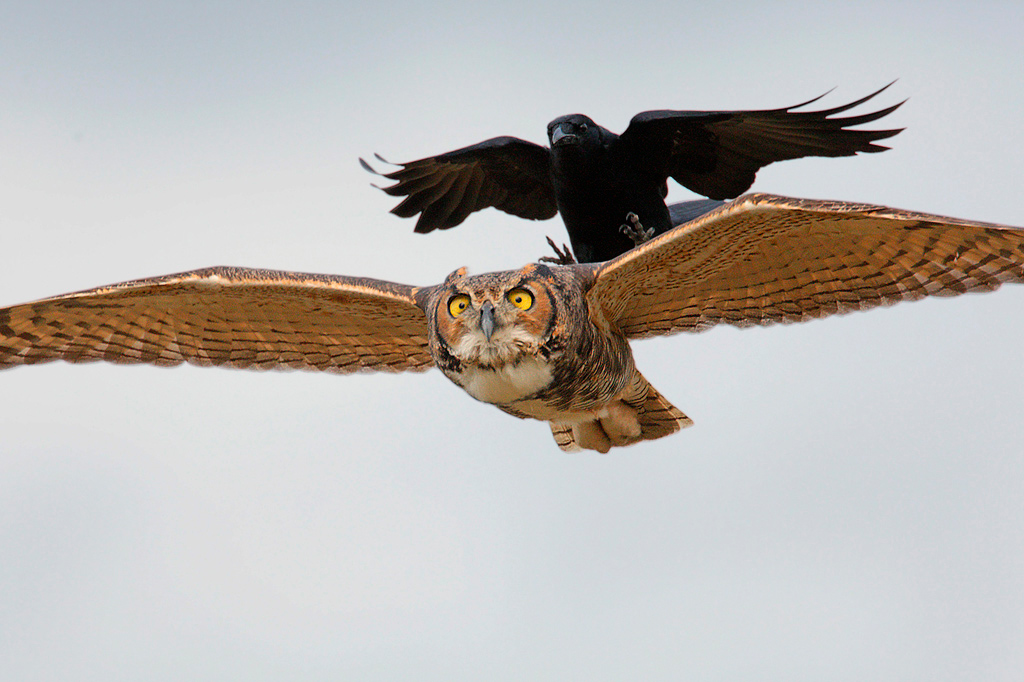
|
|
Great Horned Owl being harassed by Fish Crow. BBC Honored image copyright: Jim Neiger/Flight School Photography
|
Flight School Custom Anytime Workshops
Flight School Photography offers private, customized workshops, September thru May, in some of the most beautiful, wild, and unspoiled areas of central Florida. Your instructor and guide, Jim Neiger, has spent several years observing, studying, and photographing the varied birds near his home in central Florida and knows this avian rich area like no one else. If you prefer, Jim will travel to a location selected by you to provide personal instruction.
These individual or small group workshops are tailored exclusively to the participants’ interests, goals, and schedule. Workshops are conducted by boat, on land, or a combination of both. Personalized instruction lets you make the most of your time. The workshops can range from a single half-day workshop to multi-day or week-long workshops. Snacks and drinks are provided during every workshop session.
You have the following options: scheduling a private, individual custom workshop; putting together a small group of photographers for a customized workshop; or having Jim travel to your location to provide a custom workshop. You can also choose the species you wish to focus on and/or the topics you would like to learn more about. Jim’s experience in the central Florida area allows him to locate the most sought after species in settings and conditions that are optimal for photography.
|

|
|
Jim’s Custom Workshops offer a great variety of desirable subjects.
|
Custom Workshops by Boat
Jim’s pontoon boat was purchased and customized specifically for use during photography workshops. It is roomy, comfortable, and stable. The boat is equipped with an extremely quiet, four-stroke motor for silent cruising. It also has a powerful, silent, electric trolling motor with wireless remote control. This allows Jim to position the boat precisely and silently. The boat has a capacity of twelve people, but Jim limits the number of participants to five or less so that everyone has room to photograph in comfort. The boat can be configured with no top, a half canopy to provide shelter from sun and rain, or with a half enclosure that can completely protect participants from the elements. Using the boat allows close access to some of the most difficult and desirable subjects in North America. Many of the images of these subjects in their wetland habitat would not be possible from land.
Note: you can set up an Osprey Custom Workshop any time from March 10 through April 30 when Jim does not have a LBC workshop scheduled.
Custom Workshops on Land
Land-based sessions are held in a number of wild and remote locations of central Florida. Jim has spent several years learning the out-of-the-way wilderness areas in the region. He has also written a best selling guide to photographing birds in central Florida. The variety of birds in the area is astounding, and Jim knows where to find them and how best to photograph them. Participants will need to provide their own vehicle for the land-based workshops, unless there is only 1 photographer.
Both land and boat workshops are likely to provide participants with opportunities to photograph birds that are uncommon and rarely seen. Possible subjects include: Crested Caracara, Sandhill Cranes, Whooping Cranes, Barred and Great Horned Owls, Bald Eagles, Osprey, Snail Kites, Red-Shouldered Hawks, Red Cockaded Woodpeckers, Pileated Woodpeckers, Limpkins, Ibis, Wood Storks, Purple Gallinules, various wading birds, warblers, sparrows, and many others too numerous to list.
Custom Workshop Instruction
Custom workshops may also include personalized, in-the-field instruction; formal classroom instruction; or an introductory slide presentation, if desired. Topics may include instruction devoted to learning or practicing:
· Jim’s unique handheld techniques for photographing birds in flight using long telephoto lenses.
· Jim’s unique techniques for using recordings safely to attract and photograph birds successfully
· Making proper exposures working in manual exposure mode
· Other nature photography topics of your choice
Learn more about Jim’s Flight School Custom Anytime Workshops here. See the spectacular image gallery here. See the custom workshop rates here.
Contact Information
Contact Information: Jim Neiger, Flight School Photography, Inc. 550 Basin Drive, Kissimmee, FL 34744-4804
Cell phone: (407) 247-5200. e-mail.
Flight School website.
Flight Plan
I can say without a doubt that after spending more than two months (part time) editing Jim Neiger’s great e-Guide, Flight Plan, that my flight photography has improved by leaps and bound whether I am working off a tripod or hand holding. His explanation of the bumping the focus technique finally sunk in. Learning to use this technique regularly is a huge help for any all types of flight photography.
You can learn more about Flight Plan here or order a copy by clicking here.
Bob Hollowell’s Flight Plan Comments
I just wanted to send kudos to both you and Jim Neiger for the excellent E-book that you referenced in a recent BAA blog post. I immediately purchased a copy, and have finished my first read and will now read it a second time just to make sure I’m ready to take it to the field. My favorite haunt is Squaw Creek NWLR and I’ve stumbled & fumbled with flight photos using both tripod & monopod as support for my Canon 7D, and just can’t seem to come up with real sharp photos using that method. Jim’s text is well written, and really puts flight photography in a whole new perspective for me. I’m 76 years old, and I’m sure I’ll have to experiment with the handholding methodology a bit, but I’m excited at the prospect of applying Jim’s methods.
Thanks again… Bob H.
Facebook
Be sure to like and follow BAA on Facebook by clicking on the logo link upper right. Tanks a stack!
Support the BAA Blog. Support the BAA Bulletins: Shop B&H here!
We want and need to keep providing you with the latest free information, photography and Photoshop lessons, and all manner of related information. Show your appreciation by making your purchases immediately after clicking on any of our B&H or Amazon Affiliate links in this blog post. Remember, B&H ain’t just photography!
…..
Amazon.com
Those who prefer to support BAA by shopping with Amazon may use this link:
Amazon Canada
Many kind folks from north of the border, eh, have e-mailed stating that they would love to help us out by using one of our affiliate links but that living in Canada and doing so presents numerous problems. Now, they can help us out by using our Amazon Canada affiliate link by starting their searches by clicking here. Many thanks to those who have written.
Typos
In all blog posts and Bulletins, feel free to e-mail or to leave a comment regarding any typos or errors. Just be right :).
April 9th, 2015 What’s Up?
Got down to the lake this morning and had fun. Enjoyed a nice swim, my core exercises, and an ice bath. And an acupuncture session. Getting ready to watch the Masters tomorrow. Still catching up on lots of loose IPT ends. This blog post, the 91st in a row, took 1 1/2 hours to prepare and was published at one minute after midnight on Thursday.
|
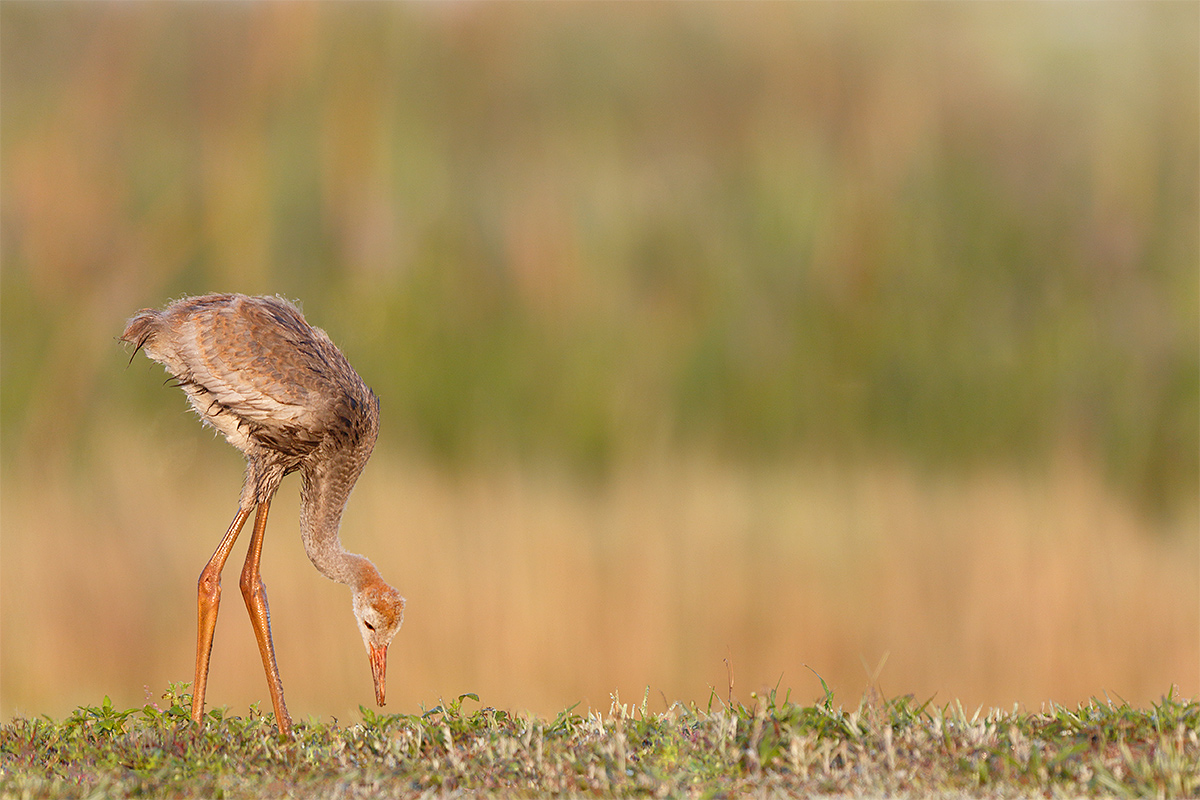
|
|
This image was created from my SUV at Indian Lake Estates, FL with the BLUBB-supported Canon EF 600mm f/4L IS II USM lens and the Canon EOS 7D Mark II. ISO 400. Evaluative metering +1/3 stop: 1/1000 sec. at f/4 in Av mode. AWB.
Four AF points to the left and one row down from the center AF point/AI Servo/Surround/Shutter Button AF as framed was active at the moment of exposure. Be sure to see the screen capture below to learn more. Click on the image to see a larger version.
Sandhill Crane colt foraging/early morning light, Indian Lake Estates, FL
|
When working in horizontal format, keep the bird out of the middle of the frame!
Nobody gives a rat’s ass what’s going on behind the bird. Many beginners and more than a few intermediate photographers rely on using the center AF point and as a result their birds are often too centered. Learn to move the active aF point around the array by consulting your camera body manual or by studying the info in one of our many User’s Guides. Study our User’s Guides to learn which AF Area Selection Mode is best for different purposes. Learn more about our User’s Guides here. Choose an AF point that will place the bird well back in a horizontal frame, that will give the bird room in front of it, room to see and someplace to go. To do that with today’s young crane I opted to use Surround. See more on that in the screen capture below.
Note: with larger-in-the-frame birds Zone or 65-point may do the job just as well. The trick is to learn to use which one. Be sure to study each image that is presented on the blog and to study your User’s Guides.
|
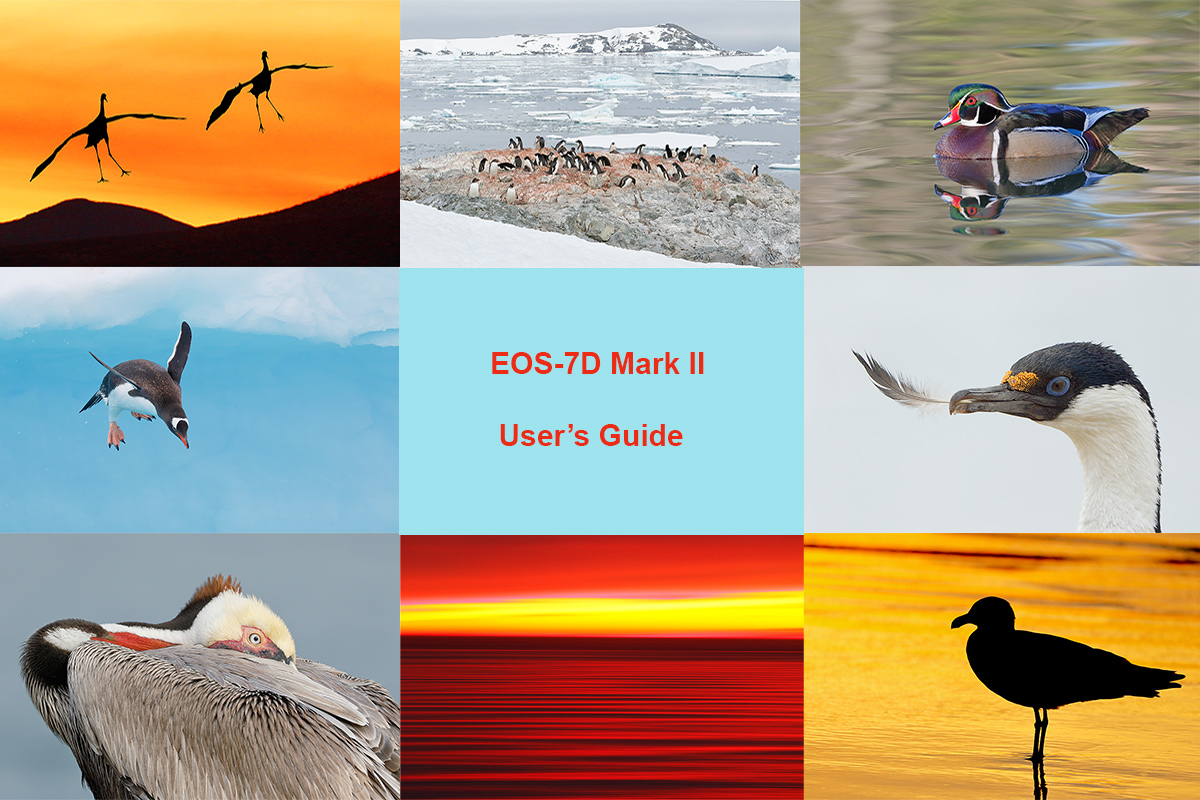
|
|
You can purchase your copy of the The 7D Mark II User’s Guide right now in the BAA Online Store here for $59.
|
7D Mark II User’s Guide Now Available
Learn everything that you need to know to get the most out of your new 7D Mark II. Why spend weeks trying to figure things out on your own or trying to figure out the camera body manual? I did all of that for you. It took me months. I not only tell you how to change the various settings but I explain when and why to use each one….
|
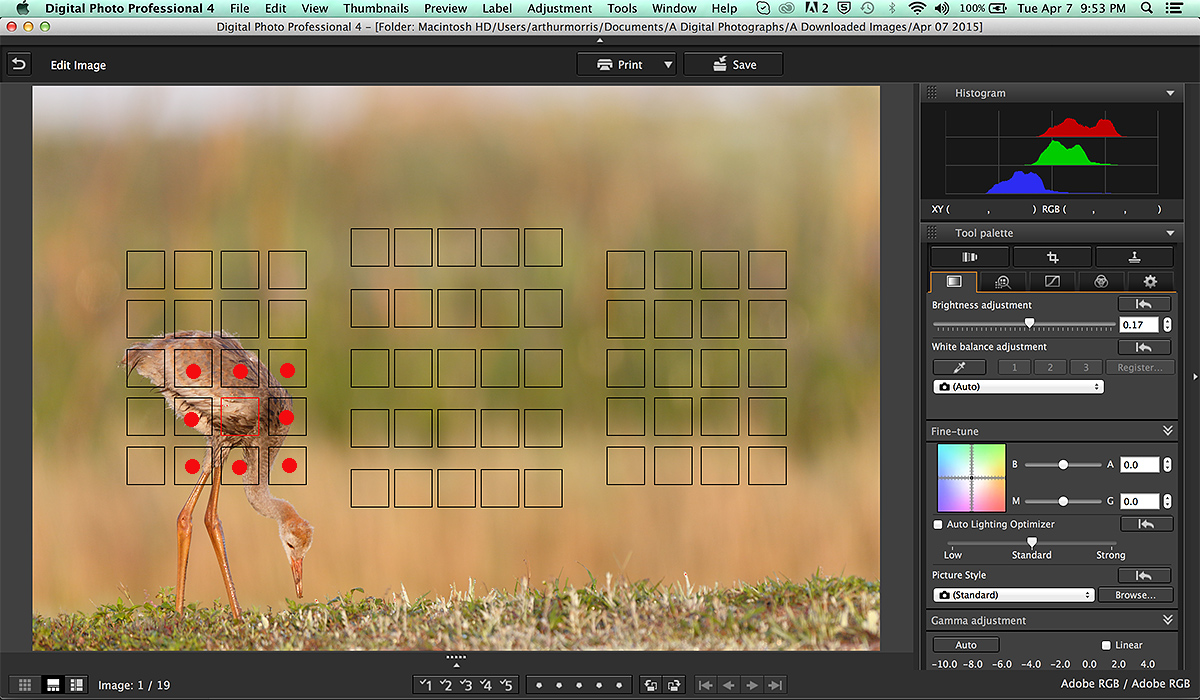
|
DPP 4 screen capture
|
DPP 4 Screen Capture
The illuminated red square shows the AF point that I selected manually. I added the eight red circles using the rarely-used Pencil Tool to show which additional points are activated when you opt to use the Surround AF Area Selection Mode. I love to use Surround or Expand to keep a subject back in the frame. If they reverse direction I simply hit the Grid button and more the selected point to the opposite side of the frame. With either Surround or Expand only the selected point ever shows as active (even if it was actually one of the additional points that did the trick).
The Image Optimization
The RAW files for today’s images was of course converted in DPP 4 and optimized in Adobe Photoshop Creative Cloud.
Digital Basics
Everything that I did to optimize today’s image is covered in detail in our Digital Basics File–written in my easy-to-follow, easy-to-understand style. Are you tired of making your images look worse in Photoshop? Digital Basics File is an instructional PDF that is sent via e-mail. It includes my complete digital workflow, dozens of great Photoshop tips, details on using all of my image clean-up tools, the use of Contrast Masks, several different ways of expanding and filling in canvas, all of my time-saving Keyboard Shortcuts, Quick Masking, Layer Masking, and NIK Color Efex Pro basics, Contrast Masks, Digital Eye Doctor techniques, using Gaussian Blurs, Tim Grey Dodge and Burn, a variety of ways to make selections, how to create time-saving actions, the Surface Blur (background noise reduction) settings, and tons more.
APTATS I & II
Learn the details of advanced Quick Masking techniques in APTATS I. Learn Advanced Layer Masking Techniques in APTATS II. Mention this blog post and apply a $5 discount to either with phone orders only. Buy both APTATS I and APTATS II and we will be glad to apply at $15 discount either with phone orders or here in the BAA Online Store. For phone orders, call Jim or Jennifer at 863-692-0906 weekdays.
|

|
|
You can order your copy of “The Photographers’ Guide to Canon Digital Photo Professional 4.0” (aka the DPP 4 Raw Conversion eGuide) by Arash Hazeghi and Arthur Morris by clicking here.
|
The DPP 4 eGuide (PDF)
Learn how and why I and many other discerning photographers choose and use only DPP 4 to convert their Canon RAW files in the DPP 4 RAW Conversion Guide by Arash Hazeghi and yours truly. The latest version supports all of the newer Canon camera bodies and several older models including the EOS-7D and the EOS-1D Mark IV. A free update that will cover most of the newly added cameras will be sent in a week or two. See upcoming blog posts for exact details.
|

|
|
Clockwise from upper left to center: Snowy Egrets/breeding plumage pair, American Alligator with egret feather on head, Cattle Egret in breeding plumage (with fill flash), large Snowy Egret chicks, displaying gator, Wood Stork in flight carrying nesting material (fill flash), begging Snowy Egret chick, another Cattle Egret in breeding plumage (with fill flash), and Great Egret chick.
|
Date Change: St. Augustine Alligator Farm Short-Notice Spoonbill and Wading Bird Chicks IPT: May 4-6, 2015.
St. Augustine Alligator Farm Short-Notice Spoonbill and Wading Bird Chicks IPT: May 4-6, 2015. TWO FULL and TWO 1/2 DAYS: $1099. Limit 8/Openings 5.
St. Augustine in early May is a bird photographer’s paradise. With any luck we should have chicks of all sizes in the nests ranging from newly hatched Snowy Egrets and Tricolored Herons to nearly fledged Great Egrets. More than a few pairs of Roseate Spoonbills have nested at the Alligator Farm for the past several years. Photographing the spoonbill chicks in the nest is a huge challenge…. With any luck we will encounter a few Snowy and Cattle Egrets in stunning breeding plumage. We should have lots of flight photography ops especially late in the day. We will enjoy extra early entry on our three mornigs. Folks who will need a photographer’s pass ($89.95 includes full season early entry and late stay and submission fees for up to 5 photos in their annual contest; this works out to cheaper than four separate entry tickets). We will have those ready for pick-up on the first afternoon.
|

|
|
Clockwise from upper left: flash-as-main light Great Egret chick begging, breeding plumage Cattle Egret w/fill flash, Little Blue Heron, Great Egret chick in nest begging, Cattle Egrets copulating, Wood Stork with nesting material, another Wood Stork with nesting material, and breeding plumage Snowy Egret displaying.
|
What You Will Learn
On this IPT you will the learn the basics and fine points of digital exposure and how to get the right exposure every time after making a single test exposure. You will learn to understand and predict bird behavior and to see and understand the light. You will learn to design pleasing images by mastering your camera’s AF system and how and why to work in Manual mode (even if you’re scared of it). Most importantly, you will learn to spot the good situations, to choose the best perspective. Rookeries are crowded, cluttered, white-washed places. Most folks who visit have no clue as to the difference of an image with tons of distractions and one with a clean line of sight and the best possible distant background. Join me and I will teach you to see like a pro.
I will be bringing my flash to the Alligator Farm (gasp!) I have not used flash for at least a year. I will be teaching you how to use flash as fill and how to use flash as main light. In addition, I will be reviewing the flash flight techniques that I developed at St. Augustine more than a few years ago.
|

|
|
Clockwise from upper left: gator back, Great Egret returning to mate (with fill flash), Roseate Spoonbill with bill open, Roseate Spoonbill chick begging, Roseate Spoonbill 11am silhouette, large Great Egret chicks in nest, and bill of Roseate Spoonbill.
|
Whats the Rest of the Deal?
Afternoon session on Monday, May 4. Then two full days with a morning and afternoon session each day, May 5 & 6. Then our last morning on May 7. At lunch on Tuesday and Wednesday (included) we will review my images; folks learn a ton watching me edit–why keep this one and delete that one? If you opt to bring your laptop, we can take a look at five of your best images from the morning or another session. We will process a few of my images in Photoshop after converting them in DPP. That followed by Instructor Nap Time.
A $499 non-refundable deposit is required to hold your spot. Your balance–$600, payable only by check, is due immediately. Please include a separate check for $89.95 so that we can purchase your pass in advance. Please click here to read our cancellation policy before committing. Then please print, read, and sign the necessary paperwork linked to here and get it to us. You can register by calling Jim or Jen at the office at 863-692-0906 and arranging for your deposit of $499. Balances are payable only by check. I hope to see you there.
Facebook
Be sure to like and follow BAA on Facebook by clicking on the logo link upper right. Tanks a stack!
Support the BAA Blog. Support the BAA Bulletins: Shop B&H here!
We want and need to keep providing you with the latest free information, photography and Photoshop lessons, and all manner of related information. Show your appreciation by making your purchases immediately after clicking on any of our B&H or Amazon Affiliate links in this blog post. Remember, B&H ain’t just photography!
…..
Amazon.com
Those who prefer to support BAA by shopping with Amazon may use this link:
Amazon Canada
Many kind folks from north of the border, eh, have e-mailed stating that they would love to help us out by using one of our affiliate links but that living in Canada and doing so presents numerous problems. Now, they can help us out by using our Amazon Canada affiliate link by starting their searches by clicking here. Many thanks to those who have written.
Typos
In all blog posts and Bulletins, feel free to e-mail or to leave a comment regarding any typos or errors. Just be right :).
April 8th, 2015 What’s Up
Swim and ice bath. Lots of office work. Congrats to Geno Auriemma on his 10th Lady’s NCAA championship. The Lady Huskies could not hit a basket till late in the second half but held off a game Notre Dame team rather easily. This blog post, the 90th in a row, took about 2 hours to prepare; it was published just after midnight early on Wednesday morning.
|
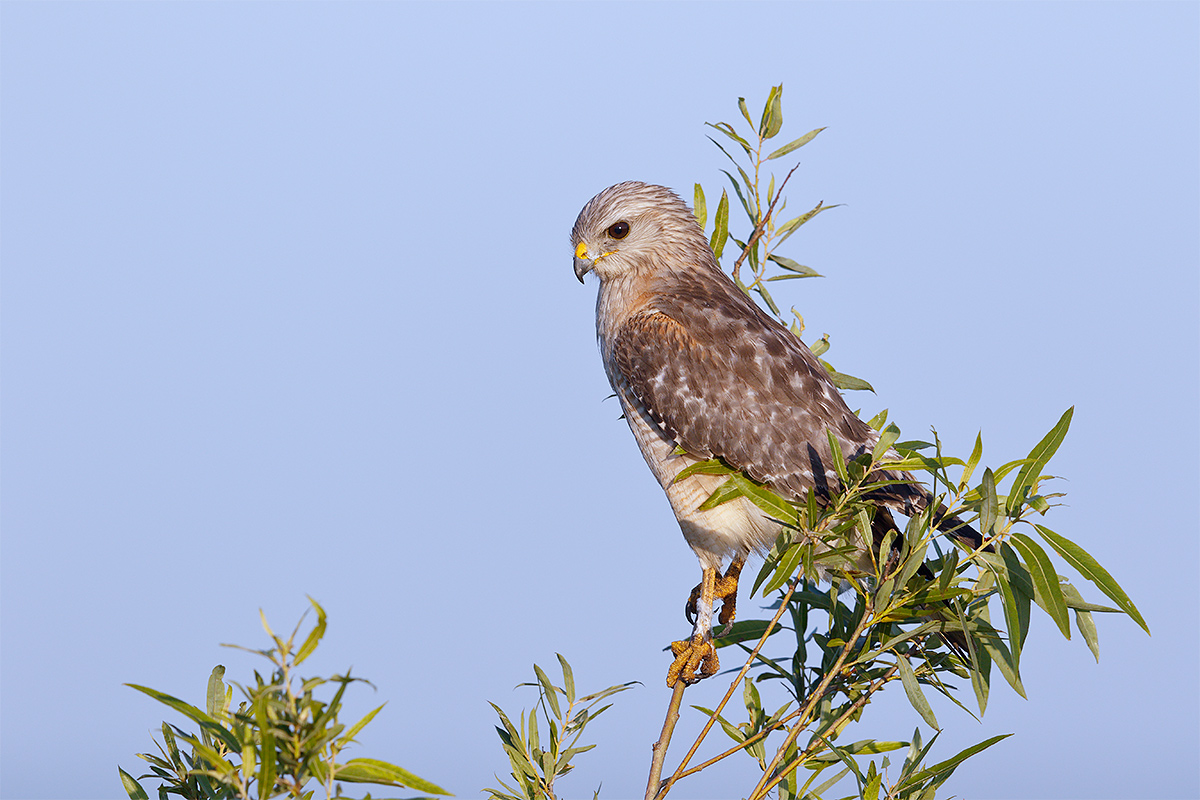
|
|
This image was created from my SUV at Indian Lake Estates, FL with BLUBB-supported Canon EF 600mm f/4L IS II USM lens and which camera body? ISO 400. Evaluative metering +1 stop: 1/2000 sec. at f/4.5 in Manual mode.
Three AF points up from the center AF point/AI Servo/Rear Focus AF on the bird’s eye and release. Click here to see the latest version of the Rear Focus Tutorial. Click on the image to see a larger version.
Image #1: Red-shouldered Hawk
|
Down By the Lake
I am gonna make an effort to get the gear in the car and get down to the lake every sunny morning. Right now there are several half-grown Sandhill Crane colts along with a pair of still-small chicks. Along with a very few other photographable species like Red-shouldered Hawk (above) and Mottled Duck (below). Other possibilities include Bald Eagle, Turkey and Black Vultures, Limpkin, and Wild Turkey.
|
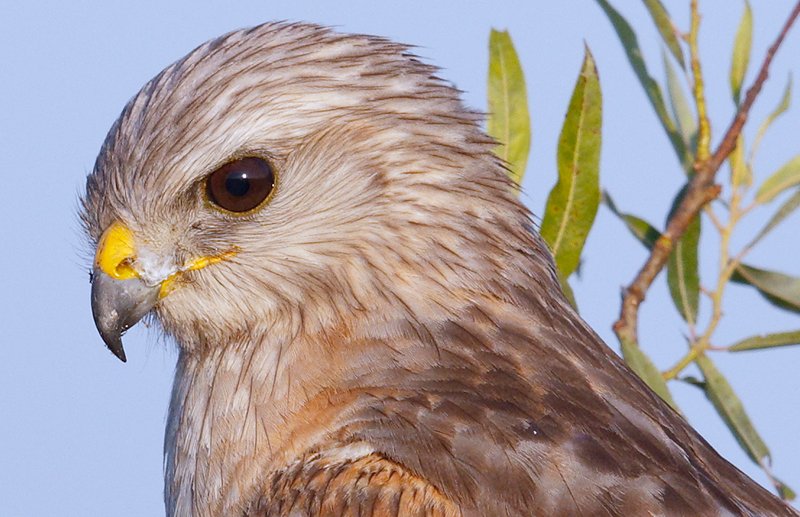
|
Unsharpened 200% view of hawks head
|
Making Sharp Images Off the Blubb
It is best when working off the Blubb to have AF active at the moment of exposure to ensure that your accidentally moving the lens does not throw off accurate focus…. Rotating the lens even a fraction of a single degree will always ruin an image as it will effectively turn the focus ring. In the opening image I framed the image, pressed the rear button to focus, released the rear button, and made the image without moving the lens at all. As you can see in the 200% crop immediately above, careful technique created an extremely sharp image.
With the image below–made with the2X III TC on an f/4 lens–I was working with a minimum effective aperture of f/8 and was thus limited to the center AF point. Note: by pushing the grid button you can add the four expand points. If I had kept AF active at the moment the duck would have been way too far forward in the frame with the bill near or touching the right frame edge. So I took a gamble, rear button focused on the duck’s eye, and re-composed carefully making absolutely sure not to rotate the lens at all as I shifted the lens down and to the right. The proof is in the sharp eye.
|
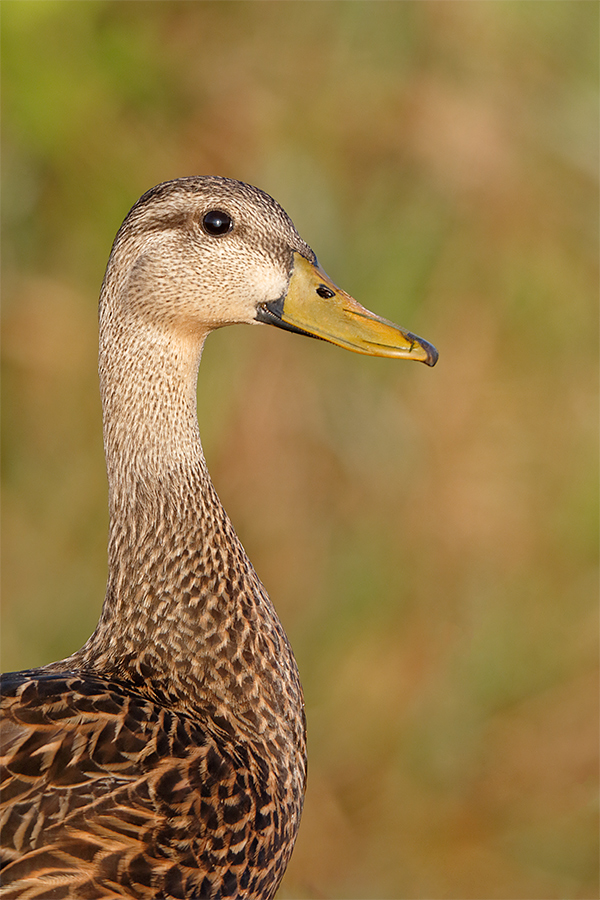
|
|
This image was created from my SUV at Indian Lake Estates, FL with BLUBB-supported Canon EF 600mm f/4L IS II USM lens, the Canon Extender EF 2X III, and which camera body? ISO 400. Evaluative metering -1/3 stop: 1/500 sec. at f/9.
Center AF point (by necessity)/AI Servo Expand/Rear Focus AF on the duck’s face and re-compose. Click here to see the latest version of the Rear Focus Tutorial. Click on the image to see a larger version.
Image #2: Mottled Duck head and shoulders vertical portrait
|
You’re On the Spot: Image Quality/Which Camera Quiz
In the recent blog post here, both John Giatropoulos and Steve Soderling left comments to the effect that they were able to distinguish 1D X and 7D II images based on image quality.
They, and everyone else here, are invited to leave a comment and let us know which of today’s images were created with a 1D X and which were created by a 7D II. And they are of course welcome to let us know why they made their choices.
There will be lots more like this in the coming weeks.
|

|
|
All of the images in the bear boat card above were created in Katmai National Park during the month of September.
|
Just Two Slots Left!
Bear Boat/Bears Catching Salmon IPT: September 1-8, 2015 from Kodiak, AK/6 FULL & 2 1/2 DAYS: $6699. Happy campers only! Maximum 8/Openings: 2. Plus the leader: Arthur Morris.
This trip is a go.
Join me in Katmai National Park, AK for seven days of photographing Coastal Brown Bears (grizzlies) catching salmon, fattening up for the long winter. Other subjects will include Mew and Glaucous-winged Gulls in flight and dip-feeding on salmon roe. Did I mention that we live on a boat and that the food is great? Most of our photography will be done in a variety of famed locations: Geographic Harbor, Kinak Bay, and Kukak Bay. We once had 39 bears fishing the creek at Kukak….
It is mandatory that you be in Kodiak no later than the late afternoon of August 31, 2015 September to avoid missing the float planes to the boat on the morning of September 1. With air travel in AK being what it is, with the chance of fog or other bad weather–being on Kodiak on August 30 is an even better plan). I will be on Kodiak on August 30 to avoid any potential disaster. That said in my nearly a dozen bear boat trips I was delayed only once but since I was day early as noted above there was no harm, no foul.
We will take one or more float planes to the boat mid-morning on September 1. We will photograph bears fishing that afternoon and every day for the next six days (weather permitting of course). We should have bears catching salmon every day. In addition, we will get some nice stuff on Mew Gull and Glaucous-winged Gulls dining on roe and the remains of predated salmon. We may–depending on where the concentrations of bears are–get to photograph Harbor seals and some hauled out Steller’s Sea Lions (an endangered species). Halibut fishing (license required) is optional. On September 8, our last morning on the boat, those who would like to enjoy one last photo session will do so. The group returns to Kodiak via float plane midday. Most folks will fly to Anchorage and then continue on red-eye flights to their home cities.
The eight days will consist of six full days (Sept 2, 3, 4, 5, 6, & 7) of photography featuring lots of Coastal Brown Bears catching salmon as above plus a variety of other natural history subjects plus some nice scenic photography that I forgot to mention above. Plus the first afternoon and the last morning.
What’s included? 8 DAYS/7 NIGHTS on the boat as above. All meals on the boat. (The food is quite excellent.) National Park fees. One night’s double occupancy lodging on Kodiak; arrive: Sept 1/depart: Sept 2. The thank-you-in-advance dinner on Sept 1. In-the-field photo tips, instruction, and guidance. An insight into the mind of a top professional; I will constantly let you know what I am thinking, what I am doing, and why I am doing it. Small group image review, image sharing, and Photoshop instruction on the boat.
What’s not included: Your round trip airfare to and from Kodiak, AK (almost surely through Anchorage). All necessary lodging other than the cost of your double occupancy room on the night of August 31 should you opt to arrive early–we can arrange that in advance for you. We will let you know the cost of a single supplement for the one night if so desired. The cost of the round-trip float plane to the boat on September 2 and back to Kodiak on September 9. The cost of a round trip this year was $500. The suggested crew tip of $210.
Is this an expensive trip? Yes, of course. But with 6 full and two half days, a wealth of great subjects, and the fact that you will be walking with the bears just yards away (or less….) it will be one of the great natural history experiences of your life. Most folks who take part in a Bear Boat IPT wind up coming back for more.
A $2,000 per person non-refundable deposit by check only made out to “Arthur Morris” is required to hold your spot. Please click here to read our cancellation policy. Then please print, read, and sign the necessary paperwork here and send it to us.
Your deposit is due immediately. That will leave a balance of $4699. The next payment of $2699 will be due on February 15, 2015. The final payment of $2000 is due on May 1, 2015.
I hope that you can join us for this wondrously exciting trip.
Facebook
Be sure to like and follow BAA on Facebook by clicking on the logo link upper right. Tanks a stack!
Support the BAA Blog. Support the BAA Bulletins: Shop B&H here!
We want and need to keep providing you with the latest free information, photography and Photoshop lessons, and all manner of related information. Show your appreciation by making your purchases immediately after clicking on any of our B&H or Amazon Affiliate links in this blog post. Remember, B&H ain’t just photography!
…..
Amazon.com
Those who prefer to support BAA by shopping with Amazon may use this link:
Amazon Canada
Many kind folks from north of the border, eh, have e-mailed stating that they would love to help us out by using one of our affiliate links but that living in Canada and doing so presents numerous problems. Now, they can help us out by using our Amazon Canada affiliate link by starting their searches by clicking here. Many thanks to those who have written.
Typos
In all blog posts and Bulletins, feel free to e-mail or to leave a comment regarding any typos or errors. Just be right :).
April 7th, 2015 Stuff
Swim, core exercises, acupuncture treatment, ice bath. Two good meals and a nice goat cheese salad. Even with considerable help from Peter Kes–thanks Peter–this blog post, the 89th in a row, took about 1 1/2 hours to prepare. It was published at 6:17am on Tuesday morning. Congrats to the Duke Blue Devil’s who rode the amazing play of two freshman guards and some really debatable block-charge calls all of which went in their favor and beat Wisconsin for the title in the Men’s NCAA Championship game.
The six images below were chosen as the 2014 BPN Image of the Year in their respective Forum. Click on the links to see what the boys and girls at BPN thought of the various images when they were first posted for critiquing. BPN/It Ain’t Jus Birds: honest critiques done gently.
Which is the overall strongest image? Please leave a comment and vote for the one that you think should be the BPN Image of the Year. And as always, let us know why you made your choice.
|

|
Image #1: Elegant Tern tossing baitfish by David Salem.
|
Avian Forum 2014 Image of the Year
This elegant Elegant Tern image was chosen as 2014 Image of the Year for the Avian Forum. Click on this link to visit the original thread: “Fish Toss” by David Salem
|

|
Image #2: In the Shadow of the Ele by Marc Mol.
|
Wildlife Forum 2014 Image of the Year
This strikingly graphic image was chosen as Image of Year in the Wildlife Forum. Click on this link to visit the original thread: In the Shadow of the Ele by Marc Mol.
|

|
Image #3: Fun with Smoke…Waves, by Steve Adkins
|
Out-Of-The-Box Forum 2014 Image of the Year
This extremely creative image was chosen as Image of the Year in the Out of the Box Forum. Click on this link to visit the original thread: Fun with Smoke…Waves, by Steve Adkins.
|

|
|
Image #4: Fluffy, by Vida van der Walt
|
Macro & Flora Forum 2014 Image of the Year
This rather scary image was chosen as Image of the Year in the Macro & Flora Forum. Click on this link to visit the original thread: Fluffy, by Vida van der Walt in Macro and Flora
|

|
Image #5: Dune 45, by Peter Delaney in Landscapes and Cities.
|
Landscapes and Cities Forum 2014 Image of the Year
This dramatic image was chosen as the Landscapes and Cities Forum 2014 Image of the Year. Click on this link to visit the original thread: Dune 45, by Peter Delaney.
|

|
Image #6: White-tailed Eagle Squabble by Giovanni Frescura.
|
Eager to Learn Forum 2014 Image of the Year
This exciting action image was chosen as the Eager to Learn Forum 2014 Image of the Year. Click on this link to visit the original thread: White-tailed Eagle Squabble by Giovanni Frescura
|

|
|
All of the images in the bear boat card above were created in Katmai National Park during the month of September.
|
Bear Boat/Bears Catching Salmon IPT: September 1-8, 2015 from Kodiak, AK/6 FULL & 2 1/2 DAYS: $6699. Happy campers only! Maximum 8/Openings: 3. Plus the leader: Arthur Morris.
This trip is a go.
Join me in Katmai National Park, AK for seven days of photographing Coastal Brown Bears (grizzlies) catching salmon, fattening up for the long winter. Other subjects will include Mew and Glaucous-winged Gulls in flight and dip-feeding on salmon roe. Did I mention that we live on a boat and that the food is great? Most of our photography will be done in a variety of famed locations: Geographic Harbor, Kinak Bay, and Kukak Bay. We once had 39 bears fishing the creek at Kukak….
It is mandatory that you be in Kodiak no later than the late afternoon of August 31, 2015 September to avoid missing the float planes to the boat on the morning of September 1. With air travel in AK being what it is, with the chance of fog or other bad weather–being on Kodiak on August 30 is an even better plan). I will be on Kodiak on August 30 to avoid any potential disaster. That said in my nearly a dozen bear boat trips I was delayed only once but since I was day early as noted above there was no harm, no foul.
We will take one or more float planes to the boat mid-morning on September 1. We will photograph bears fishing that afternoon and every day for the next six days (weather permitting of course). We should have bears catching salmon every day. In addition, we will get some nice stuff on Mew Gull and Glaucous-winged Gulls dining on roe and the remains of predated salmon. We may–depending on where the concentrations of bears are–get to photograph Harbor seals and some hauled out Steller’s Sea Lions (an endangered species). Halibut fishing (license required) is optional. On September 8, our last morning on the boat, those who would like to enjoy one last photo session will do so. The group returns to Kodiak via float plane midday. Most folks will fly to Anchorage and then continue on red-eye flights to their home cities.
The eight days will consist of six full days (Sept 2, 3, 4, 5, 6, & 7) of photography featuring lots of Coastal Brown Bears catching salmon as above plus a variety of other natural history subjects plus some nice scenic photography that I forgot to mention above. Plus the first afternoon and the last morning.
What’s included? 8 DAYS/7 NIGHTS on the boat as above. All meals on the boat. (The food is quite excellent.) National Park fees. One night’s double occupancy lodging on Kodiak; arrive: Sept 1/depart: Sept 2. The thank-you-in-advance dinner on Sept 1. In-the-field photo tips, instruction, and guidance. An insight into the mind of a top professional; I will constantly let you know what I am thinking, what I am doing, and why I am doing it. Small group image review, image sharing, and Photoshop instruction on the boat.
What’s not included: Your round trip airfare to and from Kodiak, AK (almost surely through Anchorage). All necessary lodging other than the cost of your double occupancy room on the night of August 31 should you opt to arrive early–we can arrange that in advance for you. We will let you know the cost of a single supplement for the one night if so desired. The cost of the round-trip float plane to the boat on September 2 and back to Kodiak on September 9. The cost of a round trip this year was $500. The suggested crew tip of $210.
Is this an expensive trip? Yes, of course. But with 6 full and two half days, a wealth of great subjects, and the fact that you will be walking with the bears just yards away (or less….) it will be one of the great natural history experiences of your life. Most folks who take part in a Bear Boat IPT wind up coming back for more.
A $2,000 per person non-refundable deposit by check only made out to “Arthur Morris” is required to hold your spot. Please click here to read our cancellation policy. Then please print, read, and sign the necessary paperwork here and send it to us.
Your deposit is due immediately. That will leave a balance of $4699. The next payment of $2699 will be due on February 15, 2015. The final payment of $2000 is due on May 1, 2015.
I hope that you can join us for this wondrously exciting trip.
By e-mail from Bill Keown, veteran of three bear boat trips!
Hi Artie, What a great trip! With the exception of the one bright sunny day it was just great. Very different from my first trip in June where we only had the bears clamming; the fishing bears were amazing! As always I learned a lot and enjoyed the group immensely. All the Best, Bill
Facebook
Be sure to like and follow BAA on Facebook by clicking on the logo link upper right. Tanks a stack!
Support the BAA Blog. Support the BAA Bulletins: Shop B&H here!
We want and need to keep providing you with the latest free information, photography and Photoshop lessons, and all manner of related information. Show your appreciation by making your purchases immediately after clicking on any of our B&H or Amazon Affiliate links in this blog post. Remember, B&H ain’t just photography!
…..
Amazon.com
Those who prefer to support BAA by shopping with Amazon may use this link:
Amazon Canada
Many kind folks from north of the border, eh, have e-mailed stating that they would love to help us out by using one of our affiliate links but that living in Canada and doing so presents numerous problems. Now, they can help us out by using our Amazon Canada affiliate link by starting their searches by clicking here. Many thanks to those who have written.
Typos
In all blog posts and Bulletins, feel free to e-mail or to leave a comment regarding any typos or errors. Just be right :).
April 6th, 2015 What’s Up?
I enjoyed a nice swim but otherwise spent a good part of the day relaxing in front of the TV. I was glad that Notre Dame edged out a very game South Carolina team in the Women’s NCAA basket ball tournament. The Irish scored the winning basket with about ten seconds left in the game. Two Gamecock stars were left sobbing for a a good while after the final whistle. It is halftime in the second semi-final as I type with Connecticut up by 11 over Maryland so it looks like a Connecticut vs. Notre Dame final on Tuesday night. It is hard to imagine Connecticut losing.
In the Men’s final I am going with Wisconsin over Duke on Monday night.
This blog post was published very early on Monday morning while I slept. This one is 88 straight.
|

|
|
This in-camera HDR image was created at Morro Bay with the hand held Canon EF 16-35mm f/4L IS USM lens (at 16mm) and the amazing Canon EOS 7D Mark II. ISO 400. Evaluative metering +2/3 stop yielded a base exposure of: 1/100 sec. at f/22 in Av mode. AWB. With the 77mm Singh-Ray warming circular polarizer set to dark.
Center AF point/AI Servo Expand/Rear Focus AF one-third of the way up the rock on the right side and re-compose. Click here to see the latest version of the Rear Focus Tutorial. Click on the image to see a larger version.
Image: Morro Rock with fog.
|
The Situation
At about 9:30am some heavy localized fog appeared in the immediate vicinity of Morro Rock. By 10am we were ready to head back but as we got in the vehicles some patches of blue sky began to show above the Rock. I thought that there might be a shot with some purple flowers in the foreground but that one did not work out; when we stopped we saw that there was a snow fence, too many signs, and a parking lot in the way. A few of the folks on the Canon Destination Workshop requested a potty stop. That brought us the parking lot just to the east of Morro Rock. By now only a bit of fog was left to crown the 21 million year old volcanic plug, one of the Nine Sisters formation.
The Problems
It was now 10:20am and the sun was out at full strength. The light was harsh, far less than ideal for landscape photography. But I had a plan to combat the contrasty light. I grabbed the 16-35mm, screwed on the Singh-Ray warming circular polarizer and set it to dark, and set up to make an in-camera Art Vivid HDR. Working a bit off sun angle I knew that the polarizer would juice up the sky nicely and that the warming filter would tame the harsh light just a bit. And the in-camera HDR would reduce the contrast by evening out the exposure.
As far as framing, when you photograph Morro Rock at close range you still have to deal with all manner of telephone poles, signs, cars, light stanchions, and the restrooms. If you head into town you face the same distractions and in addition you need to deal with a harbor full of fishing boats, sailboats, and other water craft. I got pretty close to the rock, zoomed out to 16mm, and opted to include the roof of a car in the lower right corner so that I could maximize the size of the green patch in that same corner.
HDR Tips
When hand holding for HDR remember to make sure that Auto Align is set to enable or your images simply will not align properly. And realize that when Auto Align is enabled that the image will be cropped about 4% from what you see in the viewfinder. Thus, you must frame a bit wider than if you were working on a tripod with Auto Align set to Off.
The Image Optimization
I brought the JPEG into Photoshop and executed the planned for crop from below and the left. Next I reduced the YELLOW saturation 10 points to negate a bit of the over-the-top colors that often come with an Art Vivid HDR. Next I ran my NIK Color Efex Pro 50-50 recipe to the whole image and painted out the effect on rock only at 33% via a Regular Layer Mask. Then I ran a layer of Filter > Blur > Surface Blur on the whole image, added a Hide-All (or Inverse) Layer Mask, and painted the effect in on the sky and the fog only, again with a large, soft brush. I eliminated a few patches of really bright Western Gull whitewash with the Patch Tool or the Spot Healing Brush. Not bad for bright sun and harsh light in mid-morning.
Image Question
Why should I have been on a tripod? (One reason is obvious, the other not so obvious.)
Digital Basics
Everything that I did to optimize today’s image is covered in detail in our Digital Basics File–written in my easy-to-follow, easy-to-understand style. Are you tired of making your images look worse in Photoshop? Digital Basics File is an instructional PDF that is sent via e-mail. It includes my complete digital workflow, dozens of great Photoshop tips, details on using all of my image clean-up tools, the use of Contrast Masks, several different ways of expanding and filling in canvas, all of my time-saving Keyboard Shortcuts, Quick Masking, Layer Masking, and NIK Color Efex Pro basics, Contrast Masks, Digital Eye Doctor techniques, using Gaussian Blurs, Tim Grey Dodge and Burn, a variety of ways to make selections, how to create time-saving actions, the Surface Blur (background noise reduction) settings, and tons more.
APTATS I & II
Learn the details of advanced Quick Masking techniques in APTATS I. Learn Advanced Layer Masking Techniques in APTATS II. Mention this blog post and apply a $5 discount to either with phone orders only. Buy both APTATS I and APTATS II and we will be glad to apply at $15 discount either with phone orders or here in the BAA Online Store. For phone orders, call Jim or Jennifer at 863-692-0906 weekdays.
|

|
|
Clockwise from upper left to center: Snowy Egrets/breeding plumage pair, American Alligator with egret feather on head, Cattle Egret in breeding plumage (with fill flash), large Snowy Egret chicks, displaying gator, Wood Stork in flight carrying nesting material (fill flash), begging Snowy Egret chick, another Cattle Egret in breeding plumage (with fill flash), and Great Egret chick.
|
Date Change: St. Augustine Alligator Farm Short-Notice Spoonbill and Wading Bird Chicks IPT: May 4-6, 2015.
St. Augustine Alligator Farm Short-Notice Spoonbill and Wading Bird Chicks IPT: May 4-6, 2015. TWO FULL and TWO 1/2 DAYS: $1099. Limit 8/Openings 5.
St. Augustine in early May is a bird photographer’s paradise. With any luck we should have chicks of all sizes in the nests ranging from newly hatched Snowy Egrets and Tricolored Herons to nearly fledged Great Egrets. More than a few pairs of Roseate Spoonbills have nested at the Alligator Farm for the past several years. Photographing the spoonbill chicks in the nest is a huge challenge…. With any luck we will encounter a few Snowy and Cattle Egrets in stunning breeding plumage. We should have lots of flight photography ops especially late in the day. We will enjoy extra early entry on our three mornigs. Folks who will need a photographer’s pass ($89.95 includes full season early entry and late stay and submission fees for up to 5 photos in their annual contest; this works out to cheaper than four separate entry tickets). We will have those ready for pick-up on the first afternoon.
|

|
|
Clockwise from upper left: flash-as-main light Great Egret chick begging, breeding plumage Cattle Egret w/fill flash, Little Blue Heron, Great Egret chick in nest begging, Cattle Egrets copulating, Wood Stork with nesting material, another Wood Stork with nesting material, and breeding plumage Snowy Egret displaying.
|
What You Will Learn
On this IPT you will the learn the basics and fine points of digital exposure and how to get the right exposure every time after making a single test exposure. You will learn to understand and predict bird behavior and to see and understand the light. You will learn to design pleasing images by mastering your camera’s AF system and how and why to work in Manual mode (even if you’re scared of it). Most importantly, you will learn to spot the good situations, to choose the best perspective. Rookeries are crowded, cluttered, white-washed places. Most folks who visit have no clue as to the difference of an image with tons of distractions and one with a clean line of sight and the best possible distant background. Join me and I will teach you to see like a pro.
I will be bringing my flash to the Alligator Farm (gasp!) I have not used flash for at least a year. I will be teaching you how to use flash as fill and how to use flash as main light. In addition, I will be reviewing the flash flight techniques that I developed at St. Augustine more than a few years ago.
|

|
|
Clockwise from upper left: gator back, Great Egret returning to mate (with fill flash), Roseate Spoonbill with bill open, Roseate Spoonbill chick begging, Roseate Spoonbill 11am silhouette, large Great Egret chicks in nest, and bill of Roseate Spoonbill.
|
Whats the Rest of the Deal?
Afternoon session on Monday, May 4. Then two full days with a morning and afternoon session each day, May 5 & 6. Then our last morning on May 7. At lunch on Tuesday and Wednesday (included) we will review my images; folks learn a ton watching me edit–why keep this one and delete that one? If you opt to bring your laptop, we can take a look at five of your best images from the morning or another session. We will process a few of my images in Photoshop after converting them in DPP. That followed by Instructor Nap Time.
A $499 non-refundable deposit is required to hold your spot. Your balance–$600, payable only by check, is due immediately. Please include a separate check for $89.95 so that we can purchase your pass in advance. Please click here to read our cancellation policy before committing. Then please print, read, and sign the necessary paperwork linked to here and get it to us. You can register by calling Jim or Jen at the office at 863-692-0906 and arranging for your deposit of $499. Balances are payable only by check. I hope to see you there.
Facebook
Be sure to like and follow BAA on Facebook by clicking on the logo link upper right. Tanks a stack!
Support the BAA Blog. Support the BAA Bulletins: Shop B&H here!
We want and need to keep providing you with the latest free information, photography and Photoshop lessons, and all manner of related information. Show your appreciation by making your purchases immediately after clicking on any of our B&H or Amazon Affiliate links in this blog post. Remember, B&H ain’t just photography!
…..
Amazon.com
Those who prefer to support BAA by shopping with Amazon may use this link:
Amazon Canada
Many kind folks from north of the border, eh, have e-mailed stating that they would love to help us out by using one of our affiliate links but that living in Canada and doing so presents numerous problems. Now, they can help us out by using our Amazon Canada affiliate link by starting their searches by clicking here. Many thanks to those who have written.
Typos
In all blog posts and Bulletins, feel free to e-mail or to leave a comment regarding any typos or errors. Just be right :).
April 5th, 2015 What’s Up?
This blog post took well more than three hours to prepare. There is lots of learning below so be sure to read carefully. I enjoyed a nice swim, my core exercises, and an ice bath on Saturday and began work on the next Digital Basics update. It should be finished soon as I have not added much to my Photoshop repertoire in quite a while.
After losing 9- and 8-point leads, the Wisconsin Badgers gutted out a victory over previously unbeaten Kentucky. At 38-1, the Wildcats get to go home while the Badgers meet Duke for the NCAA Men’s Basketball Championship on Monday night. Kentucky coach John Calipari lost with class. I am not sure who I will be rooting for on Monday night but I am glad that Kentucky lost. Sports fans can enjoy some good writing here.
This, the 87th consecutive educational blog post, is scheduled to be published very early on Sunday morning.
Digital Basics Update Help Needed
If you are aware of a topic or technique that I have mentioned on the blog that you are sure is not is not covered in Digital Basics please shoot me an e-mail. Before you do, however, please search the PDF (Control F) to make sure. Many thanks.
South Georgia October 2015
Do consider joining me in South Georgia next October for the trip of a lifetime. Click here for complete details.
B&H
You can place a web order (hopefully while using one of our B&H affiliate links) from 8:45pm Sunday evening until 7:15pm on Thursday night, and then again after 8:45pm on Saturday, April 11. B&H reopens after the Passover holiday on Sunday, April 12. Online orders placed between now and then will ship on Monday April 14.
Happy Holidays
Happy Easter and Azizen Pesach as applicable 🙂 Good luck finding the eggs and the afikomen.
|
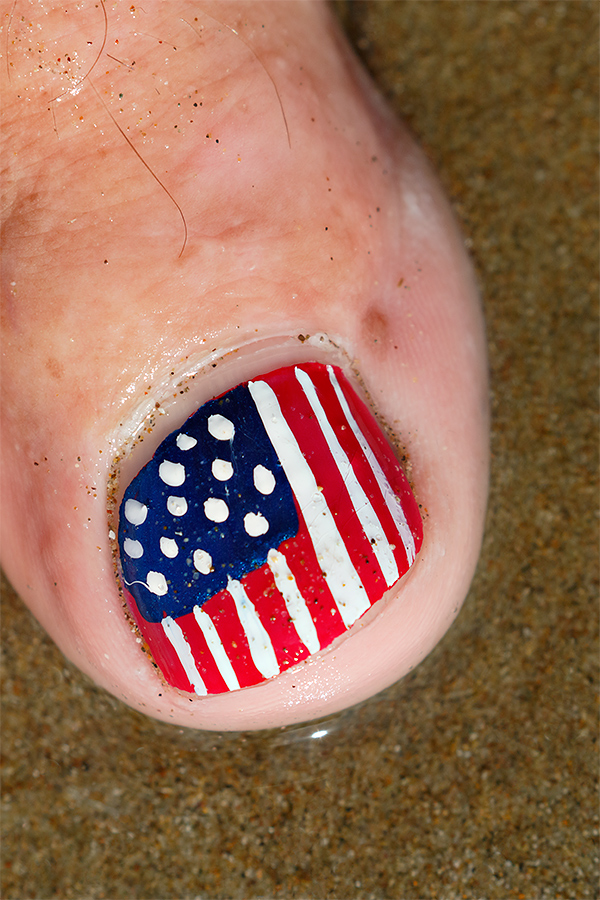
|
|
This image was created at Morro Bay (while standing) with the hand held Canon EF 100-400mm f/4.5-5.6L IS II USM lens, the Canon Extender EF 1.4X III (at 560mm), and the amazing Canon EOS 7D Mark II. ISO 400: Evaluative metering at zero: 1/640 sec. at f/11 in Av mode. Auto WB.
Center AF point (by necessity)/AI Servo Expand/Shutter Button AF as framed was active at the moment of exposure (as is always best when hand holding). The center AF point fell on a spot at the upper right center of the painted toe. Click on the image to see a larger version.
Image #1: Painted toenail in sun.
|
Thanks Chris!
Thanks a stack to multiple IPT veteran Chris Billman (US Air Force retired MEDEVAC technician) for posing his toe for me on the beach at Morro Bay.
Exposure Lesson
If I have said it once, I have said it 1,000 times, “When the sun is fully out, the camera’s meter is pretty darn smart. When the sun is not out at full strength, when it is cloudy, or when the subject is in the shade, the camera’s meter is pretty dumb….”
Image #1 was created in the sun at the metered exposure, 1/640 sec. at f/11. When I brought the image into DPP to convert it the highest WHITE RGB values were in the mid-230s, just where I prefer them. The meter was perfectly smart.
To create Image #2, I shaded Chris’s toe with my body. Working in Av mode still at f/11 I added 2/3 stop of light to the metered exposure and wound up at 1/100 sec. at f/11. What a difference? When I brought the image into DPP to convert it the highest WHITE RGB values were also in the mid-230s, just where I prefer them. In this case the meter was not as smart as it had been when the sun was out; I needed to add 2/3 stop of light to wind up with (pretty much) the same exposure.
A: How is your exposure math?
Same toe. Same lens. Same day. Same beach. How many stops difference in the two exposures, the one in the sun and the one in the shade?
|

|
|
This image was created at Morro Bay (while standing) with the hand held Canon EF 100-400mm f/4.5-5.6L IS II USM lens, the Canon Extender EF 1.4X III (at 560mm), and the amazing Canon EOS 7D Mark II. ISO 400: Evaluative metering at zero: 1/100 sec. at f/11 in Av mode. Auto WB. (Should have been Shade or at least Cloudy).
Center AF point (by necessity)/AI Servo Expand/Shutter Button AF as framed was active at the moment of exposure (as is always best when hand holding). The center AF point fell on a spot at the upper right center right near the edge of the painted nail. Click on the image to see a larger version.
Image #2: Painted toenail in shade.
|
100-400 II/1.4X III/7D II Close Focus
With its minimum focusing distance pretty much unaffected by the addition of the 1.4X II TC, the 100-400II/7D II offers amazing close focus of less than one meter, 3.2 feet. Even considering the focus breathing focal length issues, the magnification is quite amazing. Who would have ever though that we could photograph our (or a friend’s) single toe with an intermediate telephoto lens while standing? Not me for sure. This combo should kill with a variety of medium and large sized flowers, bugs, butterflies, and the like.
Lens Chart
Be sure to bookmark our Canon Lens Chart here.
B: Easy Question
If the recorded focal length (560mm) is the same for both images above, why is the toe considerably larger in the shaded version?
C: Another Easy Question
Why was it vitally important that AF be active at the moment of exposure for both images?
|
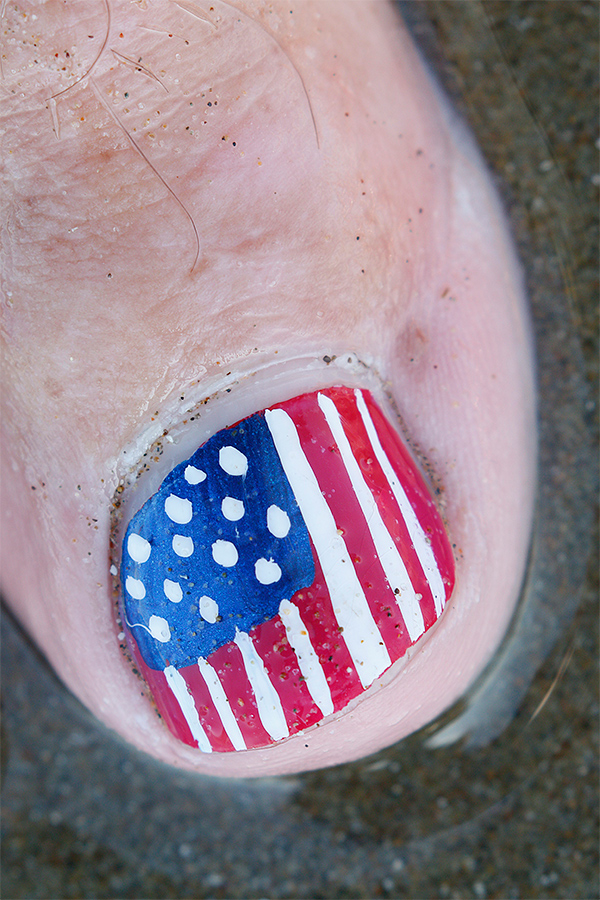
|
Image #3: this JPEG represents the much cooler (more BLUE) RAW file of the shaded toe image.
|
White Balance Issues
For image #1, created in the sun, AWB was fine. As noted above, using either Shade or Cloudy White Balance for image #2, the one where I shaded the toe with my body, would have been a good choice. (Note to flower photographers: shading the subject with your body or with a large card or diffuser on a sunny day is often an excellent strategy.) As you can see by looking at Image #3 immediately above, the RAW file has a BLUE cast as expected. Rather than deal with that in Photoshop I opted to to try the click White Balance dropper in DPP 4. When I did, I was amazed that the color now matched the color in Image #1 pretty much exactly. As I wanted it too look as if it were taken in the shade while eliminating most of the BLUE cast I used the Color Temperature slider. I was equally amazed that I needed to set 7500 K to come up with the cooler color that you see in Image #2.
The Lesson
As you can see there are lots of ways to deal with White Balance, with color temperature settings, and with color cast issues; they can be dealt with in the field, during conversion, or after conversion in Photoshop (the latter using one of many techniques). What is the best approach? Any of the above that give you color that pleases you; I call it matching the color space in my head. As is usual with digital, there are many ways to skin the same cat.
D: Which is Your Favorite Toe Color?
Which color rendition to you prefer, that of Image #1, Image #2, or Image #3.
E: Which of the three images do you like best?
Which of the three images do you like best, Image #1, Image #2, or Image #3? Be sure to let us know why.
Note: I like one of the three images best for color but I feel that one of the other two is the strongest image. I will share my thoughts with y’all in a future blog post.
|

|
|
Images and card design copyright 2014: Arthur Morris/BIRDS AS ART. Click on the card to enjoy a spectacular larger version.
|
Just One Slot Left!
The 2015 UK Puffins and Gannets IPT: June 29 through July 5, 2015: $5499: Limit 10 photographers/One opening due to a recent cancellation. Two great leaders: Denise Ippolito and Arthur Morris.
Here are the plans: take a red eye from the east coast of the US on 28 June arriving in Edinburgh, Scotland on the morning of Monday 29 June (or simply meet us then either at the Edinburgh Airport (EDI) or later in the day at our cottages if you are driving your own vehicle either from the UK or from somewhere in Europe. Stay 7 nights in two gorgeous modern country cottages.
There are 5 days of planned puffin/seabird trips—weather permitting, and 1 full day of gannet photography with 2 sessions on the boat.
|

|
|
Images and card design copyright 2014: Arthur Morris/BIRDS AS ART. Click on the card to enjoy a spectacular larger version.
|
The Details
We will be staying in upscale country-side cottages that are beyond lovely with large living areas and lots of open space for image sharing and Photoshop lessons. The shared rooms are decent-sized, each with two roomy single beds and a private bathroom. See the single supplement info below.
All breakfasts, lunches and dinners are included. All 5 puffins boat lunches will need to be prepared in advance, taken with, and consumed at your leisure. I usually eat mine on the short boat trip from one island to the other. Also included is a restaurant lunch on the gannet boat day and a farewell fine dining thank you dinner. The cost of your National Heritage Trust is also included; that covers the twice a day landing fees.
Plan to fly home on the early morning of Monday 6 July or to continue your stay or travels.
|

|
|
Images and card design copyright 2014: Arthur Morris/BIRDS AS ART. Click on the card to enjoy a spectacular larger version. Scroll down to join us in the UK in 2015.
|
Single Supplement Info
The single supplement is $1475. As we will be renting a third cottage the $1475 is due with your deposit and is also non-refundable.
If you are good to go please send your $2,000 deposit check now to save a spot. The balance will be due on March 29, 2015. Please make your check out to “Arthur Morris” and send it to Arthur Morris/BIRDS AS ART, PO Box 7245, Indian Lake Estates, FL, 33855. If you cancel and the trip fills, we will be glad to apply a credit applicable to a future IPT for the full amount less a $100 processing fee. If we do not receive your check for the balance on or before the due date we will try to fill your spot from the waiting list. Whether or not your spot is filled, you will lose your deposit. If not, you can secure your spot by paying your balance.
We do hope that you can join us.
Facebook
Be sure to like and follow BAA on Facebook by clicking on the logo link upper right. Tanks a stack!
Support the BAA Blog. Support the BAA Bulletins: Shop B&H here!
We want and need to keep providing you with the latest free information, photography and Photoshop lessons, and all manner of related information. Show your appreciation by making your purchases immediately after clicking on any of our B&H or Amazon Affiliate links in this blog post. Remember, B&H ain’t just photography!
…..
Amazon.com
Those who prefer to support BAA by shopping with Amazon may use this link:
Amazon Canada
Many kind folks from north of the border, eh, have e-mailed stating that they would love to help us out by using one of our affiliate links but that living in Canada and doing so presents numerous problems. Now, they can help us out by using our Amazon Canada affiliate link by starting their searches by clicking here. Many thanks to those who have written.
Typos
In all blog posts and Bulletins, feel free to e-mail or to leave a comment regarding any typos or errors. Just be right :).
April 4th, 2015 What’s Up?
Swim and ice bath. More IPT-related travel agent chores taken care of. Started working on second image edits for several trip folders; I need to get a ton of images transferred from my Apple 15.4″ MacBook Pro Notebook Computer with Retina Display (Mid 2014) to the office computer. Sent 79 e-mails by 8:43pm. This blog post took about 1 3/4 hours to prepare. It is scheduled to be published very early on Saturday morning. It will be the 87th straight day with a new educational blog post.
BAA Bulletin #473
BAA Bulletin #473 is online and can be accessed here.
- Is this Image Worth Optimizing?
- Date Change: St. Augustine Alligator Farm Short-Notice Spoonbill and Wading Bird Chicks IPT: May 4-6, 2015.
- 7D Mark II User’s Guide
- The Blog is the Bomb!
- Used Photography Gear for Sale
- BIRDS AS ART Instructional Photo-Tour (IPT) Info
- South Georgia October 2015
- Affiliate Stuff
Item 1 above,”Is this Image Worth Optimizing?” might very well be of interest to those who visit the blog regularly.
|
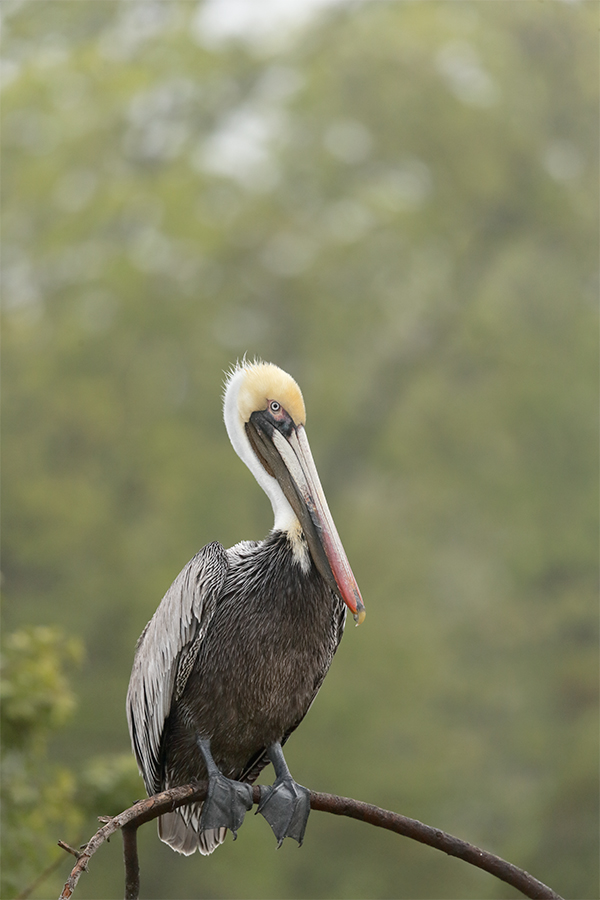
|
|
This image was created at Alafia Banks with the Canon EF 600mm f/4L IS II USM lens, the Canon Extender EF 1.4X III, and the Canon EOS-1D X . ISO 800. Evaluative metering +2/3 stop: 1/1250 sec. at f/5.6 in Av mode.
One AF point to the left of the center AF point/AI Servo Expand/Rear Focus AF as framed was active at the moment of exposure (as is always best when hand holding). Click here to see the latest version of the Rear Focus Tutorial. Click on the image to see a larger version.
Image #1: Brown Pelican, intentionally mis-framed to allow room for the hoped for head throw.
|
Puzzling Mystery
In the blog post here, I asked about the image above:
Why in the world would someone intentionally frame an image with the pelican so low in the frame? Can you come up with the number one reason? Or was this possibly simply a bad framing error?
See the next image for the answer….
|
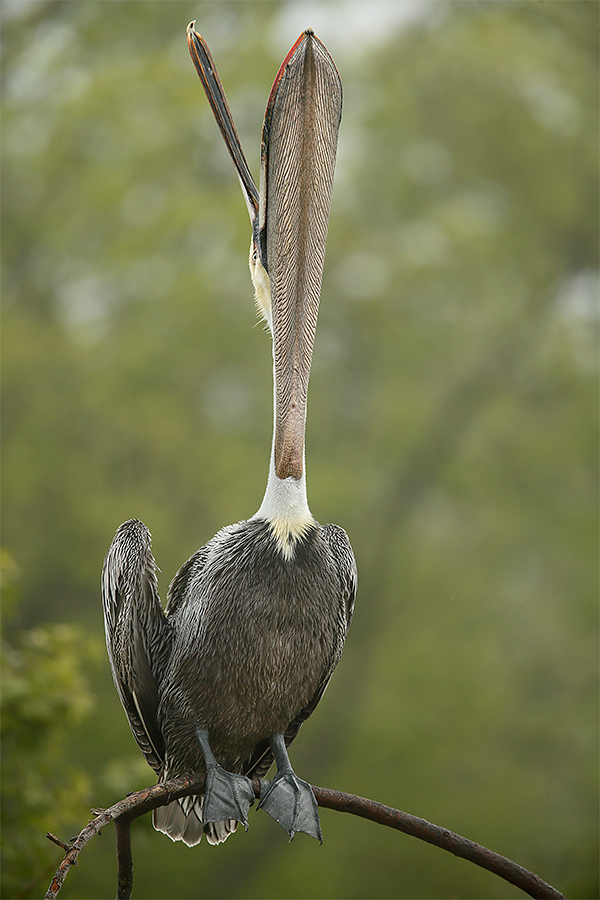
|
|
This image was created at Alafia Banks with the Canon EF 600mm f/4L IS II USM lens, the Canon Extender EF 1.4X III, and the Canon EOS-1D X . ISO 800. Evaluative metering +2/3 stop: 1/1000 sec. at f/5.6 in Av mode.
One AF point to the left of the center AF point/AI Servo Expand/Rear Focus AF as framed was active at the moment of exposure (as is always best when hand holding). It fell on the white band at the base of the neck. Click here to see the latest version of the Rear Focus Tutorial. Click on the image to see a larger version.
Image #2: Brown Pelican, fully extended head throw.
|
Just Barely In…
By pre-planning the image, I was just able to avoid clipping the pelican’s bill at the peak of the head throw. I made about 8 frames in a single sequence when the bird was close to full extension. The entire sequence was comprised of about 30 images all made in a very few seconds. I will share two more of those in a blog post soon.
How understanding one simple principle can improve your bird photography…
Here is the principle: bird behavior is often repetitive.
I liked this pelican from the get-go: a handsome bird on a pretty darn clean perch with a relatively distant background. Just what I look for. I added the teleconverter in an effort to create a striking full frame vertical portrait. When the bird did a head throw I was taken totally by surprise and was so tight that I did not even bother pressing the shutter button. But since I know that bird behavior is often repetitive, I simply moved back carefully. And then I moved back some more. And then I moved back a few more steps to the spot where I made the image above.
After about ten minutes my hunch and my patience paid off. And I did not even have to resort to praying….
When the bird began its head throw I pushed and held the shutter button for about 30 frames as noted above. For whatever reason or reasons, this was the sharpest of the eight frames that I created when the bird was near or at full extension.
Perspective Question
From Image #1 to Image #2 did I move to my right or to my left? How do you know?
|

|
|
All of the images in the bear boat card above were created in Katmai National Park during the month of September.
|
Bear Boat/Bears Catching Salmon IPT: September 1-8, 2015 from Kodiak, AK/6 FULL & 2 1/2 DAYS: $6699. Happy campers only! Maximum 8/Openings: 3. Plus the leader: Arthur Morris.
This trip is a go.
Join me in Katmai National Park, AK for seven days of photographing Coastal Brown Bears (grizzlies) catching salmon, fattening up for the long winter. Other subjects will include Mew and Glaucous-winged Gulls in flight and dip-feeding on salmon roe. Did I mention that we live on a boat and that the food is great? Most of our photography will be done in a variety of famed locations: Geographic Harbor, Kinak Bay, and Kukak Bay. We once had 39 bears fishing the creek at Kukak….
It is mandatory that you be in Kodiak no later than the late afternoon of August 31, 2015 September to avoid missing the float planes to the boat on the morning of September 1. With air travel in AK being what it is, with the chance of fog or other bad weather–being on Kodiak on August 30 is an even better plan). I will be on Kodiak on August 30 to avoid any potential disaster. That said in my nearly a dozen bear boat trips I was delayed only once but since I was day early as noted above there was no harm, no foul.
We will take one or more float planes to the boat mid-morning on September 1. We will photograph bears fishing that afternoon and every day for the next six days (weather permitting of course). We should have bears catching salmon every day. In addition, we will get some nice stuff on Mew Gull and Glaucous-winged Gulls dining on roe and the remains of predated salmon. We may–depending on where the concentrations of bears are–get to photograph Harbor seals and some hauled out Steller’s Sea Lions (an endangered species). Halibut fishing (license required) is optional. On September 8, our last morning on the boat, those who would like to enjoy one last photo session will do so. The group returns to Kodiak via float plane midday. Most folks will fly to Anchorage and then continue on red-eye flights to their home cities.
The eight days will consist of six full days (Sept 2, 3, 4, 5, 6, & 7) of photography featuring lots of Coastal Brown Bears catching salmon as above plus a variety of other natural history subjects plus some nice scenic photography that I forgot to mention above. Plus the first afternoon and the last morning.
What’s included? 8 DAYS/7 NIGHTS on the boat as above. All meals on the boat. (The food is quite excellent.) National Park fees. One night’s double occupancy lodging on Kodiak; arrive: Sept 1/depart: Sept 2. The thank-you-in-advance dinner on Sept 1. In-the-field photo tips, instruction, and guidance. An insight into the mind of a top professional; I will constantly let you know what I am thinking, what I am doing, and why I am doing it. Small group image review, image sharing, and Photoshop instruction on the boat.
What’s not included: Your round trip airfare to and from Kodiak, AK (almost surely through Anchorage). All necessary lodging other than the cost of your double occupancy room on the night of August 31 should you opt to arrive early–we can arrange that in advance for you. We will let you know the cost of a single supplement for the one night if so desired. The cost of the round-trip float plane to the boat on September 2 and back to Kodiak on September 9. The cost of a round trip this year was $500. The suggested crew tip of $210.
Is this an expensive trip? Yes, of course. But with 6 full and two half days, a wealth of great subjects, and the fact that you will be walking with the bears just yards away (or less….) it will be one of the great natural history experiences of your life. Most folks who take part in a Bear Boat IPT wind up coming back for more.
A $2,000 per person non-refundable deposit by check only made out to “Arthur Morris” is required to hold your spot. Please click here to read our cancellation policy. Then please print, read, and sign the necessary paperwork here and send it to us.
Your deposit is due immediately. That will leave a balance of $4699. The next payment of $2699 will be due on February 15, 2015. The final payment of $2000 is due on May 1, 2015.
I hope that you can join us for this wondrously exciting trip.
By e-mail from Bill Keown, veteran of three bear boat trips!
Hi Artie, What a great trip! With the exception of the one bright sunny day it was just great. Very different from my first trip in June where we only had the bears clamming; the fishing bears were amazing! As always I learned a lot and enjoyed the group immensely. All the Best, Bill
Facebook
Be sure to like and follow BAA on Facebook by clicking on the logo link upper right. Tanks a stack!
Support the BAA Blog. Support the BAA Bulletins: Shop B&H here!
We want and need to keep providing you with the latest free information, photography and Photoshop lessons, and all manner of related information. Show your appreciation by making your purchases immediately after clicking on any of our B&H or Amazon Affiliate links in this blog post. Remember, B&H ain’t just photography!
…..
Amazon.com
Those who prefer to support BAA by shopping with Amazon may use this link:
Amazon Canada
Many kind folks from north of the border, eh, have e-mailed stating that they would love to help us out by using one of our affiliate links but that living in Canada and doing so presents numerous problems. Now, they can help us out by using our Amazon Canada affiliate link by starting their searches by clicking here. Many thanks to those who have written.
Typos
In all blog posts and Bulletins, feel free to e-mail or to leave a comment regarding any typos or errors. Just be right :).
April 3rd, 2015 What’s Up?
The usual. This blog post took about 2 1/4 hours to prepare including the time spent on the three image optimizations. It is scheduled to be published very early on Friday morning. Today marks 86 straight days with a new educational blog post.
South Georgia October 2015
Do consider joining me in South Georgia next October for the trip of a lifetime. Click here for complete details.
Please Remember to use our Affiliate Links 🙂
To show your appreciation for my continuing efforts here, we ask, as always, that you use our the B&H and Amazon affiliate links on the right side of the blog for all of your purchases. B&H is recommended for you major photography gear purchases, Amazon for your household, entertainment, and general purpose stuff. Please remember: no phone orders: web orders only!
Please check the availability of all photographic accessories in the BIRDS AS ART Online Store, especially the Mongoose M3.6 tripod heads, Gitzo tripods, Wimberley heads and plates, LensCoats and accessories, and the like. We sell only what I have used, have tested, and can depend on. We will not sell you junk. We know what you need to make creating great images easy and fun. And we are always glad to answer your gear questions via e-mail.
I would of course appreciate your using our B&H affiliate links for all of your major gear, video, and electronic purchases. For the photographic stuff mentioned in the paragraph above we, meaning BAA, would of course greatly appreciate your business. Here is a huge thank you to the many who have been using our links on a regular basis and visiting the BAA Online store as well.
|
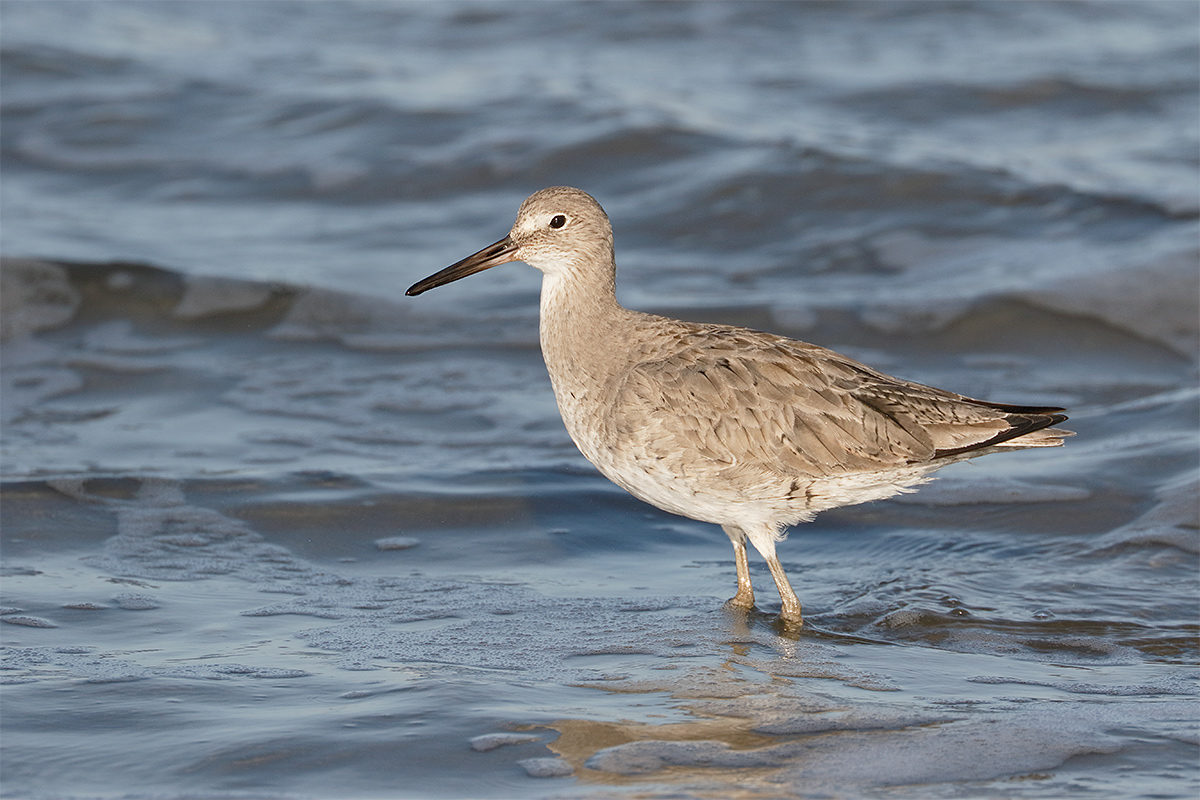
|
|
This image was created at Morro Bay (while standing) with the hand held Canon EF 100-400mm f/4.5-5.6L IS II USM lens, the Canon Extender EF 1.4X III (at 490mm), and the amazing Canon EOS 7D Mark II. ISO 400: 1/1600 sec. at f/9 confirmed via histogram.
Center AF point (by necessity)/AI Servo Expand/Shutter Button AF as framed was active at the moment of exposure (as is always best when hand holding). The center AF point was on the side of the bird’s breast well forward of the bend of the wing. Click on the image to see a larger version.
Image #1: Willet in surf.
|
Why the 1.4X?
Near the end of my great Morro Bay trip I realized that I had not made any images of single Willet. Why? For unknown reasons, this species in California is a lot more skittish than it is in Florida in winter. The solution? Add the 1.4X III TC to the mix to give me 560mm. With the 1.6 crop factor I enjoyed effective 896mm at the max. With active birds feeding in the shallow surf you will need to have AF active and find a spot with a bit of contrast so that AF holds well.
As you are working at f/8 with this set-up you will be limited to choosing the central AF point only. Be sure to hit the grid button once to add the four expand points to give you a bit more compositional freedom. When I have sufficient light as I did in this situation I will almost always work at f/9 for a bit of extra sharpness. The placement of the active AF point had the sensor pretty much on the same plane as the subject’s eye just as we want.
I warped the wave-let that nearly intersected the tip of the bird’s bill and then refined that Quick Mask with a Layer Mask. Additional clean-up there was with the Clone Stamp Tool. Finally, to smooth things over, I painted a Quick Mask of the messy area, applied a Gaussian Blur, and reduced the opacity. I painted the area where the bill had been softened by the blur back in with a Regular Layer Mask. The difference was dramatic.
|
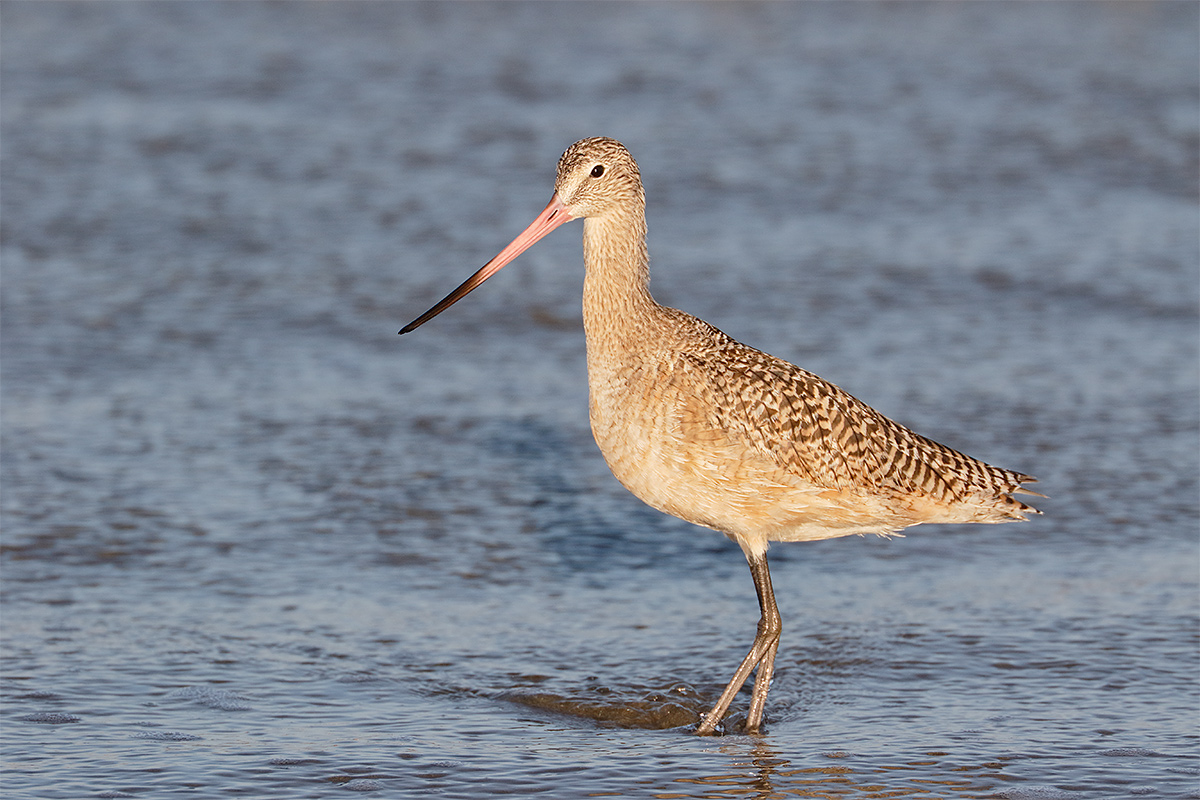
|
|
This image was created at Morro Bay (while standing) with the hand held Canon EF 100-400mm f/4.5-5.6L IS II USM lens, the Canon Extender EF 1.4X III (at 490mm), and the amazing Canon EOS 7D Mark II. ISO 400. Evaluative metering +1/3 stop: 1/1250 sec. at f/9.
Center AF point (by necessity)/AI Servo Expand/Shutter Button AF as framed was active at the moment of exposure (as is always best when hand holding). The center AF point was on the center of the bird’s breast directly below the bird’s eye, just a bit forward of and a bit lower than it was in the opening image. Click on the image to see a larger version.
Image #2: Marbled Godwit in surf.
|
More of the same with a twist…
Here, I made sure to have the active AF point a bit lower on the bird’s breast to be sure that I did not clip the godwit’s feet. Notice that with the center AF point on the bird’s breast that there is about 2 1/2 times more room from the bill tip to the left frame edge than from the tip of the tail to the right frame edge. Just as in the Willet image that opened this post. In nearly all cases you will want two to four times more room in front of the bird than behind it…. If the distance from the bill tip to the frame edge is the same as the distance from the tail tip is the same your bird will be centered and in nearly all cases, the composition will be both static and boring.
|
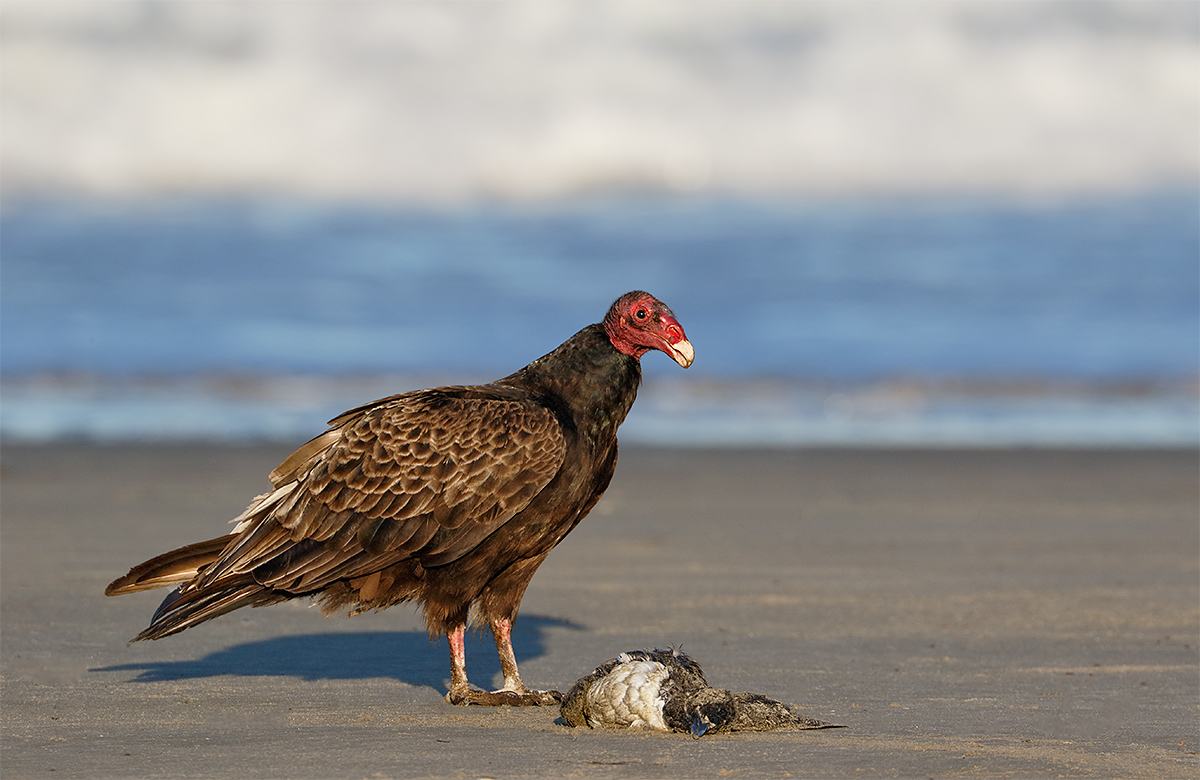
|
|
This image was created at Morro Bay with the hand held Canon EF 100-400mm f/4.5-5.6L IS II USM lens, the Canon Extender EF 1.4X III (at 560mm), and the amazing Canon EOS 7D Mark II. ISO 400. Evaluative metering +2/3 stop as framed: 1/640 sec. at f/9.
Center AF point (by necessity)/AI Servo Expand/Shutter Button AF as framed was active at the moment of exposure (as is always best when hand holding). The center AF point was right on the bird’s neck. Click on the image to see a larger version.
Image #3: Turkey Vulture with seabird carcass
|
On the ground…
I got down flat in the sand and crawled up on this bird in early morning light as I had noticed that they did not at all like people approaching them. I rested my left forearm on the beach and made sure to have AF active at the moment of exposure to ensure a sharp image of a relatively distant subject. Here I was working at the max, effective 896mm.
As the beach was somewhat of a mess optimizing this image involved lots of work with the Clone Stamp Tool, the Patch Tool, and the Spot Healing Brush.
Summing Up
When using a 1.4X TC on an f/5.6 lens you are limited to the center AF point only; when hand holding you need to place the active AF point on a spot on the bird that will render the bird’s eye razor sharp. As you will almost never be happy with the image design if you blindly place the active AF point on the bird’s eye, you need to put your thinking cap on and be creative when making this decision….
Making sharp images of moving birds with the 100-400II/1.4X III TC/7D II combo requires both attention to detail (as immediately above) and some degree of skill. For static subjects, the use of a tripod and a Mongoose M3.6 is strongly recommended. Remember that if you are using rear focus or focus lock, or even One-Shot AF, it is imperative that your rig not be moved even a fraction of a millimeter after focus has been set. The movement that results from just breathing is more than enough to throw off AF….
Your Favorite?
Please take a moment to let us know which of today’s three images is your favorite, and why.
The Image Optimizations
The RAW files for all three of today’s images were of course converted in DPP 4 and optimized in Adobe Photoshop Creative Cloud.
Digital Basics
Everything that I did to optimize today’s images is covered in detail in our Digital Basics File–written in my easy-to-follow, easy-to-understand style. Are you tired of making your images look worse in Photoshop? Digital Basics File is an instructional PDF that is sent via e-mail. It includes my complete digital workflow, dozens of great Photoshop tips, details on using all of my image clean-up tools, the use of Contrast Masks, several different ways of expanding and filling in canvas, all of my time-saving Keyboard Shortcuts, Quick Masking, Layer Masking, and NIK Color Efex Pro basics, Contrast Masks, Digital Eye Doctor techniques, using Gaussian Blurs, Tim Grey Dodge and Burn, a variety of ways to make selections, how to create time-saving actions, the Surface Blur (background noise reduction) settings, and tons more.
APTATS I & II
Learn the details of advanced Quick Masking techniques in APTATS I. Learn Advanced Layer Masking Techniques in APTATS II. Mention this blog post and apply a $5 discount to either with phone orders only. Buy both APTATS I and APTATS II and we will be glad to apply at $15 discount either with phone orders or here in the BAA Online Store. For phone orders, call Jim or Jennifer at 863-692-0906 weekdays.
|

|
|
You can order your copy of “The Photographers’ Guide to Canon Digital Photo Professional 4.0” (aka the DPP 4 Raw Conversion eGuide) by Arash Hazeghi and Arthur Morris by clicking here.
|
The DPP 4 eGuide (PDF)
Learn how and why I and many other discerning photographers choose and use only DPP 4 to convert their Canon RAW files in the DPP 4 RAW Conversion Guide by Arash Hazeghi and yours truly. The latest version supports all of the newer Canon camera bodies and several older models including the EOS-7D and the EOS-1D Mark IV. A free update that will cover most of the newly added cameras will be sent in a week or two. See upcoming blog posts for exact details.
|

|
|
Clockwise from upper left to center: Snowy Egrets/breeding plumage pair, American Alligator with egret feather on head, Cattle Egret in breeding plumage (with fill flash), large Snowy Egret chicks, displaying gator, Wood Stork in flight carrying nesting material (fill flash), begging Snowy Egret chick, another Cattle Egret in breeding plumage (with fill flash), and Great Egret chick.
|
Date Change: St. Augustine Alligator Farm Short-Notice Spoonbill and Wading Bird Chicks IPT: May 4-6, 2015.
St. Augustine Alligator Farm Short-Notice Spoonbill and Wading Bird Chicks IPT: May 4-6, 2015. TWO FULL and TWO 1/2 DAYS: $1099. Limit 8/Openings 5.
St. Augustine in early May is a bird photographer’s paradise. With any luck we should have chicks of all sizes in the nests ranging from newly hatched Snowy Egrets and Tricolored Herons to nearly fledged Great Egrets. More than a few pairs of Roseate Spoonbills have nested at the Alligator Farm for the past several years. Photographing the spoonbill chicks in the nest is a huge challenge…. With any luck we will encounter a few Snowy and Cattle Egrets in stunning breeding plumage. We should have lots of flight photography ops especially late in the day. We will enjoy extra early entry on our three mornigs. Folks who will need a photographer’s pass ($89.95 includes full season early entry and late stay and submission fees for up to 5 photos in their annual contest; this works out to cheaper than four separate entry tickets). We will have those ready for pick-up on the first afternoon.
|

|
|
Clockwise from upper left: flash-as-main light Great Egret chick begging, breeding plumage Cattle Egret w/fill flash, Little Blue Heron, Great Egret chick in nest begging, Cattle Egrets copulating, Wood Stork with nesting material, another Wood Stork with nesting material, and breeding plumage Snowy Egret displaying.
|
What You Will Learn
On this IPT you will the learn the basics and fine points of digital exposure and how to get the right exposure every time after making a single test exposure. You will learn to understand and predict bird behavior and to see and understand the light. You will learn to design pleasing images by mastering your camera’s AF system and how and why to work in Manual mode (even if you’re scared of it). Most importantly, you will learn to spot the good situations, to choose the best perspective. Rookeries are crowded, cluttered, white-washed places. Most folks who visit have no clue as to the difference of an image with tons of distractions and one with a clean line of sight and the best possible distant background. Join me and I will teach you to see like a pro.
I will be bringing my flash to the Alligator Farm (gasp!) I have not used flash for at least a year. I will be teaching you how to use flash as fill and how to use flash as main light. In addition, I will be reviewing the flash flight techniques that I developed at St. Augustine more than a few years ago.
|

|
|
Clockwise from upper left: gator back, Great Egret returning to mate (with fill flash), Roseate Spoonbill with bill open, Roseate Spoonbill chick begging, Roseate Spoonbill 11am silhouette, large Great Egret chicks in nest, and bill of Roseate Spoonbill.
|
Whats the Rest of the Deal?
Afternoon session on Monday, May 4. Then two full days with a morning and afternoon session each day, May 5 & 6. Then our last morning on May 7. At lunch on Tuesday and Wednesday (included) we will review my images; folks learn a ton watching me edit–why keep this one and delete that one? If you opt to bring your laptop, we can take a look at five of your best images from the morning or another session. We will process a few of my images in Photoshop after converting them in DPP. That followed by Instructor Nap Time.
A $499 non-refundable deposit is required to hold your spot. Your balance–$600, payable only by check, is due immediately. Please include a separate check for $89.95 so that we can purchase your pass in advance. Please click here to read our cancellation policy before committing. Then please print, read, and sign the necessary paperwork linked to here and get it to us. You can register by calling Jim or Jen at the office at 863-692-0906 and arranging for your deposit of $499. Balances are payable only by check. I hope to see you there.
Facebook
Be sure to like and follow BAA on Facebook by clicking on the logo link upper right. Tanks a stack!
Support the BAA Blog. Support the BAA Bulletins: Shop B&H here!
We want and need to keep providing you with the latest free information, photography and Photoshop lessons, and all manner of related information. Show your appreciation by making your purchases immediately after clicking on any of our B&H or Amazon Affiliate links in this blog post. Remember, B&H ain’t just photography!
…..
Amazon.com
Those who prefer to support BAA by shopping with Amazon may use this link:
Amazon Canada
Many kind folks from north of the border, eh, have e-mailed stating that they would love to help us out by using one of our affiliate links but that living in Canada and doing so presents numerous problems. Now, they can help us out by using our Amazon Canada affiliate link by starting their searches by clicking here. Many thanks to those who have written.
Typos
In all blog posts and Bulletins, feel free to e-mail or to leave a comment regarding any typos or errors. Just be right :).
|
|


